Swiss Travel Pass: First Class Vs Second Class

If you are looking at the Swiss Travel Pass for your next journey through Switzerland, then you likely already know most of the great benefits . Free travel all over Switzerland on all forms of transport, save for mountain excursions (where there are big discounts).
However, if you are wondering whether paying for first class makes any sense, then let me break it all down for you.
Table of Contents

On Trains – 1st Class vs 2nd Class

You will be spending most of your time traveling in Switzerland on trains. So, this section is probably the most important to you when you have a Swiss Travel Pass .
The main differences between first and second-class trains in Switzerland are:
- Space – seats are bigger, and more spaced out
- Comfort – seats are generally more plush & comfortable
- Working – there is more space to work on a table with power outlets nearby
- Less crowded – lots more free seats any time of day
- Quieter – fewer people means less noise and it’s easier to relax/sleep
- Photos – When there are fewer people you can move around and take pictures more easily
Panoramic Trains – Glacier Express etc
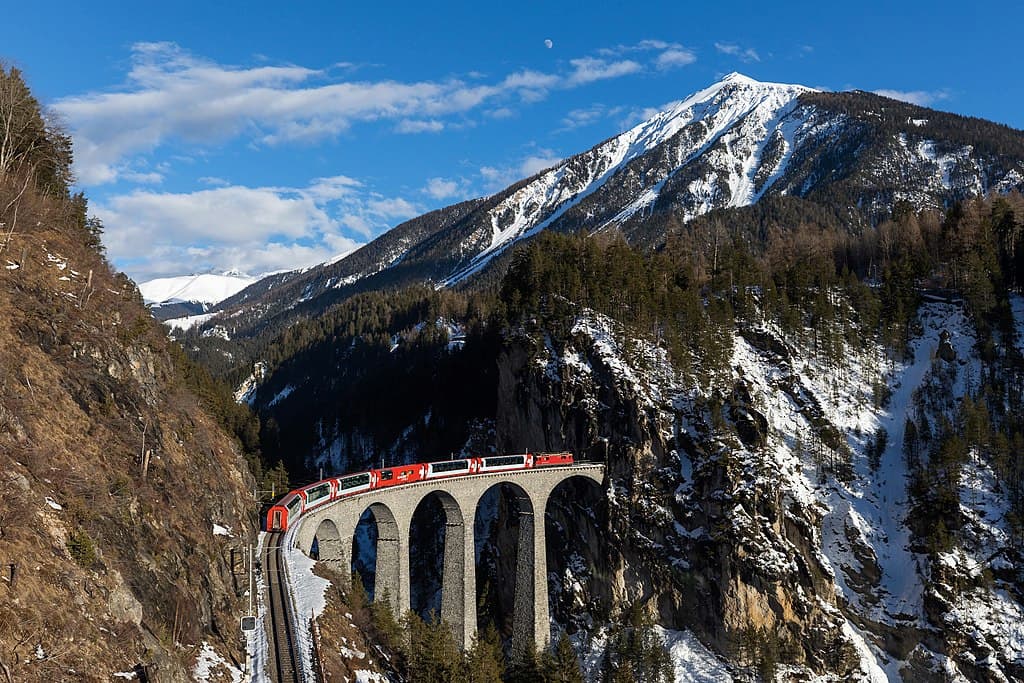
Another place where first-class trains can make a big difference is when you make a journey on a route like the Glacier Express.
With these trains, it is all about the experience and on the Glacier Express you get seating configurations of two on one side and one on the other. This means that if you are alone, or just two of you, you can isolate yourself by a lovely large window!
In second class, it is two on the other side of the aisle, so there is no guarantee you will get a window seat or have the area to yourself.
Related Reading
Swiss travel pass vs half fare card, first class is great when trains are busy.
You might be asking yourself if it is worth it because all Swiss trains are comfortable and spacious, and that is certainly true. But when things get busy, you will be fighting for a seat, looking for a seat, struggling to stow your luggage and a lot more challenges.
The difference between the classes is not as big as on a flight from the USA to Europe, but when a train is busy you will appreciate the space, quiet, and chance of a seat.
When does it get busy? Early in the morning, late in the afternoon (commuter times) and on Friday afternoons/weekends (Swiss love to use their trains for weekend trips). During these times it can be stressful to ride on any train in Switzerland, even with a Swiss Travel Pass .
I often upgrade when things get busy, which is another option. But you need to remember to do it, otherwise, you will get a fine.
On Boats – First vs Second Class

One of the great things about public transport in Switzerland is the boats on the lakes. Not only are they a great way to get around, but they also make for a fun day trip.
One such place where they are even better is on Lake Lucerne. Here you can ride historic steamships across the river and then take a mountain railway up a mountain once you arrive.
If you have second class, you are confined to the lower more crowded deck and usually cannot go outside.
If you have first class, you are allowed on the upper deck where it is far less crowded and you can sit outside.
Where To Buy The Swiss Travel Pass
Class upgrades.
On all Swiss public transport, you can always choose to “upgrade” to first class on just one leg of your journey. So, if the price of first class is still out of your reach, you can choose to do it for one or two particular journeys.
Just head to the ticket office before your journey (or on the boat is an option) and ask for a class upgrade for your trip.
Another thing to consider if you are staying in Switzerland for a long time is whether to use a half-fare card instead of a Swiss Travel pass.
More On The Swiss Travel Pass
General information, scenic trains, mountain trips, pass comparisons, plan your trip to switzerland.
Leave a Reply Cancel reply
Your email address will not be published. Required fields are marked *
Get Our Free Swiss Tips Guide
Popular destinations, important pages, on social media, travel planning, certified swiss travel expert.

Navigate to myswitzerland.com
Destinations
Your swiss holiday time.
Holiday destinations
- Summer holiday destinations
- Winter sports & ski resorts
- Family destinations
Attractions
- Top attractions
- UNESCO World Heritage sites / biospheres
- Travel by train, bus or boat
- Top museums
- Swiss Parks
- Scenic nature
Experiences
Additional content about subnavigation experiences.
- Family excursions
- Food & Wine
- Group excursions
- Guided tours
Summer & Autumn
- Bicycle & Mountain bike
- Adventure & Sports Summer
- Zoo & animal experiences
- Ski and snowboard
- Cross-country skiing
- Snowshoe and winter hiking
- Tobogganing
- Winter excursions
- Christmas in Switzerland
Cities & culture
- Parks, Gardens and Squares
- Architecture
Experience Tour
- Car, motorcycle - Grand Tour
- Train, bus, boat – Grand Train Tour
- Mountain excursions
Accommodation
- Typically Swiss Hotels
- Wellness & Spa
- Family Hotels
- Bike Hotels
- Boutique Hotels
- Inspiring Meeting Hotels
- Swiss Historic Hotels
- Luxury hotels
- Winter sports hotels
Other types of accommodation
- On the farm
- Bed and Breakfast
- Mountains huts
- Group accommodation
Transport & Stay
- Travel to Switzerland
- Barrier-free travel
- Tickets public transport
- Service & support
- Money and shopping
About Switzerland
- General facts
- Custom and tradition
- History of Switzerland
- The Swiss Art and Culture Scene
- Health Travel
- Sustainability
Weather & Climate
- Climate in Switzerland
- Snow Report
- Water and pool temperatures
- City offers
- Touring offers
- Wellness offers
- Nature and outdoor offers
- Offers for families
Where are you from?
- België (Nederlands)
- Belgique (Français)
- Deutschland
- Netherlands
- Russia (Россия)
- Schweiz (Deutsch)
- Suisse (Français)
- Svizzera (Italiano)
- Switzerland (English)
- United Kingdom
- Canada (English)
- Canada (Français)
- China 中文简体
- China 中文繁体
- Gulf countries العربية
- Japan 日本
- Korea 한국어
- United Arab Emirates
- New Zealand
- International
Language, region and important links
- Slovenština
Service Navigation
- Help & Contact
Swiss Travel Pass
Exploring Switzerland has never been easier! For foreign guests, the all-in-one ticket Swiss Travel Pass is the key to Switzerland’s public transport network.
All Swiss Travel Passes
This single ticket enables visitors to explore Switzerland from end to end by train, bus and boat on 3, 4, 6, 8 or 15 consecutive days. With the Swiss Travel Pass Youth, young people up to their 25th birthday travelling through Switzerland benefit from a 30% discount off the regular Swiss Travel Pass ticket fare.
- Unlimited travel by train, bus and boat. View area of validity
- Unlimited travel on premium panoramic trains (seat reservation fees and/or surcharges apply).
- Unlimited use of public transport in more than 90 towns and cities.
- Free admission to more than 500 museums .
- Mountain excursions included: Rigi , Stanserhorn and Stoos
- Up to 50% discount on many other mountain excursions.
- Up to 30% discount on SBB RailAway offers. Available at all ticket counters within Switzerland.
- Children from their 6th up to their 16th birthday accompanied by at least one parent (holding a Swiss Travel System ticket) travel free of charge with the complimentary Swiss Family Card .
- Children under 6 years of age who are accompanied by a holder of a valid Swiss Travel System ticket travel free of charge.
- The Swiss Travel Pass is available as e-ticket.
Information
- A seat reservation and/or supplement is required to travel on some trains/buses/boats such as Glacier Express, Bernina Express, Gotthard Panorama Express and Palm Express.
- Swiss Travel System tickets are available to persons with residence outside Switzerland and the Principality of Liechtenstein
- In Switzerland, fares apply in Swiss Francs as detailed in the chart (in case of cash payment in EUR, USD or GBP: current exchange rates apply)
General provisions and legal information
Price – adult.
Consecutive travel days
Price – Youth
Valid for young travellers up to their 25th birthday (30% discount)
Swiss Family Card
With the Swiss Family Card , children from their 6th up to their 16th birthday travel free of charge.
On request, a Swiss Family Card is provided free of charge, entitling children from their 6th up to their 16th birthday to travel free if accompanied by at least one paying parent.
Bonus Benefits with the Swiss Travel Pass
Regional passes, sales outlet swiss travel system.
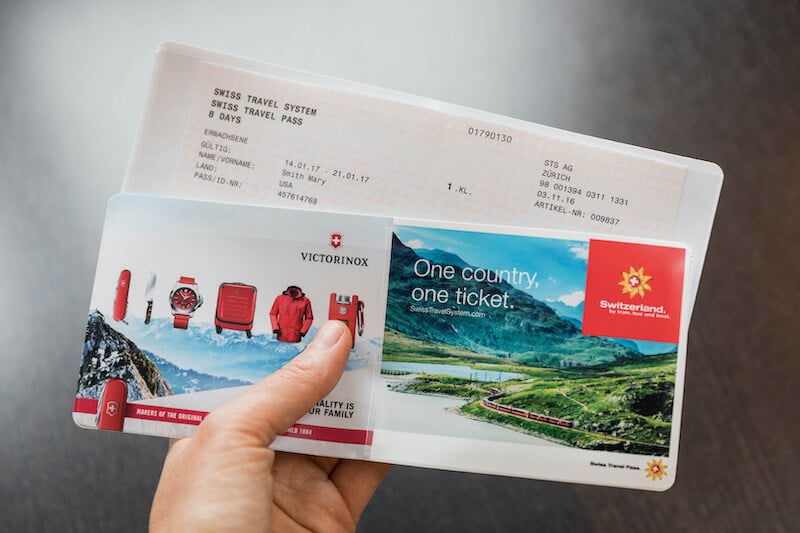
How to Buy, Activate and Use the Swiss Travel Pass
The Swiss Travel Pass is an all-in-one transport pass that makes it easier and more affordable to travel around Switzerland, where the public transport system is renowned for its efficiency.
Also sometimes referred to as the Swisspass, Swiss Train Pass or Swiss Pass, the pass is valid for various durations.
It even gives holders access to discounted travel on many mountain railways and cable cars as well as trains, buses and boats.
Now you have decided to purchase the Swiss Travel Pass, where do you buy it? When and how can you activate it? And how do you actually use the Swiss Travel Pass?
In this guide we cover everything you need to know before setting off on your travels around the incredible country of Switzerland.
From how to buy the Swiss Travel Pass and whether or not your type of pass needs activating to how to use your pass on the go, this article covers it all.
[ This post may contain compensated links. Please see my disclosure policy for more information. ]
What's in this Article
Where to buy the Swiss Travel Pass
Let’s get started by taking a look at where you should buy your pass.
First, you need to decide whether to purchase a regular Swiss Travel Pass (for travel on consecutive days) or a Swiss Travel Pass Flex. The differences are explained in > this article.
Then it’s super simple to purchase a Swiss Travel Pass. I recommend you buy the pass via GetYour Guide , an authorised reseller of Swiss Travel System.
What’s great about using GetYourGuide is that they offer full refunds on many products, including the Swiss Travel Pass, if you cancel up to 24 hours before use.
Consecutive Day Swiss Travel Pass Prices
Swiss Travel Pass Flex Prices
How to buy your Swiss Travel Pass step-by-step
The GetYourGuide site is also really user-friendly. After clicking the link to purchase your pass ( this link for the consecutive day pass and this link for the Flex pass ), the first step is to choose how many adults, youths (aged 16 to 25) and children (aged 6 to 15) are travelling.
This can be done directly beneath ‘About this activity’. Kids aged 5 or under don’t need a ticket or a pass, as they travel for free.

Next, select the start date you want: you can skip through months here by clicking the arrow on the top right.
Then, when you have selected the date you will first use your pass, click on ‘Check availability’.

Now you can choose the pass you’d like to buy.

Add the pass you want to your cart.

📍 I recommend double checking at this point that you have selected the right class of travel and duration.
Then click ‘Checkout’.
Next it’s just a case of adding your billing details as with any online purchase.
You’ll also be asked to complete the full names and dates of birth for each traveller. Make sure these match your passports exactly to prevent any problems later on.

How you’ll get your Swiss Travel Pass
Once you have made your purchase, when and how is your pass delivered?
The Swiss Travel Pass (for travel on consecutive days) will be emailed to the address you provided in the booking process, and will come in the form of a PDF attachment which can be downloaded to your mobile device.

I highly recommend printing a paper copy of this as a back-up, though you can simply present the mobile version when using transport in Switzerland.
While both paper and digital versions of the pass are accepted, your phone could suddenly run out of battery and then you’d have no way of proving you have a pass!
You should also carry your passport or another form of photo ID each time you travel.
> Click here to buy your Swiss Travel Pass
How you’ll get your Swiss Travel Pass Flex
If you purchase a Swiss Travel Pass Flex, you will receive a purchase receipt and a voucher by email.
The voucher is NOT valid for travel.
Each day you wish you travel you should activate your pass (see the instructions below). By doing this, you will receive a valid ticket for travel on that date.

> Click here to buy your Swiss Travel Pass Flex.
When and how to activate the Swiss Travel Pass
There is often confusion about whether or not a Swiss Travel Pass has to be activated. The answer varies according to the type of pass you’ve bought so follow the instructions below to learn how to activate your Swiss Travel Pass.
Activating your Swiss Travel Pass (consecutive days)
The regular, consecutive days Swiss Travel Pass does not need to be activated. All you need to do is show it to the ticket inspector when requested.
Activating your Swiss Travel Pass Flex
The Swiss Travel Pass Flex, however, must be activated in advance and before each day that you use the pass. You can do this via Activate Your Pass here .

Your pass should be activated before your first trip, and you’ll need to enter your reference number as well as your full name and date of birth.
For every travel date you activate, a valid ticket will be generated. This e-ticket can then be seen at activateyourpass.com . You can show this e-ticket to the ticket inspector on your phone or tablet, or use a printed copy.
What if your plans change along the way?
If you have already activated a travel date that you want to change, the Swiss Travel Pass allows you to change these as much as you want to until the start of each validity period.
The validity period commences at 23:59. Once the clock hits midnight, you can no longer change or deactivate this particular ticket.
For example, if you have activated your Swiss Travel Pass Flex to be used on 17 July and you no longer wish to use your pass that day, you can change the date of travel until 23:59 on 16 July.

How to use the Swiss Travel Pass
So now let’s cover how to use the Swiss Travel Pass Flex or consecutive-days pass.
When travelling with a Swiss Travel Pass – either consecutive days or Flex, you simply board the train and sit wherever you wish in the correct carriage for your class of travel.
The only exception to this is when travelling on the Bernina Express or Glacier Express, which we cover below.
When requested by the ticket inspector, simply present your Swiss Travel Pass. You may also be asked to present some photo ID, such as your passport to verify that you are the pass holder.

Using the Swiss Travel Pass on panoramic trains
The Bernina Express and Glacier Express , two of Switzerland’s most famous premium panoramic trains, are the only Swiss trains on which reserving a seat is compulsory.
The actual ticket price of the journey on these trains is covered by the Swiss Travel Pass but seat reservation fees are compulsory and should be purchased online well in advance of your travel date.
Seat reservations for the Bernina Express can be purchased here and Glacier Express seat reservations can be purchased here .
On all other panoramic trains* – Luzern – Interlaken Express, GoldenPass Line and Gotthard Panorama Express – seat reservations are not required. Simply board the train and sit anywhere in the correct carriage for your class of your travel.
*Note that the Gotthard Panorama Express only offers 1st class train travel. If you hold a 2nd class Swiss Travel Pass or Swiss Travel Pass Flex you must pay a class upgrade for this journey.
Additionally there is a compulsory supplement of CHF 16 for each passenger that travels on the Gotthard Panorama Express. > Purchase class upgrades and the compulsory supplement here .

Using the Swiss Travel Pass on buses, boats and mountain transport
Don’t forget that Swiss Travel Pass holders can also use boats, buses and some mountain transport services. Even when this isn’t the case, you may qualify for a generous discount as a pass holder.
When boarding boats and buses, simply show your Swiss Travel Pass when you enter. For free (where applicable) or discounted travel on cable cars, funiculars and mountain railways, present your pass at the ticket counter.
Selected museums also allow pass holders to enter for free. Just show your Pass at the ticket counter.

Travelling beyond the Swiss border with a Swiss Travel Pass
When travelling to an area beyond that covered by the pass – such as into another country – you’ll need to buy a ticket for that sector. This will apply, for example, to journeys into France, Italy, Germany or Austria.
International tickets are generally not available for purchase on the Swiss Railways website or app so we recommend buying them from the railway of the country concerned.
The Swiss Travel Pass covers travel as far as the major rail border points of Basel and Le Chatelard-Frontiere on the French border, Chiasso on the Italian border, Konstanz on the border with Germany and St. Margrethen on the Austrian border.
Some postal bus services within Liechtenstein and Austria are also covered by the Swiss Travel Pass.
You can view a map of the Area of Validity of the Swiss Travel Pass > here .
The SwissPass app
Is there a Swiss Travel Pass app? No, there isn’t.
Many travellers notice a reference to the SwissPass on the SBB Mobile app however this refers to a digital travel account for residents only.
A SwissPass account is for Swiss citizens only, not tourists, and is a separate product that uses a chip and pin card.
The Swiss Travel Pass doesn’t have to be added to an app. All you need is to be able to show the ticket inspector a paper or digital copy, and photo ID if requested.
The excellent SBB Mobile app ( which we explain here ) can be used for checking timetables but it is not necessary (or possible) to connect your Swiss Travel Pass to the app.
Another app that is useful is the Swiss Travel Guide app which has an integrated map and timetable and points out more than 500 Swiss highlights.
Planning a trip to Switzerland? At Holidays to Switzerland we are passionate about sharing our love of Switzerland and helping you to plan the perfect trip. Read our guide to planning a trip to Switzerland to kick start your travel plans and join our free Switzerland Travel Planning group on Facebook to chat with other past and future travellers. Want monthly news and podcast updates, helpful travel tips and special deals sent straight to your inbox? Subscribe to Holidays to Switzerland and we’ll send you a bonus copy of our 10 Useful Things to Know Before You Visit Switzerland guide. 🇨🇭 Check out our exclusive discount offers and save on your Swiss vacation. 🇨🇭
Buying, activating and using the Swiss Travel Pass summary
The Swiss Travel Pass allows you to use the clean, fast and efficient public transport system in Switzerland. It can be used on trams, buses and boats as well as trains, and can save you a lot of time and money. Exclusive free entry to museums and generous discounts can also apply.
Buying your pass is easy, and purchasing it through our preferred supplier means you won’t even lose money if your plans change, as long as you cancel 24 hours before the start date.
Only the Swiss Travel Pass Flex requires activation, which is easy to do via this link .
Once you have your chosen pass, I recommend taking a paper copy as well as the digital version as back-up. Also carry your passport or other photo ID in case it’s requested.
Unless you want to travel on the popular scenic Swiss train routes, seat reservations are not normally required.
Wherever your Swiss Travel Pass takes you, I’m sure you’ll fall in love with beautiful Switzerland and will want to return time and time again!

How to Buy, Activate and Use the Swiss Travel Pass – Summary
Now that you have read this guide, you can confidently buy, activate (if necessary) and use your Swiss Travel Pass.
This all-in-one transport pass is the perfect hop on hop off ticket for travelling in Switzerland.
🇨🇭 Ready to buy yours? > Click here to buy the Swiss Travel Pass and > Click here to buy the Swiss Travel Pass Flex .
If you’re still unsure whether the pass is the best value for your trip, we answer the question Is the Swiss Travel Pass worth it? here .
Switzerland Travel Essentials
Swiss Travel Pass
Private Transfers
Rail Packages
Self-Drive Packages
Accommodation
Sightseeing.
Jungfrau Travel Pass
Berner Oberland Pass
Group Tours
Private Tours

Carolyn Schönafinger
Carolyn Schönafinger is a frequent visitor to Switzerland, the country she fell in love with more than 30 years ago. She now visits Switzerland every year in her quest to explore every inch of the country. Carolyn is a certified Switzerland Travel Expert and she has achieved the Swiss Travel System Travel Expert diploma. She loves sharing her Switzerland travel expertise and helping others to plan their dream Swiss vacation on this website and the Holidays to Switzerland Travel Podcast. Read more

Mountain Excursions in Switzerland Discounted with the Swiss Travel Pass

How to Get from Zurich to Grindelwald
We travelling to Switzerland.
© Holidays to Switzerland 2024. All Rights Reserved . About • Privacy Policy • Disclaimer/Disclosure • Contact
How to Use Swiss Trains and the Swiss Travel Pass
:max_bytes(150000):strip_icc():format(webp)/ElizabethHeath-Headshot-horiz-e7525e97616245958bf3d94e8db7f119.png)
Mark Williamson/GettyImages
Switzerland's rail system is among the most modern and efficient in Europe. It includes commuter trains, long-distance routes connecting Swiss cities and connecting Switzerland to the rest of Europe, and smaller trains that stop at quaint towns and villages. It also includes scenic trains that pass through stunning landscapes and mountain ranges, as well as cogwheel trains and funiculars that connect to high-altitude mountain towns. The broader Swiss public transport system is also comprised of buses, boats, and even some ski gondolas and cable cars.
Visitors to Switzerland who don't wish to rent a car will find that the Swiss travel system can take them just about anywhere in the country they want to go. We'll allow, however, that the system for planning and booking travel is not the most intuitive for first-time users—there's an extensive range of choices for tickets and travel passes, plus more than one site for purchasing. We'll help you make sense of it below.
Read on for a guide to using Swiss trains and other forms of transportation, plus information on whether the Swiss Travel Pass is the right deal for your journey to Switzerland.
Taking the Train in Switzerland
If you are only taking a few train trips in Switzerland, you can most likely get by with point-to-point tickets, as opposed to a travel pass. To buy these, you'll use the Swiss Federal Railways (abbreviated SBB) website. SBB runs regional (R, RE, and IR) trains throughout the country, as well as S-Bahn commuter trains and IC and ICN intercity trains. Regional trains are slower but stop at all or most stations, regardless of size. S-Bahn commuter trains offer frequent service between cities and their suburbs and may connect cities that are in relative proximity. Fast intercity trains stop at major towns but do not serve smaller municipalities.
Purchasing Tickets
The SBB website sells one-way or round-trip tickets between Swiss cities, as well as the City Ticket, which includes travel to a city—Bern, for example—plus a one-day travel pass for public transportation in that city. To use the site for a single trip, follow these steps:
- Select a point-to-point ticket. Insert your point-to-point destinations, and select a date of travel up to two months in advance.
- Select your preferred train time/route and enter passenger information. Options will appear, including the City Ticket and upgrades to First Class. On shorter train rides, you probably don't need to spend the extra money—30 percent or more—for the First Class coach, as Second Class on Swiss trains is comfortable and clean. First Class seats are larger and farther apart from one another, and the coaches are usually less crowded, which may be preferable on a longer trip. Note that when SBB initially calculates a fare, it does so with the assumption that you have the half-fare Travelcard, a discount card that must be purchased. Since you probably won't be traveling with this card (see more below), you have to select "No discount" in the discount cards field—and your ticket price will double as a result.
- Complete your purchase with a credit card. You will be issued a voucher, which you can either print out or keep on your handheld device.
- Persons with disabilities can, when searching for tickets, select "Barrier-free travel" from the pull-down menu labeled "Standard view" to see only trains that have wheelchair accessible carriages.
- Supersaver tickets are available on select routes and times and can offer discounts of up to 70 percent.
- Kids travel free. Children up to 16 years of age travel free with a parent, so long as that parent has a valid ticket. But you must pick up a Swiss Family Card before traveling—it's available at every station or point of sale.
If you've purchased your tickets online, you will not have a seat reservation, which is generally not required on domestic Swiss trains. Simply climb aboard a first- or second-class carriage, depending on your ticket class, and find a seat. Once the train is underway, a conductor will come by and scan your ticket. A digital sign inside each coach shows the next station, so you should have plenty of time to gather luggage and exit the train when it stops.
Each train seat or group of seats is fitted with an electrical outlet and may have a USB charger. Intercity trains may have restaurants with tableside service, or bars offering drinks and light snacks, including hot items. Long-distance intercity trains have a family coach as the first or last car—it's a kid-friendly coach with games and a soft play area.
If you prefer to purchase tickets in-person or on the same day of travel, you can do so at the SBB counter or office in any Swiss train station. For a surcharge, you can also reserve seats when you purchase, which is not possible online. Alternatively, if you can proceed without human assistance, you can buy tickets from SBB machines in all stations.
Other Forms of Transportation
Small towns and mountain locations not served by trains are connected with a series of cogwheel trains, funiculars, and cablecars, as well as buses run by PostBus, a subsidiary of Swiss Post. Across Switzerland's many lakes, tour boats and ferries carry leisure and commuter passengers. There are also a handful of famous scenic train rides in Switzerland which require special tickets and reserved seats.
- Boat service on Swiss lakes is usually administered locally or regionally around the lake. In Zurich, for example, boat travel can be purchased from ZVV, the Zurich Transportation Network , which runs the city's buses, trams, trains, and boat services.
- Cogwheel trains, funiculars, and cablecars are either run by the local/regional authority or by private entities—the latter, especially when they connect to ski resorts.
- The Bernina Express and Glacier Express scenic mountain trains are run by the Rhaetian Railway service, but can also be purchased through the SBB website. Tickets for the Golden Pass train between Montreux and Lucerne can be bought on the Golden Pass website .
- Bus tickets for buses run by PostBus can be purchased through the SBB site, which will automatically suggest bus travel when train travel is not available.
Swiss Travel Pass: What's Included & How Much It Costs
If you are planning to do a lot of traveling within Switzerland and want to try out its many forms of transportation, the Swiss Travel Pass may be worth the investment. The pass is available only to visitors from outside Switzerland and includes free travel on almost the entire network of trains, boats, cogwheels, funiculars, and more. Those not free with the pass are deeply discounted. The pass also includes free public transportation in more than 90 Swiss cities and towns and free admission to more than 500 museums across the country.
Swiss Travel Passes also allow for free travel for children, but as with regular rail passes, families need to pick up the Swiss Family Card before they initiate travel. The pass, while expensive, simplifies the travel process for visitors. If you prefer not to travel over three, four, eight, or 15 consecutive days, the Flex Pass allows for a set number of days of travel within 30 days and is well-suited to those planning a more extended stay in Switzerland.
Getting Around Switzerland: Guide to Public Transportation
Getting Around Frankfurt: Guide to Public Transportation
Your Trip to Switzerland: The Complete Guide
Getting Around Paris: Guide to Public Transportation
How to Travel Between Italy and Switzerland by Train
Getting Around Zürich: Guide to Public Transportation
How to Travel From Florence to Paris by Train, Bus, Plane, and Car
Your Trip to Zurich: The Complete Guide
The Best Rail Passes in Europe
Switzerland Travel Guide
Taking the Train in Italy
Getting Around Salt Lake City: Guide to Public Transportation
Getting Around Lisbon: Guide to Public Transportation
About Single Europe Train Tickets
Getting Around Los Angeles: Guide to Public Transportation
Getting Around Madrid: Guide to Public Transportation

The Man in Seat 61
A beginner's guide to
Train travel in switzerland.
- Buy train tickets
- Buy ferry tickets
- Book a hotel
- Privacy & cookies
- Home
Train travel UK & Ireland...
Train travel in europe..., train travel in asia..., train travel in africa..., train travel in america..., train travel in australasia, swiss tickets & passes explained.
Swiss trains run like clockwork, so they say. And they pretty much do. The whole of Switzerland is covered by a frequent, punctual and efficient integrated train network that's really easy to use. In most cases you can just turn up, buy a ticket and hop on. Swiss Federal Railways (= SBB in German, CFF in French or FFS in Italian) runs most mainline trains, but there are many smaller private operators running local & regional routes.
Train travel within Switzerland
Swiss scenic trains
International trains to/from switzerland, station guides, other train travel information, useful country information, how to check times & buy tickets, do you need to book in advance, which website to use.
The following websites all link to the Swiss Federal Railways (SBB) ticketing system and can all sell regular tickets , Saver Day Passes & advance-purchase Supersaver fares . The price is the same whichever website you use.
Booking opens 6 months in advance. You print your ticket or can show it on your phone.
Option 1, Swiss Federal Railways, www.sbb.ch
You can check train times & fares and buy tickets for any journey in Switzerland at the Swiss Federal Railways (SBB) website www.sbb.ch .
Prices are in CHF. Be warned, the first price that www.sbb.ch shows you is usually only half the true price, because Sbb.ch assumes you have a Swiss Half Fare card as the majority of Swiss citizens do. When you change Select discount to No discount the price doubles, so be aware of this when costing your journeys. There's no booking fee.
Option 2 , Thetrainline.com
You may find it easier to check times & buy tickets at www.thetrainline.com , in CHF, €, £ or $. It too can sell all tickets types, regular tickets , Saver Day Passes and advance-purchase Supersaver fares . There's a small booking fee. Who are Thetrainline.com?
Option 3 , Omio.com
Omio.com is also really easy to use, in CHF, €, £ or $. There's a small booking fee.
The SBB system not only covers SBB's own trains, it covers all Swiss public transport including private train operators and connecting ferries, buses and funicular railways. Trains run every hour or every 30 minutes, even more frequently on core routes. Trains, buses & ferries connect efficiently, and connections of even just a few minutes are reliable and easy to make.
Standard fares
There is one regular flexible fare between any two Swiss stations via a given route, good for any departure that day. The price is fixed and availability is unlimited, you can buy at this price at the station on the day if you like. You sit anywhere you like.
If you buy one of these full-price full-flex tickets at www.sbb.ch , www.thetrainline.com or www.omio.com , it is valid on any train between those stations by the route stated on the date you bought it for, even if you selected a specific train.
A round trip ticket costs the same as two one-ways. The return journey must be made the same day if the journey is less than 116 km. If the journey is more than 116 km the return journey may be made any day up to 10 days after the outward leg. But you may as well stay flexible and just buy two one-ways.
With a regular Swiss ticket, you can break your journey (in other words, stop off) on the way as long as you complete the whole journey that same day.
Supersaver fares
For longer-distance journeys you may be offered a Supersaver advance-purchase ticket.
Supersaver fares are up to 70% cheaper than the regular flexible price. You can buy Supersavers a minimum of 1 day in advance. There is limited availability at each price point, the further ahead you book and the less popular the train you choose, the cheaper it's likely to be.
Supersaver fares are only good for the specific train you book, no refunds, no changes to travel plans.
However, if you miss your train, the Swiss Railways let you use the ticket as credit towards a full-fare ticket for a later train - just go to the ticket office and pay the difference between the Supersaver price and the regular full-price fare.
Obviously, be careful when using a train-specific Supersaver fare for an onward journey in connection with a train arriving from Paris or Milan or when arriving on a flight, unless you leave a long time buffer to absorb delay.
Using www.thetrainline.com or www.o mio.com , Supersaver or Saver Day Passes will appear in the search results if they're available. Using www.sbb.ch , a black triangle with a % symbol will appear to the left of any departures in the search results which have a Supersaver fare available. Select that departure and the Supersaver price will appear during the buying process when you click Options for the outward journey . Supersaver fares can only be bought online, and only at www.sbb.ch , www.thetrainline.com or www.omio.com . They will not appear if you look further ahead than 60 days.
Saver Day Pass
For longer-distance journeys you might also be offered a Saver Day Pass if it's cheaper than a full-fare full-flex ticket.
A Saver Day Pass gives you a whole day of unlimited travel on the entire Swiss transport system, the rail equivalent of an 'all you can eat' buffet. It covers all SBB (Swiss Federal Railways) trains and most private railways, post-buses & ferries. Saver Day Passes come in 1st & 2nd class versions, with or without Half Fare Card discount. It covers the Bernina Express & Glacier Express routes, although you need a reservation for those trains.
The price of a Saver Day Pass varies, you'll see a different price on each date which increases like air fares as that date approaches.
A Saver Day Pass starts at CHF 52, cheaper than a full-price ticket from Zurich to Geneva (although a Supersaver fare might be cheaper still). If you wait until the day before travel, it could cost CHF 119.
You can buy a Saver Day pass by running an enquiry at www.thetrainline.com or www.omio.com for a random long-distance route (for example, Zurich to Tirano), then looking for Saver Day Pass as a fare option. You can also buy at www.sbb.ch or in person at Swiss stations.
Booking opens 6 months in advance. Saver Day Passes cannot be bought on the day. No refunds, no changes after buying it.
The routes covered by a Saver Day Pass are shown on the official Swiss train map as solid red, yellow or black lines.
Routes shown as dotted red, yellow or black lines are not covered, this includes a few smaller private railways and some well-known tourist mountain railways such as the Jungfrau Railway & Gornergrat Railway. Unlike the Swiss Travel Passes , the Saver Day Pass doesn't get you any reduction on these dotted-line routes, if you want to use them you pay full-price.
One thing confuses people about the map: Solid lines become dashed lines where the line is in a tunnel. Dashed isn't the same as dotted !
Another way to save...
Back to top
Swiss Passes & Half Fare Card
Switzerland is one of the few remaining European countries where expensive point-to-point fares and lack of compulsory reservations makes railpasses good value and convenient. You can buy passes online from the Switzerland Travel Centre , a Swiss Federal Railways subsidiary. But I'm often asked if a pass makes sense, or whether to go for a Half Fare card. Incidentally, the Swiss Transfer Ticket was discontinued in 2019.
A Saver Day Pass is a useful one-day all-Switzerland pass, easily bought online or at the station up to the day before see the section above .
Swiss Travel Pass
A Swiss Travel Pass gives unlimited travel across the Swiss travel system for a continuous period of 3 days, 4 days, 8 days or 15 days.
A Swiss Travel Pass Flex gives unlimited travel across the Swiss travel system for either 3, 4, 8 or 15 travel days with an overall period of a month. A Swiss Travel Pass Flex is more economical than a regular non-Flex Swiss Travel Pass if you plan to stay put between journeys. The overall one month starts on any date you like, then you can 'spend' each of your unlimited travel days on any dates you like within that period.
Check prices in CHF, USD, GBP or Euros at www.switzerlandtravelcentre.com , an international site run by a subsidiary of SBB (Swiss Railways).
Is a Swiss Travel Pass cheaper than point-to-point tickets?
Swiss rail fares are expensive, so a Swiss pass can save money, depending what you plan to do and whether you're adult or youth. First check the price of the pass that suits you, then divide the price by the number of days travelling you plan to do to get the pass cost per day. Are the journeys you plan to make each day cheaper than this? If so, don't buy a pass. Or do they cost more than this? Then buy a pass! You can check fares at www.sbb.ch . It's not rocket science!
What does the pass cover?
See this official map of the Swiss rail network . A Swiss Travel Pass (continuous or flex) gives you unlimited free travel on all the train, bus & ferry routes shown as solid red, yellow or black lines on the map. Swiss Travel Passes give you a 50% discount (not free travel) on the routes shown as dotted red, yellow or black lines.
One thing that confuses people: A solid line becomes a dashed line when it's in a tunnel, but it's not the same as a dotted line! Routes on which you only get a discount, not free travel, notably include the Jungfrau Railway & Gornergrat railway.
How to buy a pass
Buy at www.switzerlandtravelcentre.com . Anyone from any country can buy here, in CHF, £, $ or €. This is an official Swiss Railways shop, owned by SBB Swiss Railways.
Print your own pass or show it on your phone
You get an e-ticket/print-at-home option for Swiss Travel Passes and Swiss Travel Pass Flex, so you'll get your pass immediately with no delivery charges. You can print it out or show it on your phone via their pass activation page at www.activateyourpass.com .
Would an Interrail or Eurail pass be cheaper?
You should compare the cost of a Swiss Travel Pass with the cost of an Interrail One-Country Pass for Switzerland (if you're a European resident) or Eurail global pass (if you live outside Europe) as Interrail & Eurail passes can be significantly cheaper.
Like Swiss Travel Passes, Interrail & Eurail passes give unlimited travel on Swiss Federal Railways (SBB) and the major private train operators such as the Rhätische Bahn (RhB), Bern-Lötschberg-Simplon (BLS).
Before 2017 there were some significant private railway operators that a Swiss Pass covered but an Interrail or Eurail pass did not, but in 2017 Interrail/Eurail coverage was extended to include many more private operators, notably the Matterhorn Gotthard Bahn (MGB) which operates the line to Zermatt and half of the Glacier Express route. From 10 December 2023, the Berner Oberland Bahn joins the scheme, so Interlaken to Grindelwald, Lauterbrunnen, Wengen are now covered too.
That leaves only the post-buses, lake boats and a few minor private railways which the Swiss Travel Pass covers but an Interrail or Eurail pass doesn't. The line up the Jungfrau is not covered, but Interrail or Eurail passes give a 25% discount on normal fares.
Compare the lines covered by Interrail & Eurail on this map with the lines covered by a Swiss Travel Pass on this map . On both maps, solid lines mean covered, dotted lines mean not covered (although there may be a discount). Dashed lines simply means line in tunnel.
Swiss Half Fare card
Most Swiss residents have an annual half-fare card giving 50% off normal fares. Visitors can buy one lasting a month.
The discount applies to Standard fares , Supersaver fares and Saver Day Passes .
The 1 month Half Fare Card costs CHF 120, so (obviously) only pays for itself if you plan to clock up more than CHF 240-worth of train journeys. That's 3 full-price one-way trips between Lausanne and Zermatt, or 4 one-way trips between Basel and Interlaken, for example.
Again, it's not rocket science: Use www.sbb.ch , www.thetrainline.com or www.o mio.com to check fares the journeys you plan to make, and halve this cost. Does this exceed CHF 120? Then buy the Half Fare Card.
Children 6-15 travel free with a family Half Fare card if accompanied by a parent. This is a worthwhile benefit!
Buy online at www.switzerlandtravelcentre.com with prices in CHF, €, £ or $.
What are Swiss trains like ?
Classic intercity (ic) & interregional (ir) trains, double-deck intercity (ic) & interregional (ir) trains, icn tilting intercity (ic) trains.
These ICN Pendolino trains can tilt, enabling them to go round curves faster than normal trains. They have cut journey times on several curvaceous Swiss InterCity routes. Designed by Pininfarina, they feature a restaurant car and can reach 200km/h (125mph) although they don't often reach that speed in service. You'll find these trains operating IC trains on these routes Geneva-Basel, Geneva-Zurich, Lausanne-Basel, Lausanne-Zurich, Basel-Lucerne-Lugano-Chiasso and Zurich-Lugano-Chiasso. When using the journey planner at www.sbb.ch these trains are shown with a TT symbol in the facilities section, for Tilting Train.
Giruno Intercity (IC) & EuroCity (EC) trains
On the Basel/Zurich to Lugano route you'll find the latest Giruno trains, the international ones going through to Milan being classified EuroCity. Giruno trains have low-floor accessible entrance doors, hence the rather strange seating arrangement inside.
Swiss private operators
Swiss local trains are run by SBB or a plethora of local private operators. The trains come in all shapes & sizes, some old, some new. Below left, a local train run by Matterhorn-Gotthard Bahn (MGB) on the Brig-Zermatt line. Below right, a train from St Moritz to Chur run by the Rhätische Bahn (RhB).
Seat maps : Click here
Travel tips.
Maps of the European rail network: See the section on the Train travel in Europe page about rail maps .
Language problems
First-time visitors often think this will be a problem, but it hardly ever is. At stations, signs are usually in English as well as German, French & Italian, or they use easy-to-understand pictograms. On-train announcements on long-distance trains are often made in English.
First or second class?
Swiss fares are expensive, even in 2nd class. And a 1st class ticket costs 75% more than a 2nd class one. You don't get anything extra in 1st class on Swiss domestic trains - no free food or drink, no limo transfers, spa treatments or executive lounges. Just wider seats, plusher seats, more elbow room as seats are usually 2+1 across the car width instead of 2+2 as in 2nd class, fewer people per car, fewer families and loud kids, more business travellers - see the photos above . So unless it's a special occasion, or your company is paying, or you are rich, stick with 2nd class whilst within Switzerland as most travellers do.
Tip: A yellow stripe above the windows or door indicates a 1st class car on Swiss trains.
Luggage on trains
There are no baggage fees or weight limits, and you don't check your bags in, you simply take them with you onto the train, placing them on the racks at the end of each car, or above your head. More about luggage on European trains .
Left luggage at stations
Many larger Swiss stations have left-luggage lockers in various sizes, up to suitcase-sized. More information on left luggage lockers & prices .
Food & drink on Swiss trains
Many Swiss long-distance trains have a waiter-service restaurant car, not cheap but a real treat! A few regional trains now have vending machines selling hot drinks, cold drinks and snacks, operated with contactless bank cards.
Or feel free to bring your own food and drink (even a bottle of wine, if you like) onto the train, there's no rules against that on the rails!
First class lounges at stations
The lounges for first class passengers at Zurich & Geneva have been closed. More about station lounges .
You can take a bike in the luggage van on most Swiss trains if you buy a Swiss Bike Card , for more details, see the bicycles by train page .
Dogs & pets
In Switzerland, dogs of any size can travel for half the 2nd class fare - although for longer journeys there's a Dog Day card which can be cheaper. Small dogs up to 30cm high at the shoulder can travel free if they are in a carrier. You'll find information on the Swiss Railways website www.sbb.ch . You can easily buy Swiss tickets at the station when you get there.
For more about dogs & pets on trains in Europe, see the dogs & pets page .
Bernina Express: More information
Glacier express: more information, jungfrau bahn : more information, golden pass line : montreux - interlaken - lucerne.
This is a mainly narrow-gauge route from Montreux to Interlaken & Lucerne via the well-known ski resort of Gstaad. It's slower than using mainline trains, but very scenic and marketed to tourists as the Golden Pass route. Until December 2022 it involved 3 trains, but it can now be done with just two: Montreux to Interlaken and Interlaken to Lucerne. The first train is a new gauge-changing service, it runs from Montreux to Zweisimmen on the standard-gauge tracks of the Bern-Lötschberg-Simplon (BLS) Railway then from Interlaken to Lucerne on the metre-gauge Brunig Railway operated by the Zentralbahn. The new trains adjust their wheelsets at Zweisimmen. They have 1st & 2nd class panorama cars and a new luxurious Prestige class.
As with other tourist trains, reservation is necessary if you want to travel in the panoramic tourists cars, but regular trains run frequently over the same route and these need no prior reservation.
The website for the joint service is www.goldenpass.ch . But I find it easier to find Montreux-Lucerne Golden Pass times using the journey planner at www.sbb.ch - just make sure you put Zweisimmen in the via box, click advanced options and put Interlaken Ost in the second via box before running the enquiry. Then it will find journeys with 1 or 2 changes via this slower scenic Golden Pass route, rather than the faster mainline route.
Gornergrat, Matterhorn, Mt. Pilatus, Mt. Titlis, Schilthorn
If you live in the UK, you can buy excursion tickets up these mountains here: www.switzerlandtravelcentre.com
Invest in a good guidebook, even in the age of the internet. For the independent traveller, I think this means either the Lonely Planet or the Rough Guide. Both guidebooks provide the same excellent level of practical information and historical background. You won't regret buying one!
Click the images to buy at Amazon.co.uk
Or buy in the usa from amazon.com.
Alternatively, you can download just the chapters or areas you need in .PDF format from the Lonely Planet Website , from around £2.99 or US$4.95 a chapter.
Holidays, vacations & tours of Switzerland
Railbookers, railbookers.co.uk.
Railbookers are a train travel specialist who can put together a tour or short break for you as a package, including rail travel, hotels & transfers. On their website you'll find a range of suggested tours & holidays which can be varied or customised to your own requirements. And as you're booking a package, they'll take care of you if anything happens to one part of the itinerary such as a strike or delay. They have offices in the UK, USA & Australia.
Check out their 8-day Switzerland's Lakes & Mountains tour (link to their UK site) or Swiss Lakes & Mountains tour (link to their US & Canada site) which includes both the famously scenic Glacier Express and Bernina Express trains. Also see their 5-day Classic Bernina Express & Glacier Express tour (link to their UK site) or Classic Bernina Express & Glacier Express tour (link to their US & Canada site) which also combine these two classic Alpine routes.
Tailor Made Rail, tailormaderail.com
Tailor Made Rail can arrange tours of Switzerland by train including the Glacier and/or Bernina Expresses based on your own requirements, they welcome complex itineraries. As it's a package, they'll take care of you if anything happens on one part of the trip, for example, a national strike. They're TTA-protected - like ATOL, but not only for agencies that sell air travel.
Call their dedicated seat61 phone line 020 3778 1461 and quote seat 61 when booking. From outside the UK call +44 20 3778 1461 . Lines open 09:00-17:30 Monday-Friday. Their website is www.tailormaderail.com/destinations/switzerland .
Hotels & accommodation in Switzerland
Personal recommendations.
In Zurich , for something special, look no further than the superb Hotel Schweizerhof , located right next to Zurich station. One of my favourite hotels, they'll even send a uniformed commissionaire to meet you at the station and carry your bags across the road.
In the St Moritz-Pontresina area , the Romantik Hotel Muottas Muragl is an amazing place to stay perched on the top of a mountain, with clean simple and (for Switzerland) inexpensive rooms. It's reached via the Muottas Muragl funicular railway from Punt Muragl station, between Pontresina & St Moritz.
Backpacker hostels: www.hostelworld.com
www.hostelworld.com : If you're on a tight budget, don't forget about backpacker hostels. Hostelworld offers online booking of cheap private rooms or dorm beds in backpacker hostels in Paris and most other European cities at rock-bottom prices.
Travel insurance & other tips
Always take out travel insurance.
You should take out travel insurance with at least £1m or preferably £5m medical cover from a reliable insurer. It should cover trip cancellation and loss of cash & belongings up to a reasonable limit. These days, check you're covered for covid-19-related issues, and use an insurer whose cover isn't invalidated by well-meant but excessive Foreign Office travel advice against non-essential travel. An annual policy is usually cheapest even for just 2 or 3 trips a year, I have an annual policy with Staysure.co.uk myself. Don't expect travel insurance to bail you out of every missed connection, see the advice on missed connections here . Here are some suggested insurers, I get a little commission if you buy through these links, feedback always welcome.
Get an eSIM with mobile data package
Don't rely on WiFi, download an eSIM with a European mobile data package and stay connected. Most newer mobile phones can download a virtual SIM including iPhone 11 & later, see device compatibility list . There's no need to buy a physical SIM card! Maya.net is a reliable eSIM data retailer with a 4.5 out of 5 Trustpilot rating and a range of packages including unlimited data .
Get a Curve card for foreign travel
Most banks give you a poor exchange rate then add a foreign transaction fee on top. A Curve MasterCard means no foreign transaction fees and gives you the mid-market exchange rate, at least up to a certain limit, £500 per month as I write this. The money you spend on your Curve card goes straight onto one of your existing debit or credit cards. And you can get a Curve card for free.
How it works: 1. Download the Curve app for iPhone or Android . 2. Enter your details & they'll send you a Curve MasterCard - they send to the UK and most European addresses. 3. Link your existing credit & debit cards to the app, you can link up to two cards with the free version of Curve, I link my normal debit card and my normal credit card. 4. Now use the Curve MasterCard to buy things online or in person or take cash from ATMs, exactly like a normal MasterCard. Curve does the currency conversion and puts the balance in your own currency onto whichever debit or credit card is currently selected in the Curve app. You can even change your mind about which card it goes onto, within 14 days of the transaction.
I have a Curve Blue card myself, it means I can buy a coffee on a foreign station on a card without being stung by fees and lousy exchange rates, just by tapping the Curve card on their card reader. The money goes through Curve to my normal debit card and is taken directly from my account (in fact I have the Curve card set up as payment card on Apple Pay on my iPhone, so can double-click my phone, let it do Face ID then tap the reader with the phone - even easier than getting a card out). I get a little commission if you sign up to Curve, but I recommend it here because I think it's great. See details, download the app and get a Curve card , they'll give you £5 cashback through that link.
Get a VPN for safe browsing. Why you need a VPN
When travelling you may use free public WiFi which is often insecure. A VPN encrypts your connection so it's always secure, even on unsecured WiFi. It also means you can select the geographic location of the IP address you browse with, to get around geoblocking which a surprising number of websites apply. See VPNs & why you need one explained . ExpressVPN is a best buy with a 4.7 out of 5 Trustpilot ranking which I use myself - I've signed up as an ExpressVPN affiliate, and if you go with expressvpn.com using this link you should see a special deal, 3 months free with an annual subscription. I also get some commission to help support this site.
Carry an Anker powerbank
Tickets, reservations, hotel bookings and Interrail or Eurail passes are often now held on your mobile phone. You daren't let it run out of power, and you can't always rely on the phone's internal battery or on being near a power outlet. I always carry an Anker powerbank which can recharge my phone several times over. Buy from Amazon.co.uk or Buy from Amazon.com .
Touring cities? Use hill walking shoes!
One of the best things I've done is swap my normal shoes for hill-walking shoes, in my case from Scarpa. They're intended for hiking across the Pennines not wandering around Florence, but the support and cushioning for hiking works equally well when you're on your feet all day exploring foreign cities. My feet used to give out first and limit my day, now the rest of me gives up before they do!
Back to home page
Finding Alexx
| Bucket list adventures around the globe
Switzerland , Europe , Train travel · February 14, 2024
Is the Swiss Travel Pass worth it? An honest review
Planning your trip to Switzerland but wondering is a Swiss Travel Pass worth it? After trying out a couple of different travel passes in Switzerland, here’s a super detailed breakdown of the Swiss Travel Pass, when they’re worth it, when they’re not worth it, and some real-life calculations showing how much you could save on your itinerary.
- Share on Twitter Share on Twitter
- Share on Facebook Share on Facebook
- Share on Pinterest Share on Pinterest
If you’re weighing up the pros and cons of getting a Swiss Travel Pass for your upcoming Switzerland adventure, you’re in the right place.
It’s one of the ultimate countries to explore via public transport, with a world-class network of trains, buses and boats getting you from A to B with epic views on the way, but we all know Switzerland can be pricey, and that goes for transport too.
We all want to get the best bang for our buck and make sure our travel planning time is being put to good use, no one wants to waste time on confusing spreadsheets or overspend on train tickets.
As an avid travel nerd, and a bit of a Switzerland fangirl, I’ve visited the country four times in recent years for epic train journeys so I’m pretty clued up on Swiss Travel Passes and the other travel pass options. I’ve put together this ultra-detailed blog post to help you navigate the Swiss Travel Pass maze.

The Swiss Travel Pass ain’t cheap, but is it worth the money to make your Switzerland trip seamless and cost-effective? The short answer is that sometimes it is, but to really help you figure out if the Swiss Travel Pass is worth it we’ve got to look at how it works, specific example itineraries and alternatives that might be better.
Whether you’re a solo adventurer, a family looking to make unforgettable memories, or a group of friends wanting to experience Switzerland’s lush landscapes, this guide is going to tell you all you need to know about the Swiss Travel Pass and how to figure out if it’s worth it for your trip.
Summary: Is the Swiss Travel Pass worth it?
If you’re just looking for a quick answer to the question ‘is a Swiss Travel Pass worth it?’, the annoying answer is: it really depends .
Based on my personal experience and the calculations at the end of this blog post, the Swiss Travel Pass (I’ll refer to it as STP in this blog post) is pretty much always better than buying point-to-point, full fare tickets, but the Swiss Half Fare Card can often end up being even better value .
To know for sure whether a STP is worth it, you need to write down all the transport you’re going to use during your Switzerland trip and calculate the point-to-point tickets vs. what it would cost with a Swiss Travel Pass vs. the Swiss Half Fare Card.
I can’t tell you whether the STP will be worth it for you just based on the cities/towns you’re visiting or the number of days you’re in Switzerland. It will totally depend on what mountain excursions you want to do, if you’re taking any panoramic trains, and if you know your itinerary well in advance or if you’ll be booking things last minute.
However, there are some scenarios in which a Swiss Travel Pass is *generally* either worth it or not worth it.
The Swiss Travel Pass is probably worth it when…
- Your itinerary includes the Glacier Express and another one or two panoramic trains
- You’re planning on using the public transport system to get between cities every couple of days at least
- You hate the idea of planning and just want to be able to stay flexible and jump on trains when you feel like it
- You’re visiting multiple cities but don’t plan on using any or many of the mountain railways or cable cars
- You’re happy to keep your mountain excursions to Rigi and Stanserhorn (the two that are free with the STP)
- You’re wanting to book most of your trip pretty last minute, within a few days of travel
- You’re doing the Grand Train Tour (all five panoramic trains)
The Swiss Travel Pass probably isn’t worth it when…
- You know your itinerary two or three months in advance and can pre-book tickets without needing them to be refundable
- You’re in Switzerland for three days or less
- You’re just visiting one or two cities or sticking to a specific region
- You plan on taking 3-4 or more mountain railways and cable cars (the Half Fare Card will probably be better)
- You want to go to Jungfraujoch ( Jungfrau’s regional travel pass offers the best Jungfrau deal)

All you need to know about the Swiss Travel Pass
What is the swiss travel pass.
The Swiss Travel Pass is your all-in-one ticket to travel freedom across Switzerland’s extensive public transportation network.
It’s designed for tourists and allows you to hop on and off trains, buses, and boats at your leisure, for a set number of days (either consecutive or flexible).
Swiss Travel Pass vs. Swiss Travel Pass Flex
The Swiss Travel Pass lets you choose from 3, 4, 6, 8 or 15 consecutive days of travel. You choose a start date for your pass and you’ll have unlimited access to public transport for the length of time your pass is valid for. Ideal for those who will be utilising the transport network each day of their trip.
The Swiss Travel Pass Flex offers all the same benefits but with the flexibility to choose the days you want to travel within one month. Choose a 3, 4, 6, 8 or 15 day Flex Pass and ‘switch on’ a travel day when you know that day is going to be worth it. This is ideal for longer trips and if you’ll have days that you won’t be using transport enough to make it worth using a ‘travel day’.
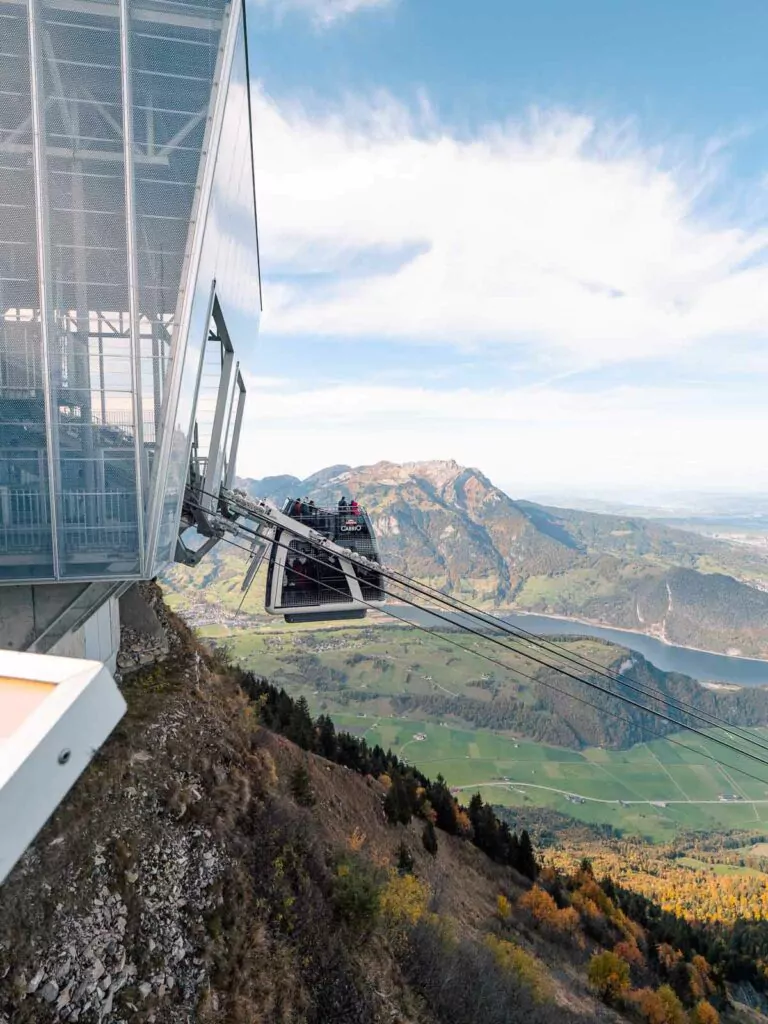
What does the Swiss Travel Pass include?
- Unlimited travel on buses, boats and trains across the Swiss Travel System network
- Free travel on panoramic trains like the Gotthard Panorama Express, Glacier Express and Bernina Express
- A couple of free mountain excursions ( Stanserhorn and Rigi )
- 50% off most other mountain railways and cable cars
- Free public transport in 90 cities
- Free entry to more than 500 museums
What does the Swiss Travel Pass not include?
- Seat reservations on panoramic trains (most trains in Switzerland don’t require reservations but the Glacier Express, Bernina Express and a couple of others have either mandatory or recommended reservations)
- The mountain excursion to Jungfraujoch (but you do get a 25% discount)
- Mountain railways and cable cars like Gornergratbahn, Matterhorn Glacier Paradise, Titlis and Pilatus (but you do get a 50% discount on most of them)
- Private lake cruises
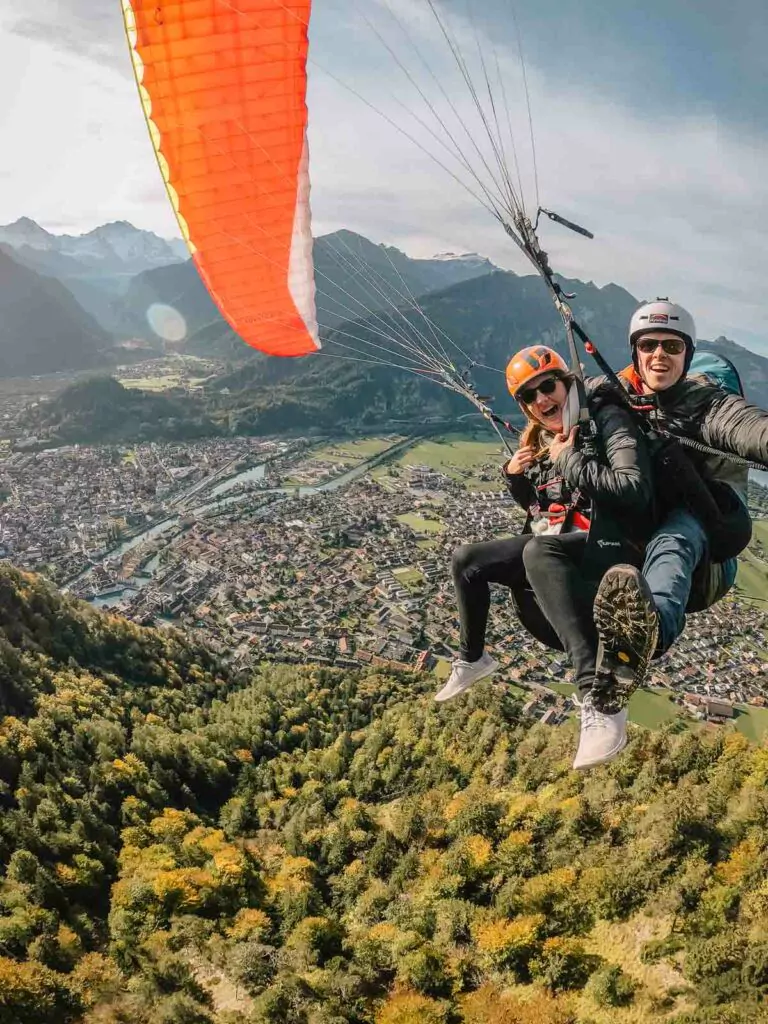
Swiss Travel Pass prices
Here are the prices for adult passes in 2nd class. 1st class passes are about 60% more expensive than the prices you see below.
Prices valid as of 1 February 2024, they typically put prices up annually at the most so these should be valid for the remainder of 2024.
Can you get a discount on a Swiss Travel Pass?
If you’re between 16 and 25 you’re eligible for the Swiss Travel Pass Youth, this gives you a 30% discount on the pass prices above.
Kids aged between 6 and 16 (until their 16th birthday) accompanies by at least one parent (holding a Swiss Travel System ticket) travel free of charge across the network with a complimentary Swiss Family Card.
Kids under 6 travel free of charge across the network, no Swiss Family Card needed.
There are no senior discounts for the STP unfortunately.
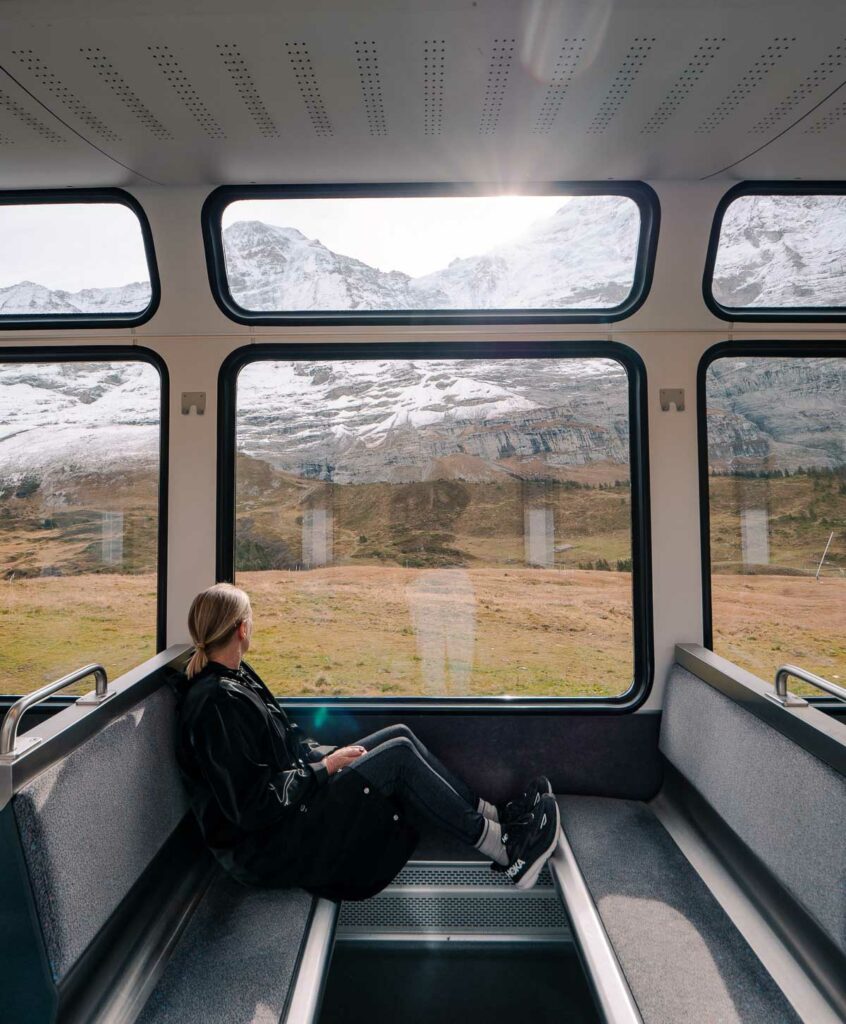
How to use a Swiss Travel Pass
Where to buy a swiss travel pass.
You can easily buy a Swiss Travel Pass online from the comfort of your home or while you’re already on your way to Switzerland.
Just keep in mind that you must have a valid STP if you’re taking advantage of the benefits, i.e. if you jump on a train with the plan to buy your STP once you’re on it, and you get asked for your ticket before you have a chance to buy it, you’ll get fined.
Is there a Swiss Travel Pass app?
There’s no Swiss Travel Pass app, but you can manage your pass online.
Once you purchase your STP you’ll be emailed a receipt with details on how to activate your pass.
If you’ve got a Swiss Travel Pass (with consecutive days), you simply need to show the QR code (on your phone or printed if you prefer) to the people checking train tickets.
If you have a Swiss Travel Pass Flex, you need to activate a travel day for each day you want to use the pass. You can do that at https://activateyourpass.com. Bookmark that URL on your phone or laptop for easy access.
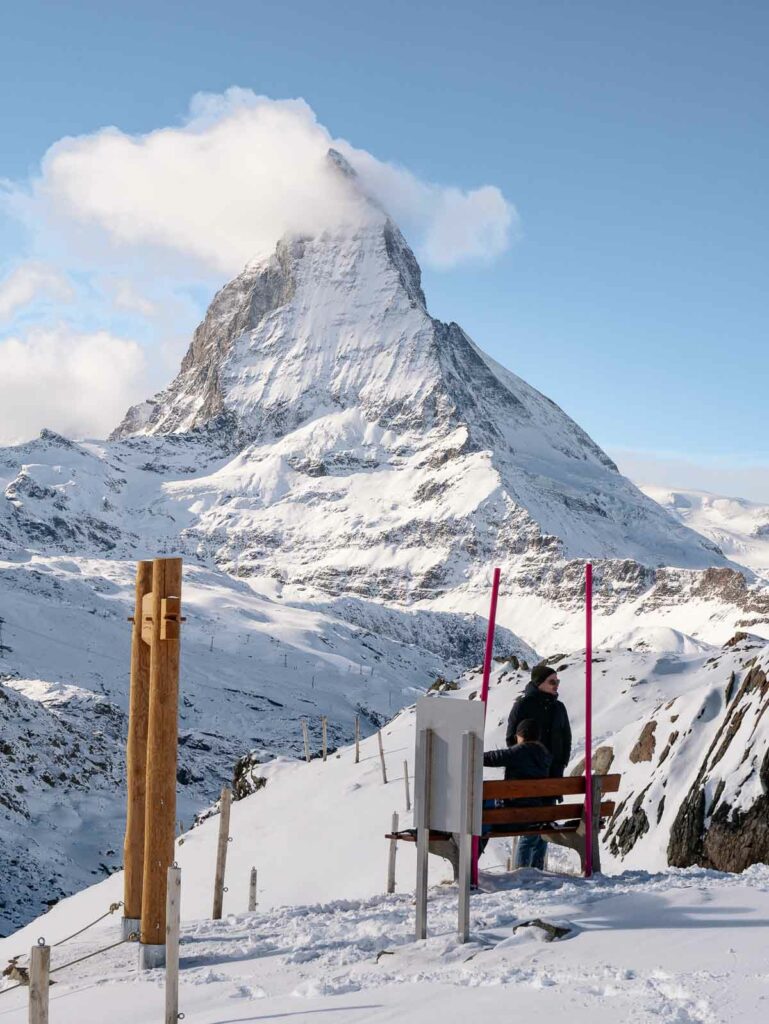
Do you need to make seat reservations with the Swiss Travel Pass?
Most trains, boats and buses in Switzerland are reservation-free, meaning you can hop on and off with your pass without paying any additional supplements.
But there are some instances where seat reservations are mandatory, like:
- The Glacier Express
- The Bernina Express
- GoldenPass Express Prestige Class
- Gotthard Panorama Express
How to book mountain railways with the Swiss Travel Pass
If you want to take advantage of one of the mountain railway or cable car discounts with the STP, you can book these online and select ‘Swiss Travel Pass’ in the ‘discount’ dropdown. Just remember to activate a travel day for that day.
You can also purchase tickets at the relevant mountain railway/cable car station and show your pass to get a ticket at the discounted price.
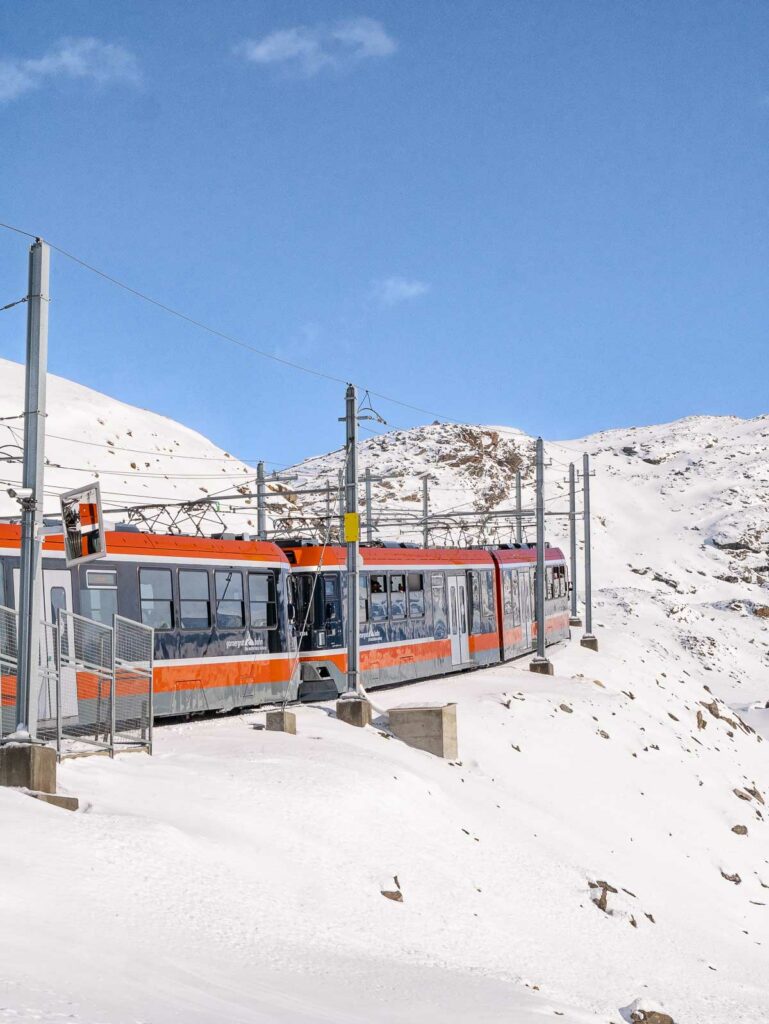
How to calculate if the Swiss Travel Pass is worth it for your trip
I get loads of messages from people sharing their rough itinerary and asking me if a rail pass is worth it, but unfortunately it’s a bit trickier than just looking at the cities you’re going to over six days and then knowing whether it’ll be good value or not.
Here are some deeper dives into how to truly figure out if the STP is worth it for your trip.
If you know your itinerary
If you know your itinerary, including what activities you want to do, you can easily figure out if a Swiss Travel Pass is worth it for you.
- Write each trip into a spreadsheet, e.g. Zurich to Lucerne or Jungfrau day trip from Grindelwald
- Create three columns in the spreadsheet, for the full fare price, the Swiss Half Fare Card price and the STP price
- Go to SBB.ch and search each train/bus/boat route you’re taking on the public network. If your trip is within six months then put in the actual date if you can, if it’s outside of six months just pop in a date 5-6 months from now.
- Note down the price for each trip for the Half Fare Card and for the full fare. The SBB system automatically shows you the half fare price first as the ‘from’ price, you’ll need to select ‘full price’ under travel options to see the actual price without a Half Fare Card.
- For ‘normal’ trips on the public transport network (i.e. not panorama trains or mountain railways/cable cars), put ‘0’ in the STP column as all of these are covered
- If you’re taking any panoramic scenic trains, check the prices on their website because you’ll need to add in mandatory seat reservations and ensure you’re noting down the correct seasonal prices. They should specify full fare prices, half fare prices and mandatory seat reservations for STP holders.
- For mountain railways like Rigi Kulm or Jungfrau, or for cable cars like Titlis or Matterhorn Glacier Paradise, check their websites to take note of the full fare and half fare prices. These websites should also show you a STP price but sometimes you’ll need to do a ticket search and select ‘Swiss Travel Pass’ as the discount to see the price.
- Add in a final row with the pass price, 120CHF for the Half Fare Card and the relevant price for the STP you need based on your trip length
- Total up the columns!
Your spreadsheet should look something like this:

From here, you should be able to clearly see whether the Swiss Travel Pass, Half Fare Card or full fare tickets would offer the best value.
Important: Switzerland’s public transport system uses dynamic pricing based on demand, which means that the train from Zurich to Lucerne will get more expensive as more people book it. If you see that your trip is cheaper with full fare tickets or a Half Fare Card, lock these in in advance to make sure you get the best price before demand gets higher and the ticket price rises.
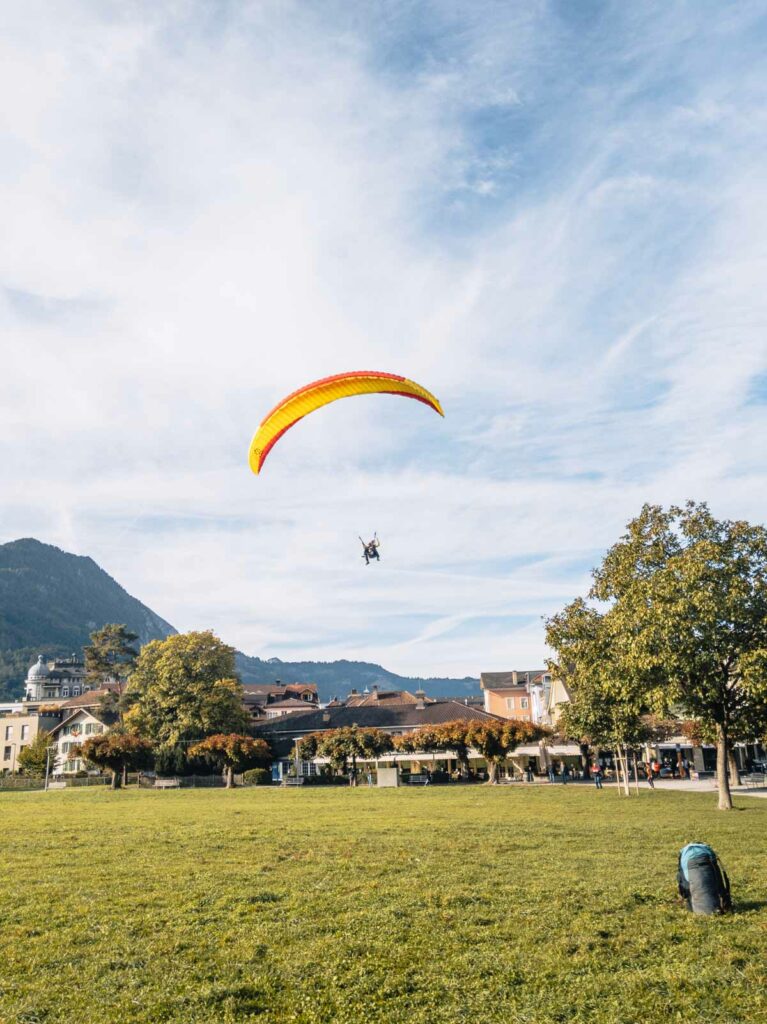
If you have no idea about your itinerary
If you don’t know your itinerary yet, and want to just go with the flow while you’re in Switzerland, it’s a little trickier to determine whether the Swiss Travel Pass is worth it.
The best way to do this is to consider the value of the pass per day, and make sure that you’re likely to save at least that cost if you used the pass. In the most basic of calculations, if the Swiss Travel Pass is going to save you more than the below prices on average per day across your trip, then it’s worth it.
Here’s the cost per day of the prices (as of 1 Feb 2024):
If you’re planning a ten day Switzerland trip but don’t know where you’re going yet, consider whether you’re likely to save at least 55CHF per day on average by using buses/trains/boats and utilising discounts on mountain railways and cable cars. If so, then an 8 day Swiss Travel Pass Flex could be worth it for you (assuming you will have two days of your trip where you’re not using the pass).


Swiss Travel Pass vs. Half Fare Card if you don’t know your itinerary
This is the biggest question people what to know when they’re considering if the Swiss Travel Pass or the Half Fare Card are better, but if you don’t have your itinerary you need to either need to come back to this stage later in your trip planning, or take a good, hard look at your priorities and pull a rough itinerary together.
At the minimum, you need to:
- Figure out the cities you’re likely going to get between
- Choose the mountain excursions you definitely want to do (keeping in mind Rigi and Stanserhorn are free with the STP)
- Determine whether a Glacier Express trip is a must-do for you (probably Switzerland’s best trains)
- Determine whether Jungfrau is a must-do for you (iconic Top of Europe)
- Figure out how long in advance you think you’ll know your plans
From here you’ll have a rough idea like this:
- 2 x intercity trips
- 2 x Glacier Express trip
- 2 x mountain excursions (the free ones on the STP)
- Not keen for Jungfrau
- Wants to confirm plans a before travel, to keep the trip very flexible
With this in mind you can out together the spreadsheet just using rough searches and dates for your routes. It’s not going to give you exact pricing relevant to your route, but it will at least give you a good idea on if the STP or the Half Fare Card will likely come out on top.
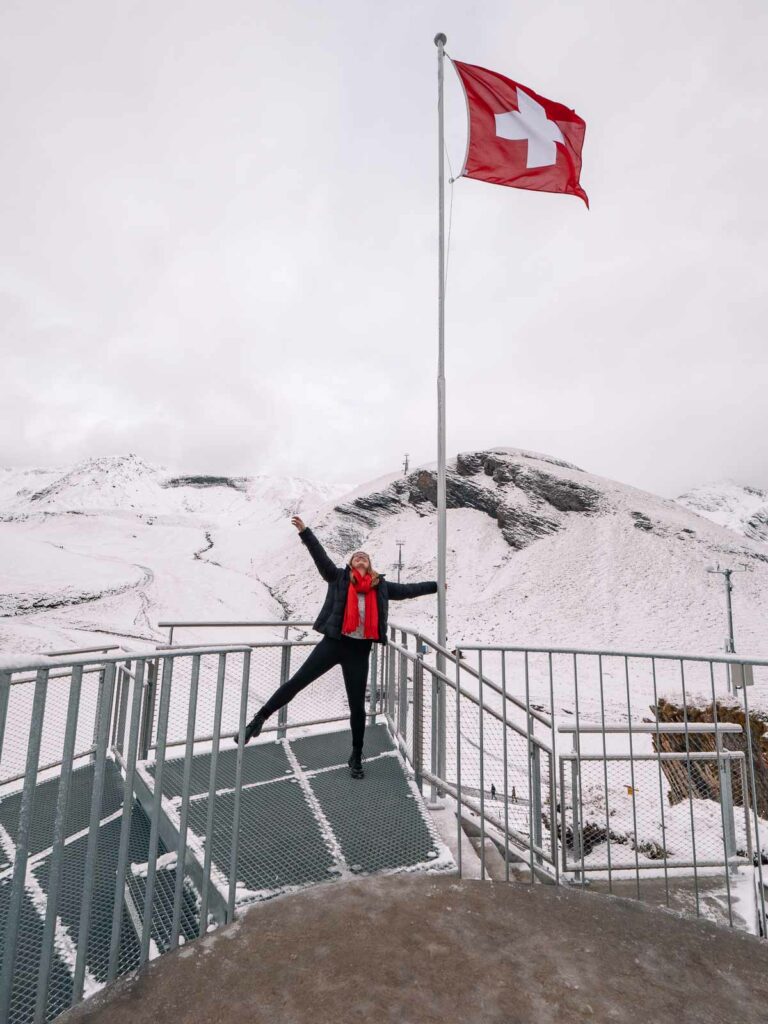
Pros of a Swiss Travel Pass
- No need to buy tickets for trips on the trains/buses/boats on the public network, just jump on and show your pass to the driver, ticket staff or train controllers
- Free entry to 500 museums
- Free public transport in most cities/towns
- Free access to Rigi and Stanserhorn mountains
- Discounted access to many other mountains (usually 50% but 25% for Jungfrau)
- Covers the whole ticket cost of the expensive panorama trains, which saves you a whopping 159CHF on a Glacier Express 2nd class ticket or 272CHF on 1st class. You still need to pay the 44-49CHF seat reservation, but a Half Fare Card would still require you to pay 79.50CHF for the 2nd class ticket on top of the reservation.
Cons of a Swiss Travel Pass
- Expensive up-front price
- Only for a set number of days which is annoying if you need a pass for the number of days in between, e.g. 5, 7, 10 or 12
- A maximum of 15 days on the pass, compared to the Half Fare Card which is valid for one month
- Only 25% discount at Jungfrau (compared to 50% on the Half Fare Card)
- You might pay for days you don’t end up using to their full potential (e.g. if you don’t travel on one of the days of the pass, or if you end up doing a short trip which would have been cheap without the pass anyway)

Is a Swiss Travel Pass worth it? Four example itineraries
I want to share four example itineraries to show you the value of the Swiss Travel Pass vs. point-to-point tickets, and I’ve included the Half Fare Card in there too.
Each of these example itineraries is using prices for tickets booked one month in advance. Keep in mind that if you book any later than one month in advance, chances are the prices will be higher.
Five days in Switzerland: Swiss Travel Pass budget breakdown
For this one I’m using my five day Switzerland itinerary , which includes:
- Zurich to Interlaken
- Interlaken to Schiltorn day trip
- Interlaken to Jungfrau day trip
- Interlaken to Zermatt
- Zermatt to St Moritz (Glacier Express)
Here’s a spreadsheet showing the breakdown:

The Half Fare Card ends up being 30% cheaper than buying full fare tickets, and 17.4% cheaper than doing the same trip with a Swiss Travel Pass.
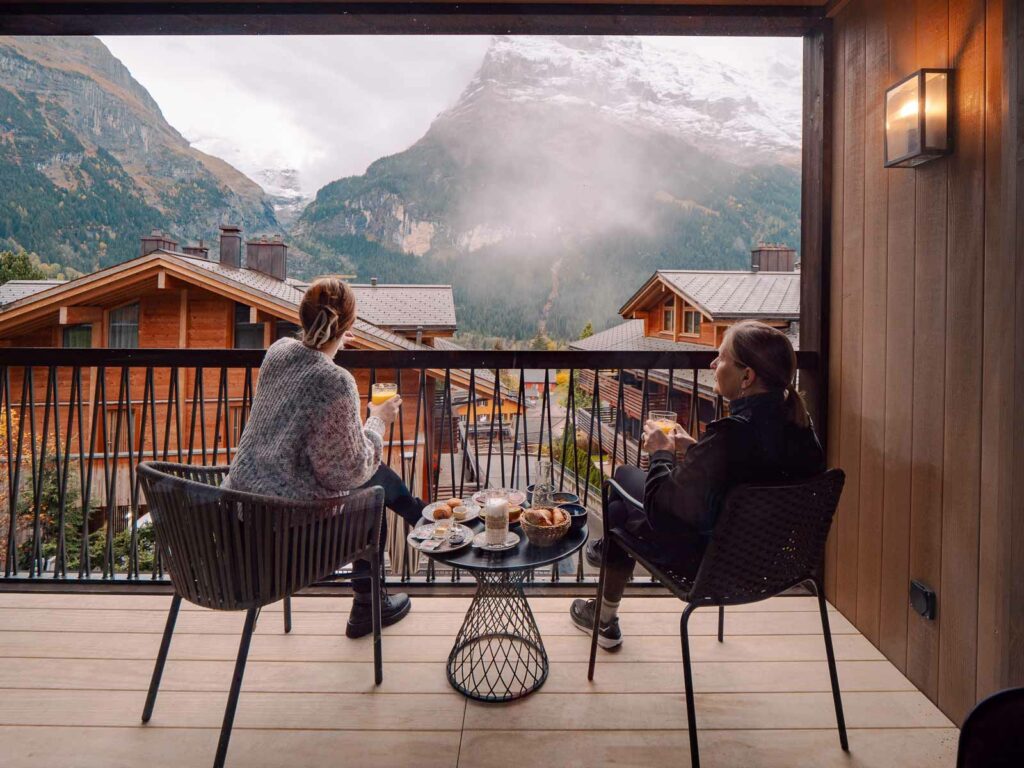
Ten days in Switzerland: Swiss Travel Pass budget breakdown
My ten day Switzerland itinerary is longer and includes five mountain excursions + two epic panorama train trips. I’ve calculated the below based on an eight-day Swiss Travel Pass Flex, leaving two days for shorter trips or local travel that doesn’t require a pass day.
Here’s the breakdown:

As you can see, the Swiss Half Fare Card comes out on top again! It’s 35.5% cheaper than buying point-to-point tickets, and 10.9% cheaper than using a Swiss Travel Pass Flex.
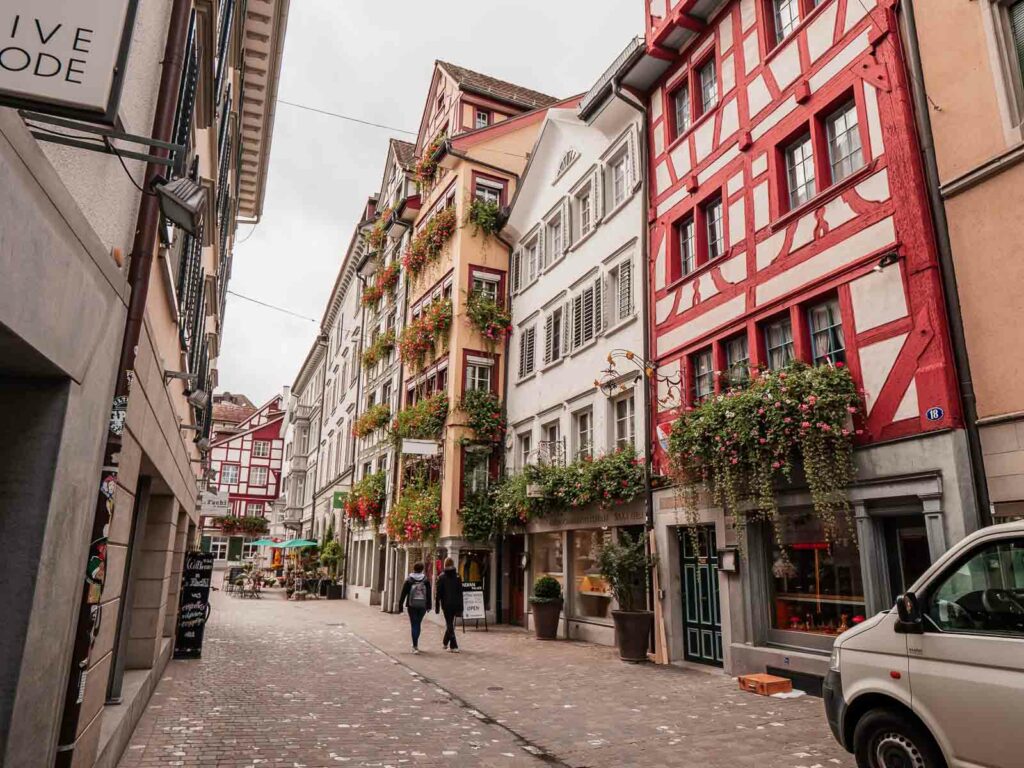
Free mountain railways only
Let’s throw a spanner in the works and say you’re taking my ten day Switzerland itinerary but removing the mountain excursions that aren’t free with the Swiss Travel Pass, just focusing on city trips, free excursions and hikes that don’t require cogwheel trains or cable cars.

Much closer this time, the Swiss Half Fare card saves 6CHF compared to getting the 6-day Swiss Travel Pass Flex. Both options are still loads cheaper than the full fare.
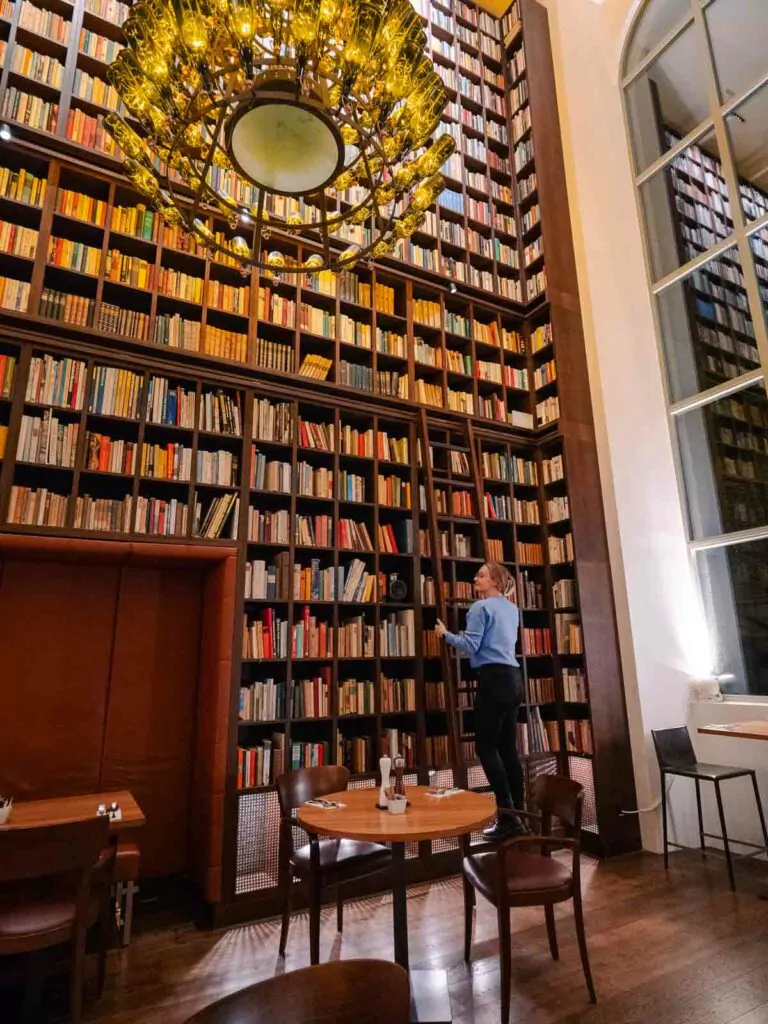
Short trip with free mountain railways only
I’m determined to find a way where the Swiss Travel Pass comes out on top, and I think I’ve found one.
Let’s cut down the itinerary length but include longer train trips, a panorama train journey, free mountain excursions and book everything last minute, only a few days before travel. Here’s the breakdown:

We got there in the end! This trip utilises a four day Swiss Travel Pass Flex and there’s only one additional supplement to pay on top of the travel pass, the Glacier Express seat reservation. In this instance the Swiss Travel Pass ends up being 42% cheaper than the point-to-point full fare tickets, and 14.6% cheaper than the Swiss Half Fare Card.
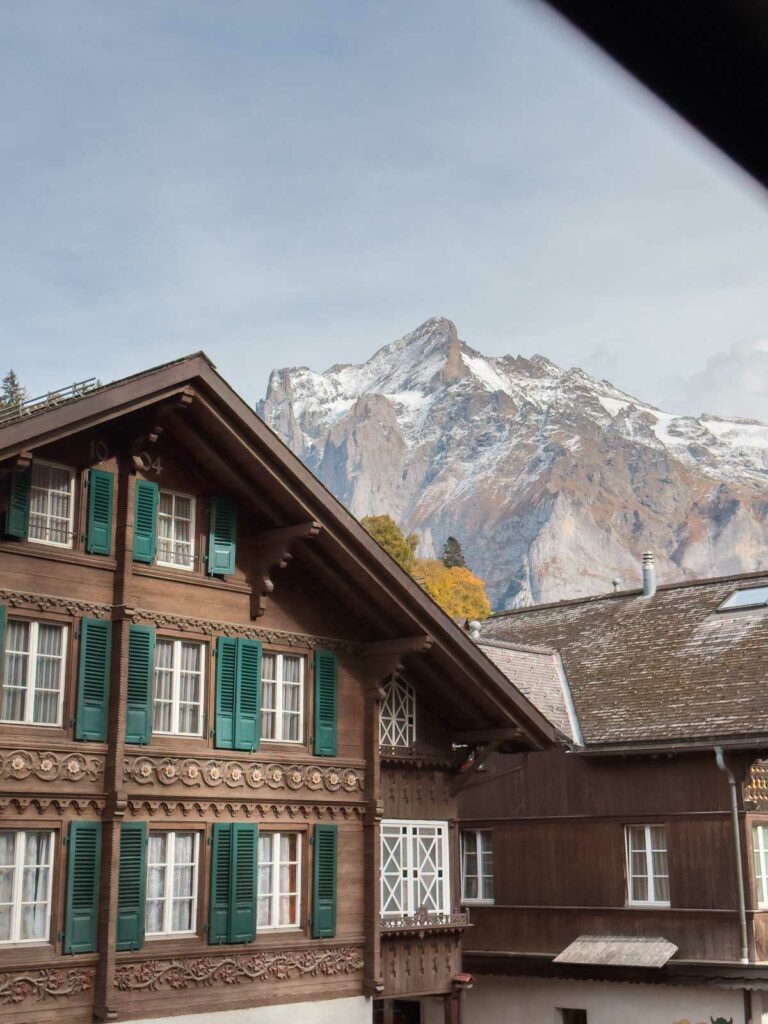
Swiss Travel Pass alternatives
I’ve talked about the Swiss Half Fare Card a little bit already but here’s some more info on that, plus a bunch of other alternatives you could consider instead of the Swiss Travel Pass.
Swiss Half Fare Card
The Swiss Half Fare Card is exactly what it says on the tin, it gives you half-price fares across the Swiss Travel System network.
There are a couple of key benefits to the Swiss Half Fare Card which make it a great option in lots of scenarios:
- It gives you 50% off most mountain railways and cable cars at half price, sometimes this is the same as the Swiss Travel Pass but in some cases, like Jungfrau, it’s even more of a discount
- It’s only 120CHF and lasts a whole month
And the disadvantages:
- It only gives you 50% discount on the tickets for the panorama trains like the Glacier Express, you still need to pay the full seat reservation
- You have to pay 50% for Rigi and Stanserhorn mountains, which are free with the Swiss Travel Pass
- You need to purchase tickets for each train, bus and boat, unlike the Swiss Travel Pass where you just show your pass to be allowed on. You can easily book them on the SBB app or website, just make sure you’re clicking the half-fare discount.
Book your Swiss Half Fare Card >>
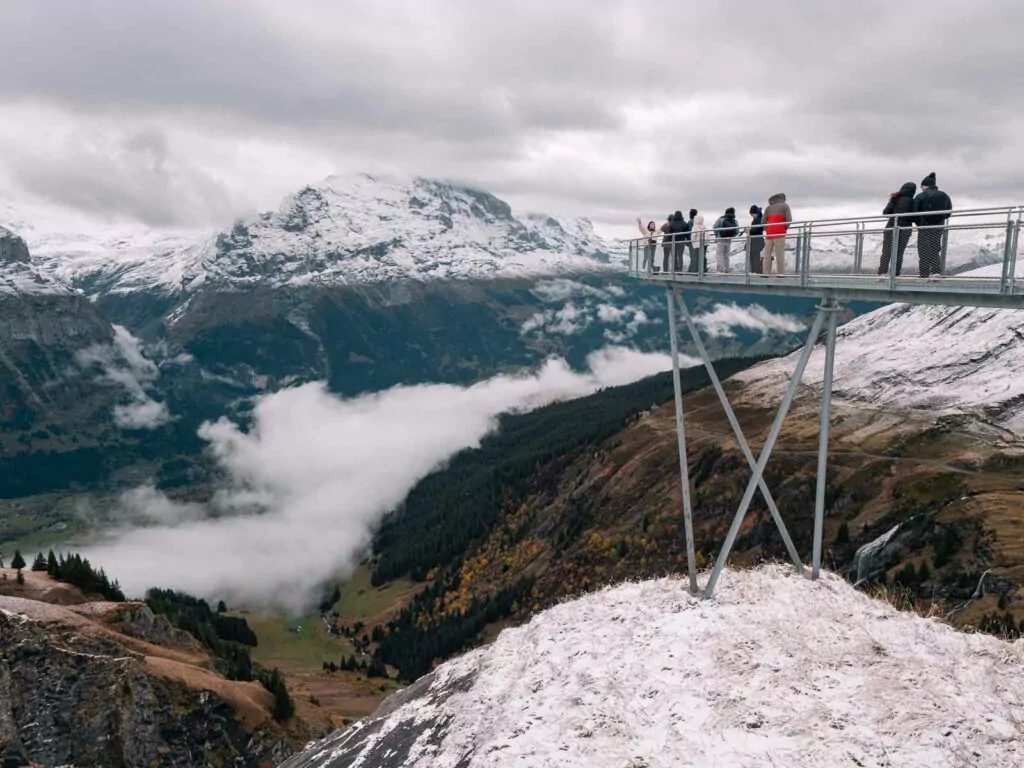
Point-to-point full fare tickets
A point-to-point, full fare or individual ticket is all the same thing, and it refers to just going to the SBB website or a train station to book a trip at the full fare price.
This is pretty much never the cheapest option if you’re travelling in Switzerland and plan on taking at least a few trains during your time there.
If you’re travelling last minute, the point-to-point tickets can be significantly higher (like twice as high) as what you might have seen if you checked prices two months ago.
Regional passes
To make things really confusing, different regions in Switzerland sometimes have their own travel passes that cover public transport and offer various discounts on mountains.
If you’re happy to spend a bit more time on your calculations, you might want to add up what a regional pass would cost in conjunction with a Swiss Half Fare Card that you could use for the rest of your trip.
Tell Pass in Lucerne region
- Unrestricted travel on rains, buses and boats and aerial cableways throughout the Lake Lucerne region
- 100% discount on mountain excursions like Rigi, Stanserhorn (both free with an STP) and also 100% discount on Pilatus and Titlis (STP only gets 50% off most cable cars and mountain railways)
- 2, 3, 4, 5 and 10 consecutive days
- Passes start from 120CHF in winter and 190CHF in summer
- Cheaper price per day than the Swiss Travel Pass, could be used in this region and then a STP or Half Fare Card for the rest of the trip
Find out more about the Tell Pass Summer >>
Find out more about the Tell Pass Winter >>

Berner Oberland Pass in Bernese Oberland
- Unrestricted travel on public transport in the Bernese Oberland region, from Lucerne to Berne to Saanan to Domodossola
- Includes free travel on more than 25 mountain cable cars, including Grindelwald-First, Harder Kulm and Schynige
- Boat trips on Lake Thun and Lake Brienz are included
- 3, 4, 6, 8 or 10 days
- Starts from for the 240CHF full fare but you can bring that down to 168CHF if you own a Swiss Half Fare Card
- 50% discount from Mürren to Schiltorn and from Engelberg to Titlis
- Discounts from local suppliers like cheaper activities, restaurant offers etc.
- Free travel to Kleine Scheidegg and then 50% off the final stretch to Jungfraujoch for 99CHF (instead of 138CHF)
Find out more about the Bernese Oberland Pass >>
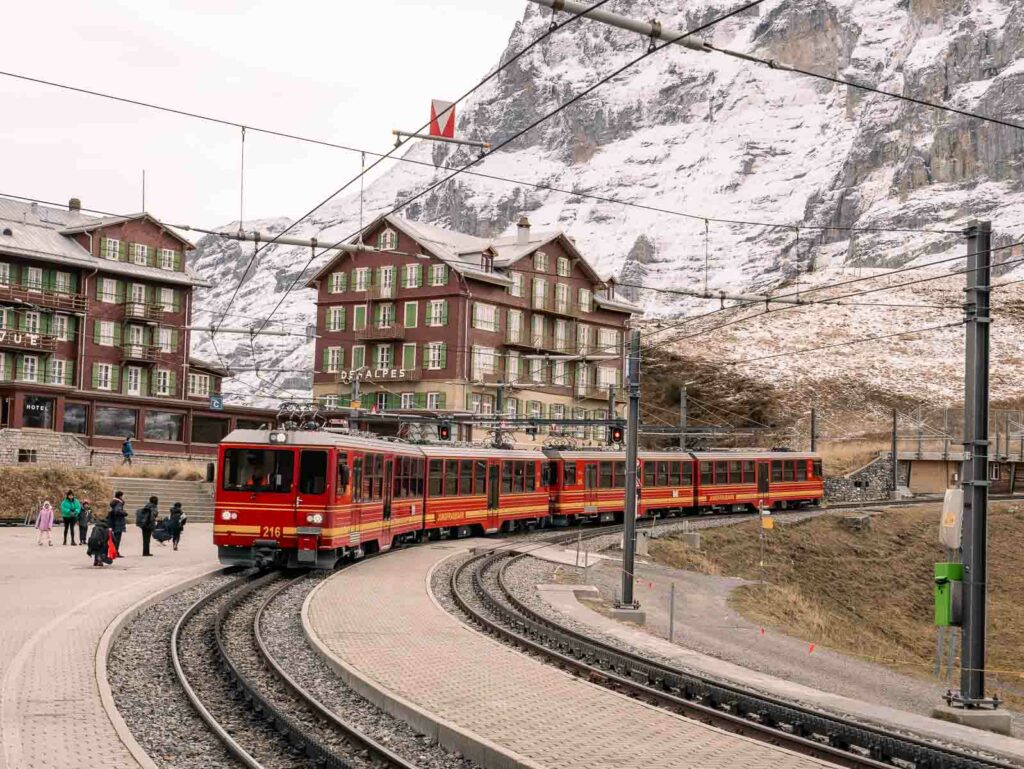
Jungfrau Travel Pass for Jungfrau region
- Unlimited travel on boat. buses, trains, cable cars and most mountain railways in the Jungfrau region
- Includes Interlaken and boats across the lakes, Harder Kulm, Lauterbunnen, Mürren, Wengen, Grindelwald and the train from Kleine Schedegg to Eigergletscher
- You can get the return train from Eigergletscher to Jungfraujoch for a special price of 63CHF (low season) or 75CHF (high season)
- Prices start from 210CHF for a full fare Jungfrau Travel Pass but you can bring that down to 165 if you own a Swiss Half Fare Card
- The Jungfrau Travel Pass runs in summer but there’s a separate Jungfrau Travel Pass Winter which is slightly different as there are no boats running on the lakes and you know have access to the Jungfrau region’s ski fields
Find out more about the Jungfrau Travel Pass >>
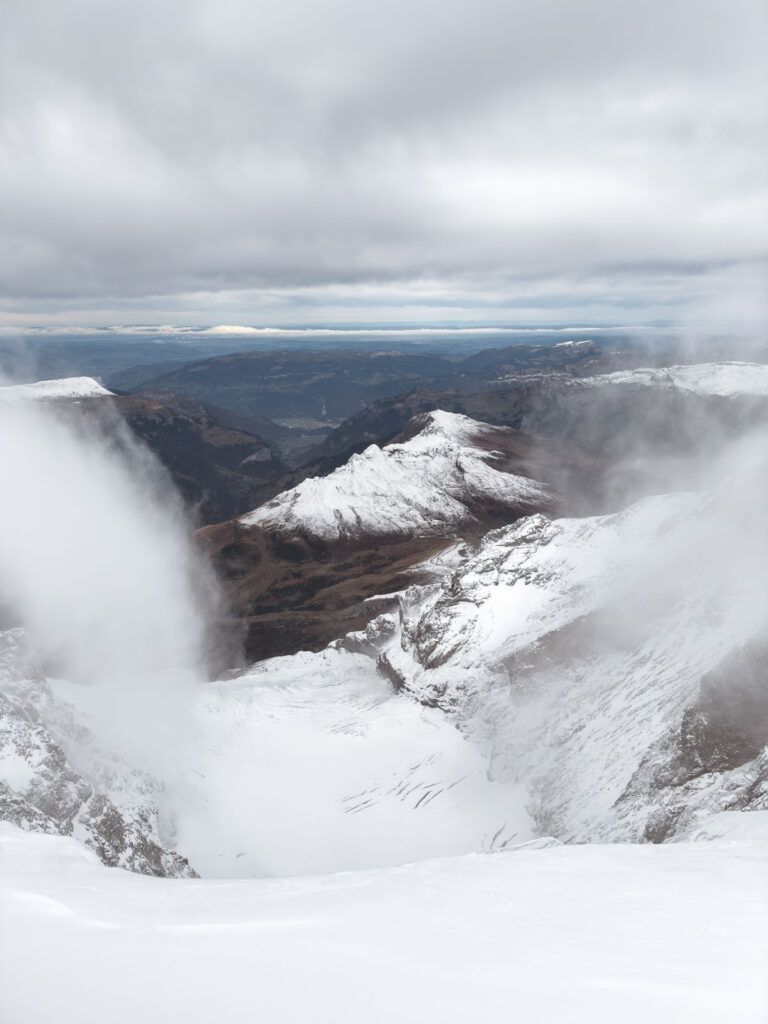
Zermatt Peak Pass
- Unlimited travel (not valid for skiing) on the following lifts and trains: Zermatt-Matterhorn Glacier Paradise, Zermatt-Gornergrat, Furi-Riffelberg and Zermatt-Rothorn
- Admission to Glacier Palace, use of Matterhorn Gotthard Bahn between Randa, Tasch and Zermatt
- Local buses also included
- You get a 25% discount with a Half Fare Card or Swiss Travel Pass
- One day pass is 172CHF full fare and 129CHF with a Half Fare Card
- If your only mountain plans in Zermatt are to do the Gornergratbahn and Matterhorn Glacier Paradise, it’s cheaper to just get the Half Fare Card. With the Half Fare Card it would only be 111.55CHF for return tickets for both, compared to the 129CHF for a half-fare discounted one day Peak Pass.
- If you’re planning on hiking or mountain biking a lot in Zermatt then a Peak Pass might be worth it
Find out more about the Zermatt Peak Pass >>

Eurail/Interrail Passes
If your time in Switzerland is part of a bigger trip, like spending a couple of months in Europe or combining Switzerland and Northern Italy , you could look into getting a Eurail (for non-European residents) or Interrail (for European residents) Global Pass to cover your trains inside and outside of Switzerland.
- Covers most trains across Europe but reservations might be required (particularly expensive in France and Italy)
- Free travel on most of Switzerland’s public inter-city trains
- Seat reservations required for panoramic trains
- Doesn’t include mountain railways or cable cars but you might get a discount (usually 25%, some give 50%)
- Doesn’t cover public transport within a city
- Doesn’t cover buses or boats, but you might get a discount on some lake cruises
- The Eurail or Interrail Pass generally isn’t as good value in Switzerland as the Swiss Travel Pass or Half Fare Card because of the low mountain railway discounts, so I’d recommend looking into splitting your trip. You could use a Eurail Pass for your journeys between cities like Zurich to Lucerne or Zermatt to St Moritz on the Glacier Express, then get a Half Fare Card or regional pass like the Tell Pass to cover your mountain railways.
Find out more about the Eurail Global Pass >>
Find out more about the Interrail Global Pass >>
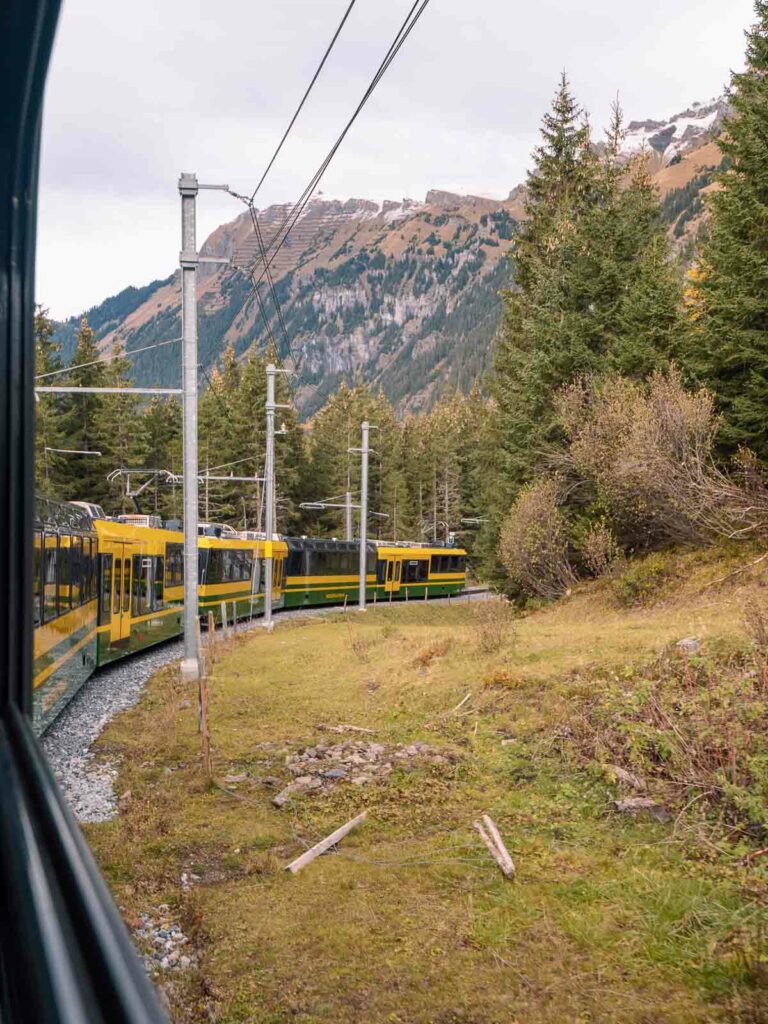
Saver Day Pass
A Saver Day Pass is almost like a one day Swiss Travel Pass, giving you unlimited travel across the Swiss Travel System network for one day (from midnight until 5am the next morning).
- The cost of the Saver Day Pass varies, it’s cheaper if you book it in advance and it’s non-refundable, so you need to know what day to buy for
- Could be good if you’re planning on visiting Switzerland for only a few days and just want one or two big adventure days with long trains
- Also great if you’re in Switzerland for work or family reasons and will only have one day to be able to explore, book your Saver Day Pass in advance and you’ll be able to go wherever you want
- No discount on most mountain railways
- Combinable with the Half Fare Card
Book a Saver Day Pass on sbb.ch >>
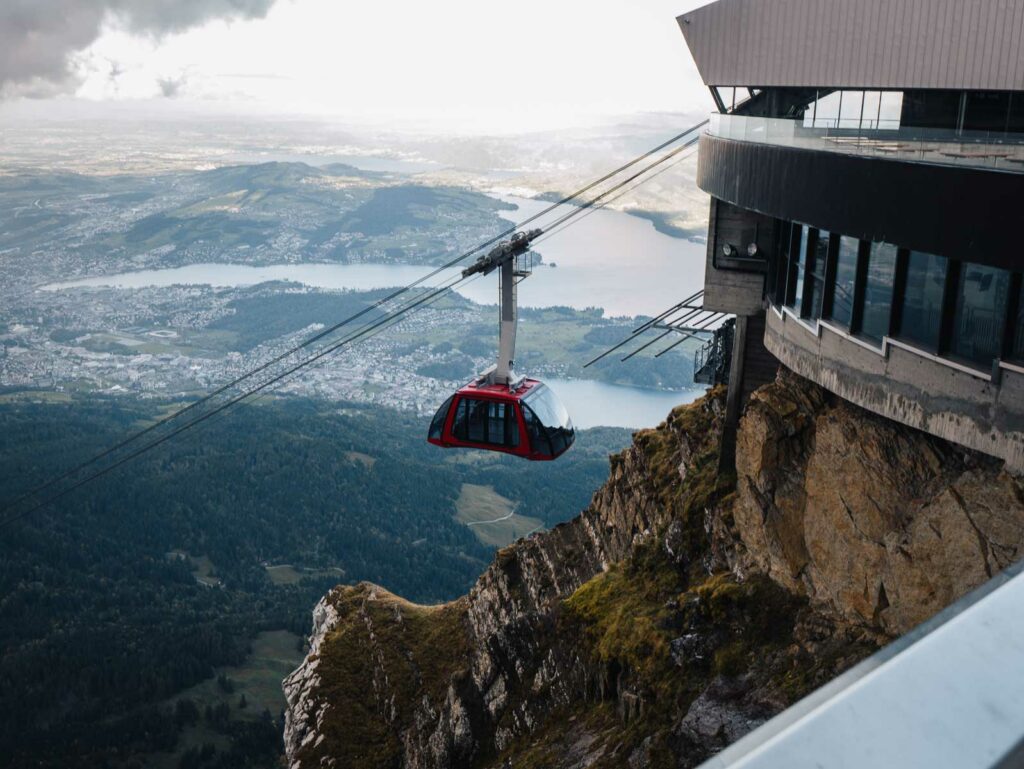
Swiss Travel Pass FAQs
Is the 1st class swiss travel pass worth it.
The value of a 1st class Swiss Travel Pass totally depends on your travel preferences and budget.
Most Swiss trains on the Swiss Travel System network have 1st class carriages with have more spacious seating and comfier seats, and they’re usually less busy than the 2nd class carriages, which means less noise. 1st class carriages usually have two seats on one side and a single row of seats on the other, so for solo travellers they’re great as you won’t need to sit next to someone.
If you have a 1st class pass that also gives you access to book 1st class tickets for the Glacier Express which is an incredible experience and definitely worth the money if you can afford it.
I personally go for the 1st class pass because I like to work on long trains and I find this easier in a cabin where there’s a single row of seats so I’m not typing away next to a stranger.
But if you’re just travelling for normal sightseeing, in a couple or a family/friends group, and aren’t fussed on the 1st class Glacier Express experience, then just go for 2nd class and save that money for your adventures.
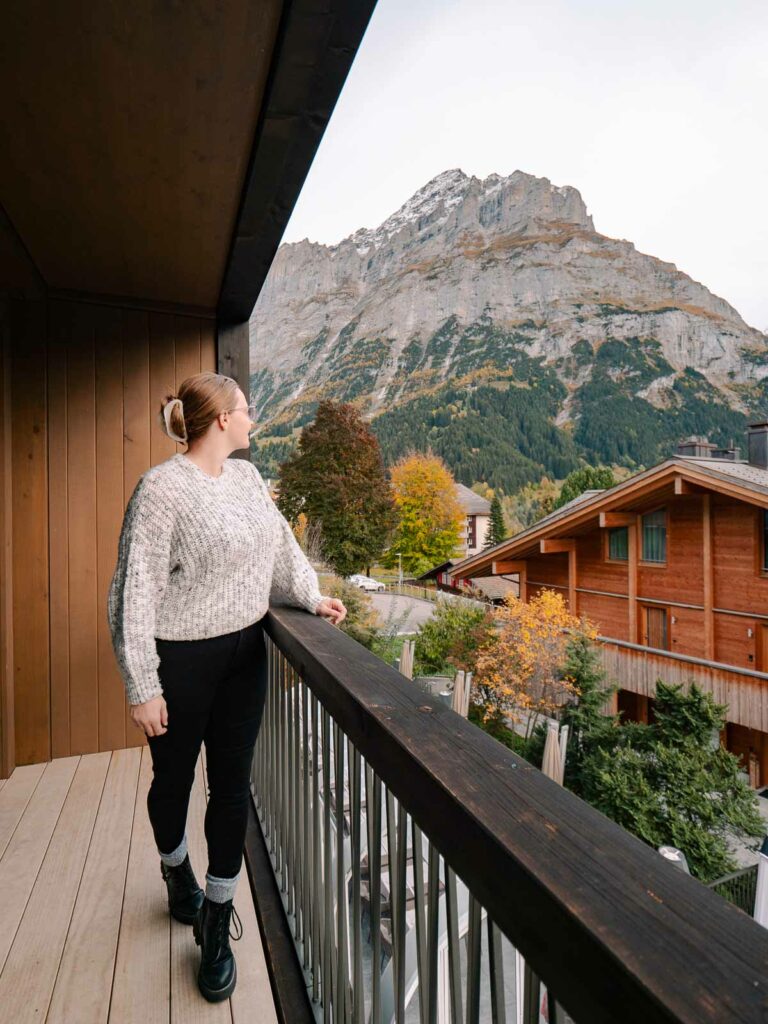
Is Jungfraujoch free with Swiss Travel Pass?
The Jungfraujoch journey is not entirely free with the Swiss Travel Pass , but the pass entitles you to a discount.
Getting to Grindelwald or Wengen is fully covered by the pass. From there, you receive a 25% discount on the train or cableways to reach Jungfraujoch.
Does the Swiss Travel Pass cover the Grand Train Tour?
If you’re up for a major adventure, the 1280km Grand Train Tour is a bucket list train journey worth considering.
The tour consists of eight different trips that combine to create a figure-eight-ish round trip, mostly train but some bus and boats thrown in for fun, and includes the five premium panoramic trains.
The Grand Train Tour is completely covered by the Swiss Travel Pass, you’ll just have to pay for seat reservations on the Bernina Express, Glacier Express and Gotthard Panorama Express.
Does the Swiss Travel Pass cover all mountain railways and cable cars?
The Swiss Travel Pass covers a couple of mountain railways and cable cars, like Rigi and Stanserhorn.
Other mountain railways and cable cars are discounted:
- Pilatus (free to reach Kriens or Alpnachstad by bus, train or boat, then 50% off for the train and cable car to Pilatus)
- Titlis (free to Engelberg, 50% off to the top)
- Schiltorn (free to Mürren or Stechelberg, then 50% off the cable car to the top)
- Jungfraujoch (free to Grindelwald or Wengen and then 25% off)
- Grindelwald-First (50% off)
- Matterhorn Glacier Paradise (50% off)
- Glacier 3000 (50% off)
- Gornergratbahn (50% off)
- Schynige Platte (free to Wilderswil, then 50% discount)
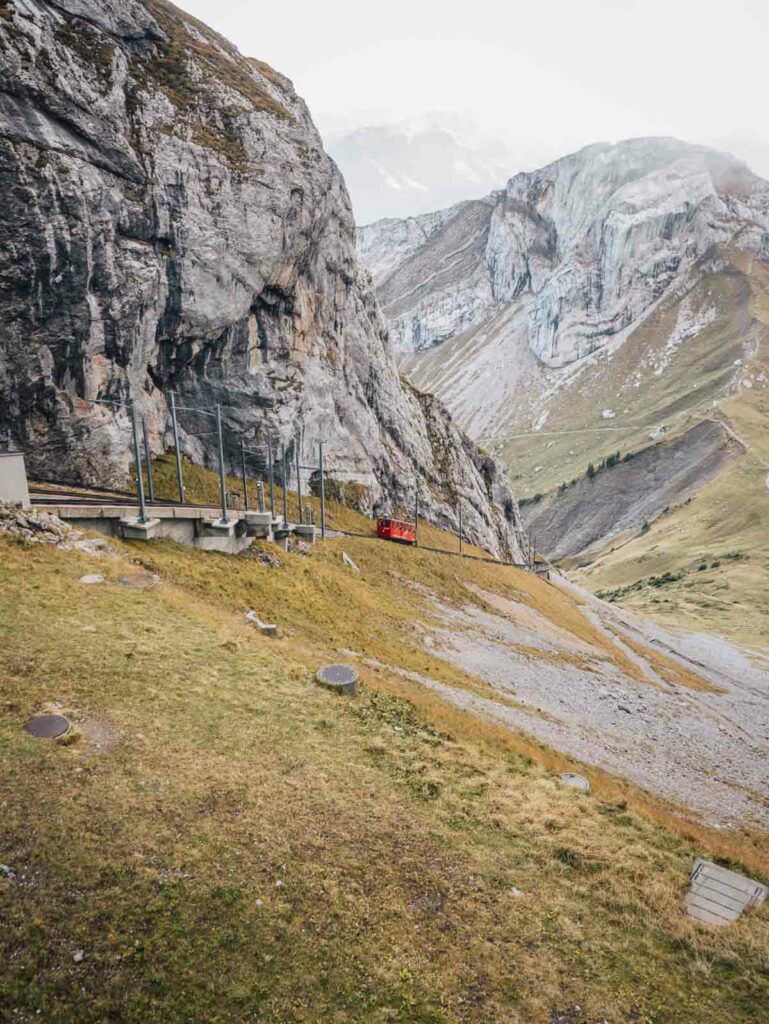
What is the Swiss Rail Pass?
The terms “Swiss Rail Pass” and “Swiss Travel Pass” are often used interchangeably, but they refer to the same product: the Swiss Travel Pass.
The final verdict: Is a Swiss Travel Pass worth it?
Well this was a long one! The final verdict is this:
The Swiss Travel Pass is almost always cheaper than buying point-to-point tickets, BUT the Swiss Half Fare Card is often even better value.
If you want to stay flexible and would prefer the freedom to jump on an off trains as you choose, the convenience of the Swiss Travel Pass is probably worth the extra you might pay vs. a Swiss Half Fare Card.
Alternatively, if you don’t mind purchasing tickets for each trip, and you want to do mountain excursions that aren’t free with the STP, then the Half Fare Card will probably end up being a better deal for you.
Buy your Swiss Travel Pass >>
Buy your Swiss Half Fare Card >>
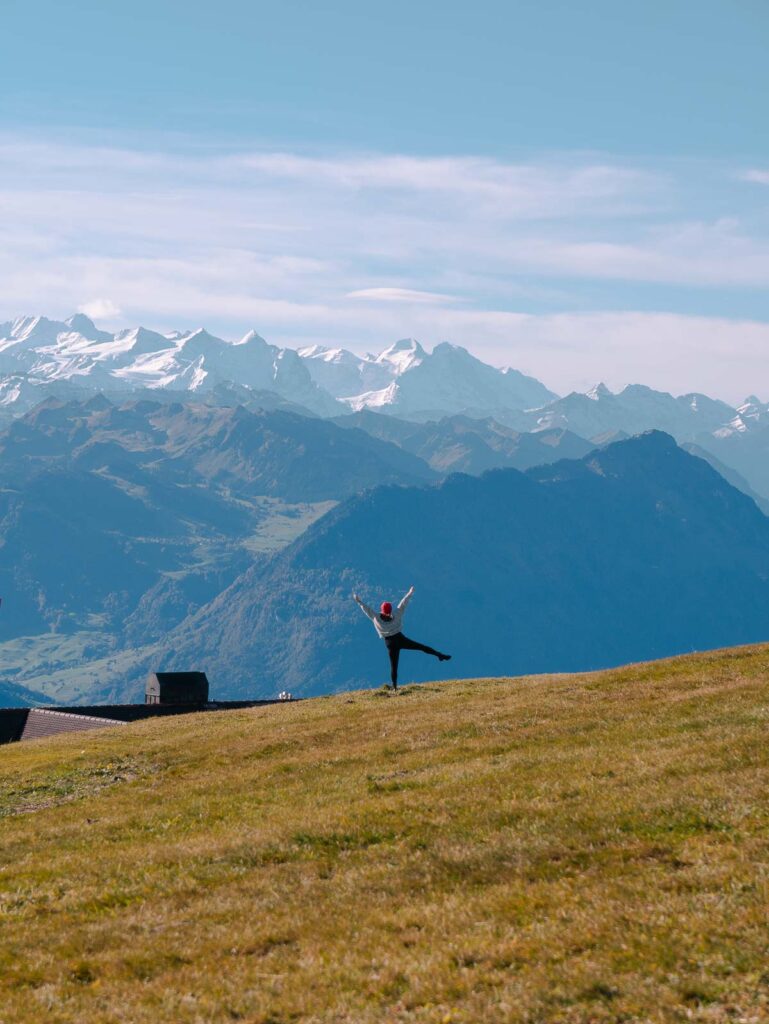
I hope this super detailed breakdown of the Swiss Travel Pass has helped you answer the question “is the Swiss Travel Pass worth it?”.
MORE SWITZERLAND TRAVEL INSPIRATION:
- How to spend 10 days in Switzerland
- How to spend 5 days in Switzerland
- 33 Instagrammable places in Switzerland
- Rigi vs Pilatus vs Titlis vs Stanserhorn: Which one to visit?
- The cheapest place to ski in Switzerland: Liddes Ski Hostel
- 10 reasons to try co-living in Switzerland
- The ultimate Switzerland and Northern Italy itinerary
MORE SWITZERLAND TRAIN GUIDES:
- Swiss Travel Pass vs Half Fare Card: Which one is best?
- The ultimate Swiss Half Fare Card guide
- Is the Glacier Express worth it?
- Is the Bernina Express worth it?
- Bernina Express vs Glacier Express: Which one should you choose?
- Is the Jungfrau Travel Pass worth it?
- Is the Tell Pass worth it?
MORE EUROPE TRAVEL INSPIRATION:
- The perfect two month Europe itinerary
- A Europe Christmas market itinerary by train
- The most beautiful train rides in Europe
- 27 Europe holiday ideas to inspire you
- How to use a Eurail Pass
- Is a Eurail Pass worth it?
- The ultimate Italy bucket list
You’ll Also Love
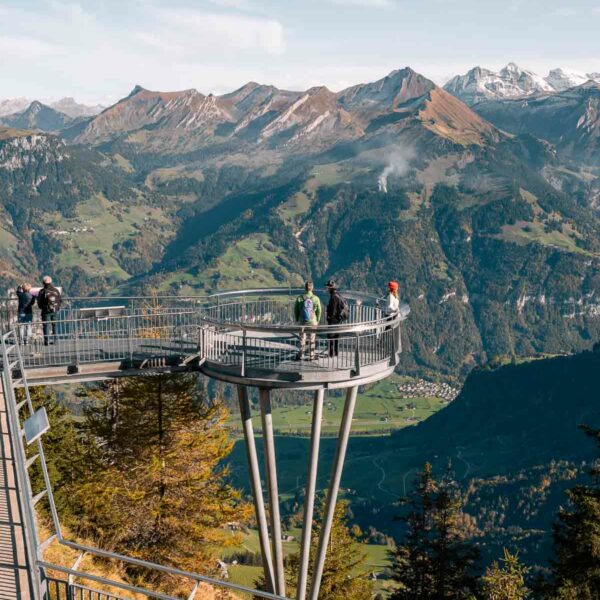
Leave a Reply Cancel reply
Your email address will not be published. Required fields are marked *
- SEE ALL BLOGS
- GET INSPIRED
- DESTINATIONS
- SOLO TRAVEL
- TRAVEL PLANNING
- BLOGGING RESOURCES
Join my email list
Subscribe to be the first to know about new blog posts, travel hacks, giveaways and more.
Finding Alexx is a participant in the Amazon Services LLC Associates Program, an affiliate advertising program designed to provide a means for sites to earn advertising fees by advertising and linking to Amazon.com.
- About Finding Alexx
- Work with me
- Privacy policy
Copyright © 2024 Finding Alexx
We use cookies that are necessary for running the website and for providing you services. Additional cookies are only used if you consent to it. They serve statistical purposes or for displaying individual offers and ads. For more information, read our data protection statement and cookie policy .
By clicking "Agree" you consent to our use of cookies.

Swiss Travel Pass
Starting From USD 261
Book Swiss Travel Pass
Type of pass : continuous.
- Unlimited travel within the set selected days For example: If you choose Consecutive 8 Days Swiss Travel Pass, you can travel unlimited times on Swiss Public Transport for 8 days.
- Pass is valid from the selected start date For example: If the selected start date is 1 st Jan 2024, then your pass is valid till 8 th Jan 2024 midnight.
Type of Pass : flexi
- Unlimited travel within 1 month from the selected start date For example: If you choose Flexi 8 Days Swiss Travel Pass, you can travel unlimited times for any 8 days in one month
- Pass is valid from the selected start date For example: If you select start date as 1 st Jan 2024, then your pass is valid till 30 th Jan 2024 and you can travel unlimited for any 8 days within these 30 days.
Type of First class
- The First Class pass means a passenger can access the first-class sections of public transport like Train and Boat.
- In a train, the first-class seating is more spacious and has a separate section
- In a boat, the first -class section is the upper deck of the boat
Type of Second class
- The Second Class pass means a passenger can access only the second-class sections of public transport.
- Enjoy reduced-rate travel across Switzerland for one month with the Swiss Half Fare Card.
- Holders get a 50% discount on standard ticket fares for trains, buses, boats, and cableways in Switzerland
- The Swiss Half Fare Card is available as an e-Ticket to persons with residence outside Switzerland and the Principality of Liechtenstein.
- Children under 16 years travel for free with the Swiss Family Card if travelling with parents.
You must secure your discounted tickets prior to boarding. Tickets can be purchased on the SBB app or website, from ticketing machines at the stations or at staffed rail stations during operating hours.
Combo Offers
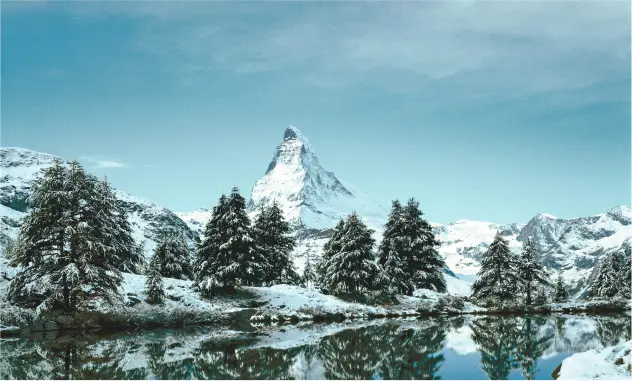
Combo Offer Conditions
- Last date of purchase: 30 th Apr 2024
- Offer applicable only on the 2 nd Class ticket of the Swiss Travel Pass
- Important Note: No two promotions / offers can be clubbed together.
About Swiss Travel Pass
Swiss travel pass is the ideal ticket to travel across switzerland..
You can enjoy unlimited access by public train, bus, and boat to visit more than 90 cities, reach peaks of many mountains, and sail through beautiful lakes in Switzerland with the Swiss Travel Pass. You also benefit from free entrance to 500+ museums, discounted city tours, and access to private and scenic trains with a pre-requisite seat reservation.
Swiss Travel Pass offers children up to the age of 16 travel free of charge, just select Swiss Family Card when you purchase your pass. There are two broad types of Swiss Travel Pass: Continuous and Flexi, with an option to choose from 3, 4, 6, 8, and 15 days. So, whether you are travelling alone or with family, Swiss Travel Pass is the most preferred option to experience Switzerland, while helping you save money in your journey.
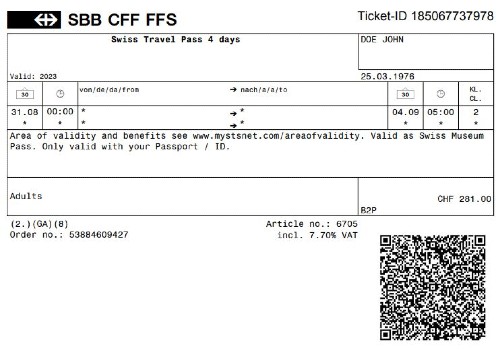
The Swiss Travel Pass is a must-have for any traveller to Switzerland.
Apart from it being an ‘all-in-one’ pass which allows a traveller to access all modes of public transportation within the country, it also offers numerous other benefits on the mountain excursions.
You can use trains, buses and even lake ferries to reach any destination including popular cities like Montreux, Lausanne, Zermatt, Geneva, Bern, Basel, Zurich and Lucerne.
Just reach your station or bus terminal or pier and hop on to the next available train or bus or boat for your destination. Allow them to take you through the most picturesque sceneries of your dream destination.
The Switzerland Rail Pass is the perfect partner whether you are looking to travel from town to town, or up to the mountains or off into the sunset on a cruise, hop on and off trains, buses and ferries at any time according to your wish for the day or time.
You only have to remember that there are some scenic train and bus routes that require a mandatory reservation. It would be wise to check with the ticket office before you board any such transport as it may not include in your Swiss Travel Pass cost .
If you are not looking to travel to a new destination but only within the town you are staying at, you can still use the Swiss Pass to move around town on the local buses or trams.
This way you can cover each of the towns and their attractions seamlessly with your Swiss Pass and make the most of it.
It is jam packed with bonuses! Free public transportation, discounted city tours (check at the local tourism offices in each place or at the stations), free entrances to over 500 museums, free boat trips and more are included in your Swiss Pass price.
The Swiss Travel Pass benefits not just passengers who want to be constantly on the move.
If you are one of those travellers who wants to spend time in each place and move to other places only after a few days, you can opt for the Swiss Travel Pass Flex which will allow you to use your days as and when you need them within a period of one month.
So be it the adventurous, the avid or the leisure traveller, you will have the chance to make the most of your Switzerland Rail Pass. Switzerland tourism also benefits from such an inclusive pass that eases the overall cost of the travellers and helps in exploring the alpine country freely.
Don’t forget your Swiss Pass is the most family friendly pass ever! It allows your children under 16 years to travel absolutely FREE with the Swiss Travel Pass Family Card !
Types of Swiss Pass
Validity: Valid on 3, 4, 6, 8 or 15 days Both the above passes are available in 1st and 2nd class and also offer the youth pass option for travellers under 25 years of age.
There are 2 types of Swiss Travel Passes:
Continuous and Flexi Swiss Passes
- Continuous Swiss Travel Pass The pass allows the passengers to travel on consecutive days depending on the number of days the pass is purchased for.
- The Swiss Travel Pass Flex This pass offers the same services and benefits as the Swiss Travel Pass but gives greater flexibility since it allows you to utilize the chosen number of days within a one month period.
Major Benefits of Switzerland Rail Pass
The Swiss Travel Pass is packed with benefits, some of which are listed below
- Unlimited Free travel on all public buses, boats and trams and trains in over 90 cities
- Free travel on panoramic trains (reservations may be needed)
- Free admission to over 500 museums
- Free mountain excursions: Rigi, Stoos and Stanserhorn
- Up to 50% Swiss Travel Pass discount on other mountain excursions
- Children under 16 years of age accompanied by at least one parent holding a valid Swiss Travel Pass, travel FREE with the Swiss Family Card.
- Available in electronic version making it really simple
- The Swiss Travel Pass is worth it when compared to multiple single-journey tickets
How and Where to Buy Swiss Travel Pass
Make sure that your Swiss Travel Pass is purchased from a reliable supplier. You can buy Swiss Travel Pass online on swisstours.com and the same will be instantly sent to your email id.
How to choose your Swiss Rail Pass
Depending on your Switzerland itinerary , create your Swiss Travel Pass itinerary. If you are in Switzerland for a short duration, it would be best to have a pass covering your entire stay. This way you will be able to use the pass on a daily basis for intercity and local public Switzerland transport as well.
If you are staying for a relatively longer period and are sure you will not be travelling every day, then you may want to consider the Swiss Travel Pass Flex so that you can use it only for your intended days of travel.
Basic steps to identifying your ideal Swiss Pass would be
- List your travel days and requirements
- Find out the point to point sector fares for the same
- Compare it to the cost of the available Swiss Pass cost
What are Swiss Travel Pass Inclusion?
Your Swiss Travel Pass offers unlimited travel all the public boats, trains, trams and buses in 90 cities and towns in Switzerland.
It also includes free transport to some of the mountains and discounted travel on many others. The pass also allows free entrance to over 500 museums on your Switzerland trip.
Top free museums
The Switzerland Train pass allows free entrance to almost 500 museums.
Some of the more popular ones are the Open-air museum in Ballenberg, The Tinguely Museum in Basel, the Richard Wagner Museum in Lucerne and the Einstein Museum in Bern.
Free and Discounted attractions
The Swiss Travel Pass allows free travel to some really popular mountains.
Travel to them for some amazing views over towns, lakes and nearby regions.
Just show your Switzerland train pass at the base stations of these mountains and take the next available transport to the peaks.
Free mountain excursions
- Stanserhorn
Top discounted mountains with Swiss Pass
Enjoying mountain excursions is always included in every traveller’s things to do in Switzerland
No Switzerland tour package is complete without visiting the most popular mountains. There are many mountains in each region that you can visit.
Your Swiss Travel Pass will allow you to avail of either discounted fares to reach these peaks by train, funicular or cable cars.
Some of the most popular mountain excursions and the places that you can reach them from are as follows :
- Jungfraujoch , Interlaken
- Mount Titlis , Lucerne
- Mount Pilatus, Lucerne
- Matterhorn Glacier Paradise, Zermatt
- Gornergrat, Zermatt
- Sunnegga Paradise, Montreux
- Glacier 3000 , Gstaad
Free boat cruises
Your Switzerland Rail Pass also covers the transport on some of the most beautiful lakes in Switzerland. Some popular cruises listed below. You just have to show your pass and hop on these cruises
There are also other lake cruises in Switzerland like the boat trip on the Rhine from Basel, on which you can use your with Swiss Travel Pass discount.
How to use a Switzerland Train Pass
The Switzerland Pass is super easy to use. All passes are now electronic passes making it really simple.
The Swiss Travel Pass 2022 is a pre validated pass. It is ready for travel once you have received and printed the same.
The PDF file that you receive will have a code that train staff can scan from your smart phone. However, officially you need a printout too, which is why it is always good to carry an A4 sized printout of the swisspass with you at all times
Once your swiss rail Pass is valid, you can use it for the number of days you purchased it for. The time of start does not matter.
The swisspass works on calendar days, which means if you have an 8 days Switzerland itinerary and purchased an Swiss Pass 8 Days starting on the 5th of May, the pass will be valid till midnight on the 12th of May.
You do not need seat reservations for trains and buses in Switzerland. You can simply board with your Swiss Travel Pass.
However there are exceptions - the panoramic trains like the Glacier Express which require a mandatory seat reservation at an extra cost. Seat reservations are not included in the swiss rail pass cost.
If you are travelling to a mountain or using any other discounted service, you must keep in mind that one of your Swiss Travel Pass will be used that day. You will be requested to show your Swiss Train Pass and the purchased mountain voucher at the boarding point of such services.
Electronic passes or e-Swiss Travel Pass
The Swiss Rail Pass is an electronic pass.
The electronic Switzerland Rail Pass can be shown on your smart phone or as an A4 size print whenever requested for by the checker.
Remember that you must also have your passport in hand incase it is asked for along with the Swiss Travel Pass.
Where is the Switzerland Travel Pass valid
Your Switzerland Travel Pass is valid throughout the country. Some of the most popular places that you can visit and stay at with your Swiss Train pass are
It is the industrial, financial, and cultural centre of the country and one of the most cosmopolitan and dynamic Swiss cities. Throughout the city centre, green space extends to the shores of Lake Zürich, which are lined by attractive public parks, and up to the slopes of Zürichberg.
Zürich’s lively and well-preserved Altstadt (Old Town), part of the city centre, boasts an architectural legacy including the Romanesque Grossmünster, built by Charlemagne in the 700s; the 13th-century St. Peter’s Church; and elegant guild houses and patrician residences, some of which are used as restaurants or for civic functions.
Among the must see places in Zurich are the Grossmünster, The Fraumunster, Uetliberg- Zurich;s own mountain, Zurich Lake and the famous Bahnofstrasse where you can see all the high end luxury shops and indulge in some retail therapy. Don’t forget your Swiss Pass price includes the tram network of the city making all these places very accessible to you.
Lucerne or Luzern as it is called, is divided into two parts by the Reuss River, which is crossed by seven bridges within the town.
Lucerne has one of the most picturesque settings in Switzerland. The Spreuerbrücke (1407), which is now considered the oldest bridge, is roofed and decorated with 56 paintings including scenes from the Dance of Death from the early 17th century.
Until its destruction by fire in 1993, the Kapellbrücke or the more popularly called Chapel Bridge, was the oldest bridge.
The old town is distinguished by well-preserved 14th-century town walls with nine watchtowers, quaint alleys, and squares. It houses the old town hall, the historical museum, St. Peter’s Chapel, the Hofkirche, the Lion Monument and the Swiss Museum of Transport .
You can use your Swiss Train Pass to cover the things to do in Lucerne town using its buses and boat cruises.
You can take one of the free boat cruises or opt for the Lucerne Dinner Cruise or the Saphir boat cruises both of which are discounted on the Switzerland Travel pass
Interlaken is a town in Central Switzerland in the Bernese Highlands. The town gets Its name from its position nestled between 2 lakes: Lake Brienz to the east and Thun to the west. It is one of Switzerland’s oldest and most frequented summer tourist resorts.
The main attraction of this tiny town is its main avenue, the Höheweg, which is lined with numerous watch and jewellery shops, souvenir shops and hotels that range from modest hostels to luxury and boutique hotels.
Interlaken commands a magnificent view of the Jungfrau to the south and is a starting point for many Alpine excursions.
Closer to home it has the Harder Kulm which you can visit for a lovely snack and an amazing view over the town. Your Swiss Travel Pass allows you to travel on the buses and trains that connect this city and run between Interlaken ost (East) and West.
Interlaken is also a perfect base if you want to stay for a few days and cover the rest of the country from there. Among the things to do in Interlaken includes the Trummelbach falls, and Giesbach Falls.
The nearby towns of Thun, Brienz and Grindelwald are also a huge attraction. You can also take a boat cruise for free on the Lakes with your Swiss Travel Pass or else opt for the adrenaline pumping jet boat cruise (payable).
The town itself is at an elevation of 5,302 feet and commands some of the finest views in Switzerland and is also a popular centre for mountaineering and winter sports. Cableways are numerous, and the highest in Europe leads up the Klein-Matterhorn.
Equipped with your Switzerland Train pass, you can visit one or more of the most popular mountain excursions: the Matterhorn Glacier Paradise with Swiss Pass discount, the Gornergrat or the Rothorn Paradise.
Zermatt is one of the most beautiful places to visit in Switzerland in winter .
Your Swiss Travel pass allows you unlimited access on all of these peaks.
A town that offers it all, lakes, mountains and vineyards, Montreux offers a picture perfect landscape.
It is the perfect base from which you can cover the full Geneva region including Geneva and Lausanne.
Montreux and the nearby region has been immortalised by many celebrities. Freddy Mercury’s album cover for Made in Heaven is picturised here, Charlie Chaplin chose to spend the last 2 decades and more of his life in the region. Visit the Chillon Castle, walk the lake promenade, visit the casino and enjoy the unmatched beauty of this lakeside resort with your convenient Swisspass.
Take a boat cruise and reach Lausanne, visit the nearby cheese factory in Gruyeres or the buildings of the UN and the famous jet D’eau in Geneva.
Your Switzerland Train Pass will allow you to get up close to all of the must-see places in the region
Montreux and the nearby region has been immortalised by many celebrities. Freddy Mercury’s album cover for Made in Heaven is picturised here, Charlie Chaplin chose to spend the last 2 decades and more of his life in the region.
Visit the Chillon Castle, walk the lake promenade, visit the casino and enjoy the unmatched beauty of this lakeside resort with your conveneient Swiss Travel pass.
If you are on honeymoon in Switzerland , Montreux is a must-visit place for you.
Your Switzerland Train Pass will allow you to get up close to all of the must-see places in the region.
Lugano, the largest city in the Canton of Ticino is situated in the Southern Italian speaking belt.
Lugano lies in a bay on the northern side of Lake Lugano, surrounded by numerous mountains offering splendid viewpoints. Thanks to its mild climate, Lugano is a popular all round tourist destination.
Lugano is famous for its lake promenade with lush green vegetation, parks with sub- tropical plants and wood carvings.
It also has 2 mountains which make for nice excursions Monte San Salvatore and Monte Brè, give you an outstanding panorama of the town, Lake Lugano and the alpine scenery.
From Monte Brè there is a walk down to the village of Brè, which has preserved its typical Ticino village centre, and enhanced it with works of art.
From the San Salvatore another popular walk leads down through the beautifully situated Carona to Lake Lugano at Morcote. Taking a boat trip back to Lugano is a splendid way to round off the day.
Other excursions are to the fishing village of Gandria, up the Monte San Giorgio or the Monte Generoso or to the Lilliput world of Switzerland in Miniature at Melide.
All in all Lugano is a place to eat, chat and enjoy the mild Mediterranean atmosphere. The Swiss Travel Pass will help you to discover this regions. You can use it on the buses, boats and trams that connect the region.
Taking a boat trip back to Lugano is a splendid way to round off the day. Other excursions are to the fishing village of Gandria, up the Monte San Giorgio or the Monte Generoso or to the Lilliput world of Switzerland in Miniature at Melide ( Swiss Miniatur ).
All in all Lugano is a place to eat, chat and enjoy the mild Mediterranean atmosphere. The Swiss Pass offers you to discover this regions. You can use it on the buses, boats and trams that connect the region.
Scenic routes on Switzerland Train Pass
All you need to do to avail of this amazing journey is purchase a reservation for the segment needed and then use the same with your Switzerland Travel Pass.
Journey time:
Total journey time: The entire route takes almost 5.5 hours.
Segments: Montreux to Zweisimmen, Zweisimmen to Interlaken, Interlaken to Lucerne
Highlight: VIP seats Montreux to Zweisimmen
Your Swiss Travel Pass offers you to travel on some of the most beautiful routes and trains that the country offers.
Glacier Express
Sit back and prepare to be amazed!! You are aboard the Glacier Express, the slowest express train in the world!!
The panoramic journey on the Glacier Express through the Swiss Alps is one to remember. Start off in St. Moritz, the playground of the rich and famous and travel to Zermatt, the home to the world's most photographed mountain, the Matterhorn.
This 8-hour journey takes you over 291 bridges and through 91 tunnels. Along with the eyes, feast your palate as well! Order the meal freshly prepared on board and served at your seat.
All you have to do now is learn more about the route through the Alps via headphone – making sure you don't miss a single highlight.
To make the experience even more special, opt for the Glacier Express Excellence The new Excellence Class sets standards as high as the mountain peaks along the legendary route.
All you need to do to avail of this amazing journey is purchase a reservation for the segment needed and then use the same with your Switzerland Train pass
Total journey time: 7.30 hours
Zermatt to St Moritz or vice versa
Along the way: Oberalp pass, Rhine Gorge, Landwasser viaduct
Bernina Express
Go from snow- capped mountains to palm fringed lakes all in a day! Switzerland’s South is arguably the most stunning. It is also the melting pot of its various cultures and languages.
Traverse through this enchanting wonderland of diverse landscapes through towns dotted with castles, lake rivieras and UNESCO World heritage sites on the unique Bernina Express journey via bus and train.
Travel in Spring if you want to see the perfect combination of green valleys and lots of snow in the mountains. In winter, the section from St. Moritz to Tirano is especially worth it.
Book the most famous routes from St Moritz to Lugano via Tirano in Italy on this famous train and bus combination and make your holiday truly special with a discount with the Swiss Pass .
All you need to do to avail of this amazing journey is purchase a reservation for the segment needed and then use the same with your Switzerland Rail Pass
Average journey time: 4 hours
Chur / Davos / St Moritz to Tirano
Bus from Tirano to Lugano
Highlights: 196 bridges, 55 tunnels, UNESCO World Heritage site
Golden Pass Line
A cross-country journey like no other! The 3 train journeys that make up the amazing Golden Pass Line route takes you from the pristine Lake Geneva region, past the Bernese Oberland and into the historical heart of Switzerland.
Start your Switzerland Tour by taking off from Montreux say goodbye to the Mediterranean ambience and the views of Lake Geneva.
In Zweisimmen, be prepared for a treat if you have booked early enough and are privileged enough to get the seats with the drivers eye view. Then sit back and relax on the Lucerne Interlaken Express which passes through amazing lake vistas and the Brunig pass before getting you into Lucerne.
Why To Buy Swiss Travel Pass
- Unlimited Access to Rail, Boat, and Bus in 90+ Towns and Cities
- Free Entry at 500+ Museums
- Up to 50% Discount on Many Mountain Excursions and Rail Travel
- Children Entry Free
How It Works
Select your swiss travel pass.
Choose the right Swiss Travel Pass that suits your requirements in terms of number of days, and class of travel.
Confirmation
Follow the step-by-step booking procedure which allows you to view rates, select total number of passengers and see your total amount payable before you make the final booking.

Make the Payment
After selection of the pass and submission of your details (name, date of birth, email id etc.) you will be directed to the 3D secured payment page where you can make payment by Debit/ Credit Card/ Net Banking/ UPI.
Time to Travel like a Swiss
Once you have made the payment, you will immediately receive a confirmation email from us. You can download your e-Swiss Travel Pass from your email (a download link will be in the email).
* If you need assistance in selecting the right Swiss Travel Pass for you, please contact us.
* If you are travelling to multiple countries in Europe, you can also book rail passes of other countries with us.
Photo Gallery
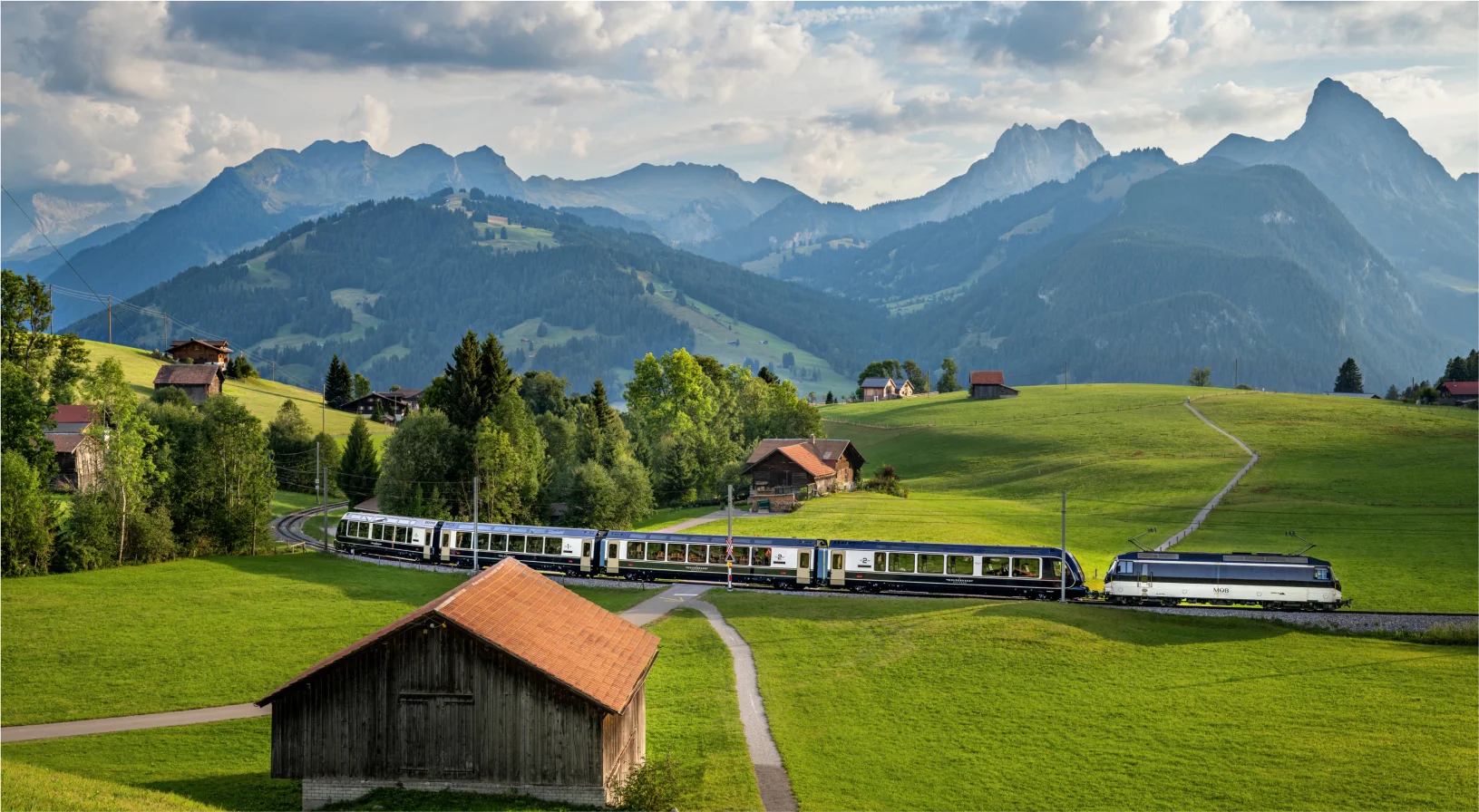
FAQs on Swiss Travel Pass
What is a swiss travel pass.
A Swiss Travel Pass is a pass that allows you to access unlimited travel on a train, bus, boat, and tram across Switzerland’s public transport and provides up to 50% discounts on excursions.
Where can I use my Swiss Travel Pass?
You can use your Swiss Travel Pass in the whole Swiss Travel System : in all trains, post buses, trams & even boats.
How do I book the Swiss Travel Pass online with Swisstours?
- Book your pass on www.swisstours.com by clicking on the Swiss Travel Pass tab on the home page.
- From the list of passes, select the Swiss Travel Pass that suits your travel requirements in terms of the number of days, 1st or 2nd class and consecutive or Flexi days’ pass.
- If you need help selecting the most appropriate pass, contact our specialists at [email protected]
- After selection of the pass and submission of your details (name, date of travel, and other mandatory information) you will be directed to the payment page to make the payment.
- Once the payment is complete, you will immediately receive an e-Swiss Travel Pass voucher in your email as an attachment.
How can I validate my Swiss Travel Pass?
Effective 1st September 2015, the Swiss Travel Pass is a pre validated & closed dated pass.
The traveller will need to provide their first day of use of the pass while making the booking. This date will be printed on the pass.
Travellers must carry a valid passport in order to travel with this rail pass.
What is an adult pass?
A passenger 25 yrs and above is entitled to purchase an adult Swiss Travel Pass.
What is a youth pass ?
A person under 25 yrs can purchase a youth Swiss Travel Pass.
Are there family passes?
The Swiss travel system offers the Swiss family card. This card provides free travel for children under 16 years when travelling with atleast one parent.
What is the difference between a Consecutive-day pass and a Flexi pass?
A consecutive-day pass provides unlimited rail travel on all days for the chosen duration of the pass. This pass is preferred by those who wish to travel every day during their stay in Switzerland. A flexi pass is valid for a specific number of days which can be used consecutively or non-consecutively within a longer period. This pass is preferred by those who wish to travel only on certain days during their stay in Switzerland.
Till what age can children travel free on the Swiss transport system?
Children under 16 years of age accompanied by at least one parent can travel free on the Swiss travel system. Children travelling without parents can still avail of a 50% discount on the Swiss travel pass.
Is reservation on trains compulsory if I have a Swiss Travel Pass?
Swiss Travel Pass is valid on trains operated by SBB (Schweizerische BundesBahn), the national railway company of Switzerland. For domestic trains operated in Switzerland, seat reservations are not required. Exceptions are the special scenic trains such as Bernina Express, Glacier Express, Golden Pass and Wilhelm Tell Express. For these trains, a supplement and/or seat reservation is required for Swiss Travel Pass holders.
What is the cancellation charge if I am unable to use my Swiss Travel Pass?
- Refundable up to 2 days prior to first date of validity with an administrative fee of CHF 10 per pass.
- Thereafter, no refund. If pass is used or flexi days are activated, non-refundable.
- Once the pass has been cancelled the passenger will not be able to use it.
Can Mountain excursions be bought along with the Swiss Travel Pass?
Yes, you can surely buy the mountain excursions online with the Swiss Travel Pass and benefit from upto 50% discounted rates. Once you have purchased your Swiss Travel Pass you can add the desired mountain excursions to your shopping cart and pay for all services at one go.
The mountains in the combo offer are added to the Swiss Pass. Kindly select your number of Swiss Pass days and click ‘Book Now’ to proceed with the combo offer.
A Swiss Half Fare Card is valid for one month. It doesn’t have to be the first day of a month. You can choose any start date you want. For example: you can start the validity period on August 10. In this case, September 9 is the last day you can use it.
Validity ends at 5: 00 AM of the day following the last day.In the above example, validity ends on September 10, 5: 00 AM.
- Once booking is complete, you will receive a PDF file on the email ID entered at the time of boking. Keep that on your smartphone. The file contains a code that train staff can scan. Alternatively carry a print on plain A4 paper.
- The pass is good to use as it has all the necessary information, such as the start date, passenger name, and birth date. Your passport number won't be included on the card. If your name is too long to fit, it might be shortened on the pass, but that's not an issue.
- You don’t have to link your pass to any account, such as a SwissPass account or the SBB App.
- Proof of owning a Swiss Half Fare Card is not required at the time of ticket purchase; it will be verified on board.
- Most trains in Switzerland don't require seat reservations. With your Swiss Half Fare Card and a discounted ticket, you can board the train. However, panoramic trains require compulsory seat reservations.
- Tour Account ›
- Travel Forum ›
- Travel Forum
- Switzerland
- 1st class vs 2nd ...
1st class vs 2nd class
As I’m planning our week long Switzerland leg for this summer, I had a question about 1st class vs 2nd class train tickets. Is it worth the extra 33% for 1st class in Switzerland? When traveling to/from big cities on big trains I often appreciate the difference 1st class gives us. However, I know in smaller regions there often isn’t much of a difference at all.
We are tentatively planning on flying into Zürich (1 night), Appenzell (2 nights), Berner Oberland (3 nights), and Bern (1 night) before moving on. Is there much difference on these trains between classes?
I’m also looking into possibly shuffling the days around and completing the Golden Pass train ride...would this make a difference in 1st vs 2nd class?
Thanks in advance for any help or insight! We’re excited for this summer!!
There is a difference between 1st and 2nd class, but not enough, IMO, to justify the price difference.
My first trip to Europe was a business trip and the company paid for everything, including first class rail transportation. The next trip was on my own dime, and I couldn't afford first class, so I bought a 2nd class pass. Looking back, I can't say there was a significant difference between the classes. On my third trip, a business trip again completely paid for by the company, I used only 2nd class; I couldn't bring myself to spend company money on what I felt was a needless luxury. Since than (11 trips, all on my own) I have only traveled 2nd class and have no regrets.
2nd class is quite nice in Switzerland. Only the last portion of the Golden Pass (between Zweisimmen and Montreux) and in one of the Golden Pass's reservations-only specialty train carriages in that section of the route is worth upgrading to first class. (The specialty carriages are the Classic "Belle Epoque" or the modern VIP train coaches.)
In France if I am riding the TGV on a multi-hour journey, I pay extra for the 1st class reservations, have done obviously both classes on the TGV with mandatory reservations. When I am taking the Paris Est to Frankfurt Hbf route, regardless of direction, I book the 92 days out discount ticket, 49 Euro in 1st class, ten less in 2nd, on the TGV. I take the 1st class reservation.
I never bother with first class tickets as second class is perfectly comfortable and civilized. Most journeys are only a few hours so I don't see any reason to spend extra money, especially in a country where everything is so expensive.
Last Autumn I took two train rides, both were around 3 hours long, and I wished I had booked first class for both 3 hour train rides. But just tooling around little Switzerland, I guess I wouldn't bother with the upgrade. However, I think I would reserve if you have 2 or more.
We've done both. Overall on long journeys my husband has a strong preference for 1st class. However, for the most part in Switzerland it really doesn't matter. We spend most of our time in the BO and I would never pay to upgrade there. It makes no sense. Really 2nd class is fine - I think my husband mostly prefers it as it is usually less crowded:)
of course you know that the scenery out the window is the same regardless of which class, and both classes get to the destination at the same time.
If you want to see some pictures of what first class and second class seating in Swiss trains looks like, go to The Man In Seat 61: https://www.seat61.com/Swiss-trains.htm#What%20are%20Swiss%20trains%20like
The percentage number depends on which direction you do the math. Normally, you expect to add 50% to 2nd class to get 1st or to deduct 33% from 1st class to get 2nd.
In the case of Switzerland, if you start with 2nd-class rates, you add 58% to get 1st class on a Swiss Travel Pass or add 75% on a point-to-point ticket (e.g., Geneva-Zurich at either 89 or 156 chf).
This topic has been automatically closed due to a period of inactivity.
Swiss first class review: Is it worth paying $1,000 to $2,000 to upgrade?

Quick take: Swiss first class is one of the most exclusive airline experiences in the world. While tickets can be expensive, booking a business-class award and using cash to upgrade might be well worth the expense to enjoy the sheer luxury of flying up front with this exceptional airline.
- Sleek, comfortable cabin and seats
- Luxurious, elegant lounges
- Warm, professional service on the ground and in the air
- Difficult to book with points
- Outdated hard product
- Lackluster entertainment options
Switzerland is one of the world's wealthiest countries, and its flag carrier is one of the few airlines that has continued to offer a first-class cabin on all of its long-haul wide-body aircraft. After all, Swiss targets a demographic that can afford luxurious experiences.
Unfortunately for us points and miles enthusiasts, the airline doesn't make first-class award seats available to members of partner frequent flyer programs (in contrast to its sibling Lufthansa, which opens first-class award space to partners 15 days before departure ). However, there is a reasonable way to fly Swiss first class using partner points to book a flight in business class and then upgrade to first class using cash. But the question is: Is it worth the price tag, which can be around $2,000 each way between Europe and the U.S.?
Want more airline-specific news? Sign up for TPG's free biweekly Aviation newsletter .
I'm a big fan of Swiss design (I even used the Swiss first-class cabins and lounges as inspiration to decorate my house's interior four years ago). I have flown business class with the airline just once from Zurich Airport (ZRH) to Chicago's O'Hare International Airport (ORD) in 2018 and was impressed by the food and customer service. However, in October 2023, after a 10-day road trip through Oman and a three-day stopover in Zurich, I was offered an upgrade to first class on my flight to Boston Logan International Airport (BOS), and I took it.
Here's what my experience in Swiss first class was like, including what to expect when it comes to the seats, the service, the meals and the amenities, so you can determine whether an upgrade is worth it to you.
How much does first class cost to book on Swiss?
There are several ways to book Swiss first class:
- Book a cash fare in first class
- Book a cash fare in business class and then upgrade to first class with cash (explained below)
- Hold Lufthansa Miles & More Senator or HON Circle elite status and redeem Miles & More miles
- Redeem partner points or miles to book business class and upgrade with cash at check-in (explained below)
- Redeem partner points or miles, such as United MileagePlus miles, but only on Swiss' fifth-freedom route between Sao Paulo and Buenos Aires, Argentina
The main way most TPG readers will likely book Swiss first class is to use a Star Alliance points currency, such as United MileagePlus miles or Air Canada Aeroplan points, to make a business-class redemption.
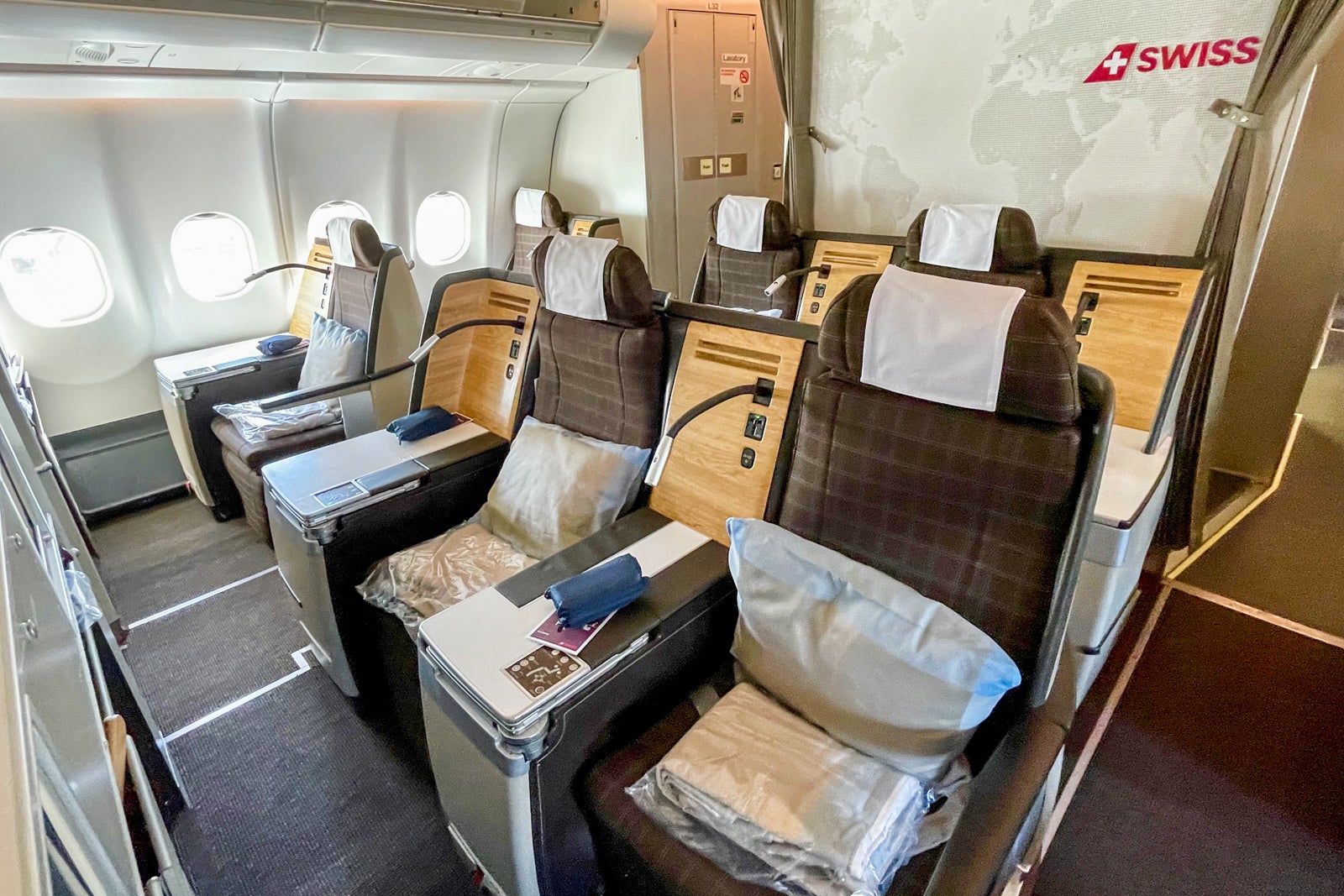
Here's a look at what round-trip airfares were like on my route between Boston and Zurich.
If you book a business-class ticket like I did, you can check in at the airport or online up to 24 hours before departure. When you do, you may be offered a cash upgrade to first class. On routes between the U.S. and Switzerland, you can expect to pay $1,000 to $2,000, depending on the flight duration, the departure airport and the number of seats available.
I redeemed 63,000 Avianca LifeMiles and paid $101 in taxes for a one-way business-class flight from Zurich to Boston in October 2023. When checking in online 24 hours before departure, I was offered an upgrade to first class for 1,680 Swiss francs (approximately $1,860), and I took it.
I used The Platinum Card® from American Express to earn 5 points per dollar spent on my airfare purchase (to earn 5 points per dollar spent on flights with the Amex Platinum, flights need to be booked directly with airlines or through Amex Travel, on up to $500,000 on these purchases per calendar year). This netted me 9,300 American Express Membership Rewards points, which are worth $186 based on TPG's valuations — effectively a 10% rebate on my purchase.
Alternatively, if you use cash or Miles & More miles to book your business-class ticket, you can submit a bid upgrade up to 48 hours before departure.
Swiss first class is offered on all the airline's wide-body aircraft — namely, the Boeing 777, the Airbus A330 and the Airbus A340. The seats on the 777 and the A340 are superior to the A330 one that I flew in several ways, which I'll get into below.
Swiss — along with Lufthansa — is planning to introduce new first- and business-class products in 2025, but that timing has been pushed back a couple of times and might be again. So, for now, let's focus on the current product.
First class is available on long-haul routes from Swiss' hub in Zurich and its focus city of Geneva to major U.S. airports (mainly Star Alliance hubs), including ones in Boston, Chicago, Los Angeles, Miami, Newark, New York, San Francisco and Washington. The carrier also flies to other large international cities, such as Tokyo and Johannesburg.
Checking into and boarding first class on Swiss
The Swiss first-class ground experience is most luxurious when departing or connecting through the airline's main gateway, Zurich. Swiss first-class passengers can expect the following priority services at the airport.
Departing from or connecting through Zurich
At Zurich, the airline has a dedicated first-class check-in "lounge" — which is more like a compact space — at the Check-in 1 area of the main terminal. It's ideal for those arriving at the airport by car.
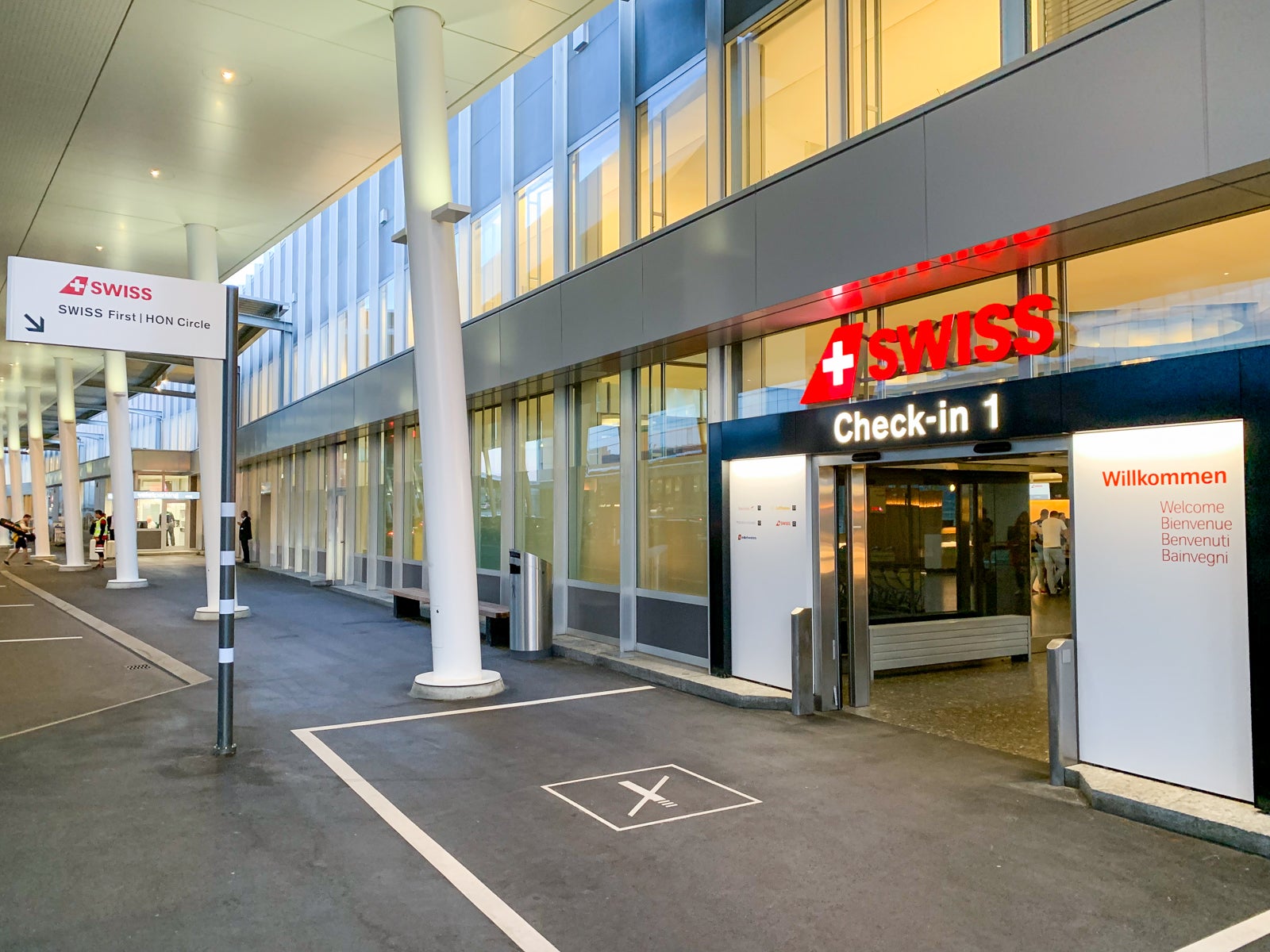
If traveling by train, you can either check your bags and get your boarding pass (if you haven't checked in online) at the Check-in 3 area near the airport's train station or walk 10 minutes to the first-class check-in lounge.
I arrived at the airport three hours before my 1 p.m. departure. Even though I already had my boarding pass on my phone and wasn't checking any bags, I wanted to experience the check-in lounge. Unfortunately, there are very few signs posted for those who don't arrive by car. I entered the lounge through the back (terminal) entrance rather than the car (exterior) entrance, and the lounge attendants seemed surprised that I was flying in first class but not arriving by car.
I was escorted to the lounge — just a one-minute walk away — by an agent who took my carry-on bag for me. You'll be allowed two carry-on bags of 8 kilograms (17 pounds) each and two checked bags of 32 kilograms (70 pounds) each. Those traveling on paid first-class fares get an extra checked bag for a total of three.
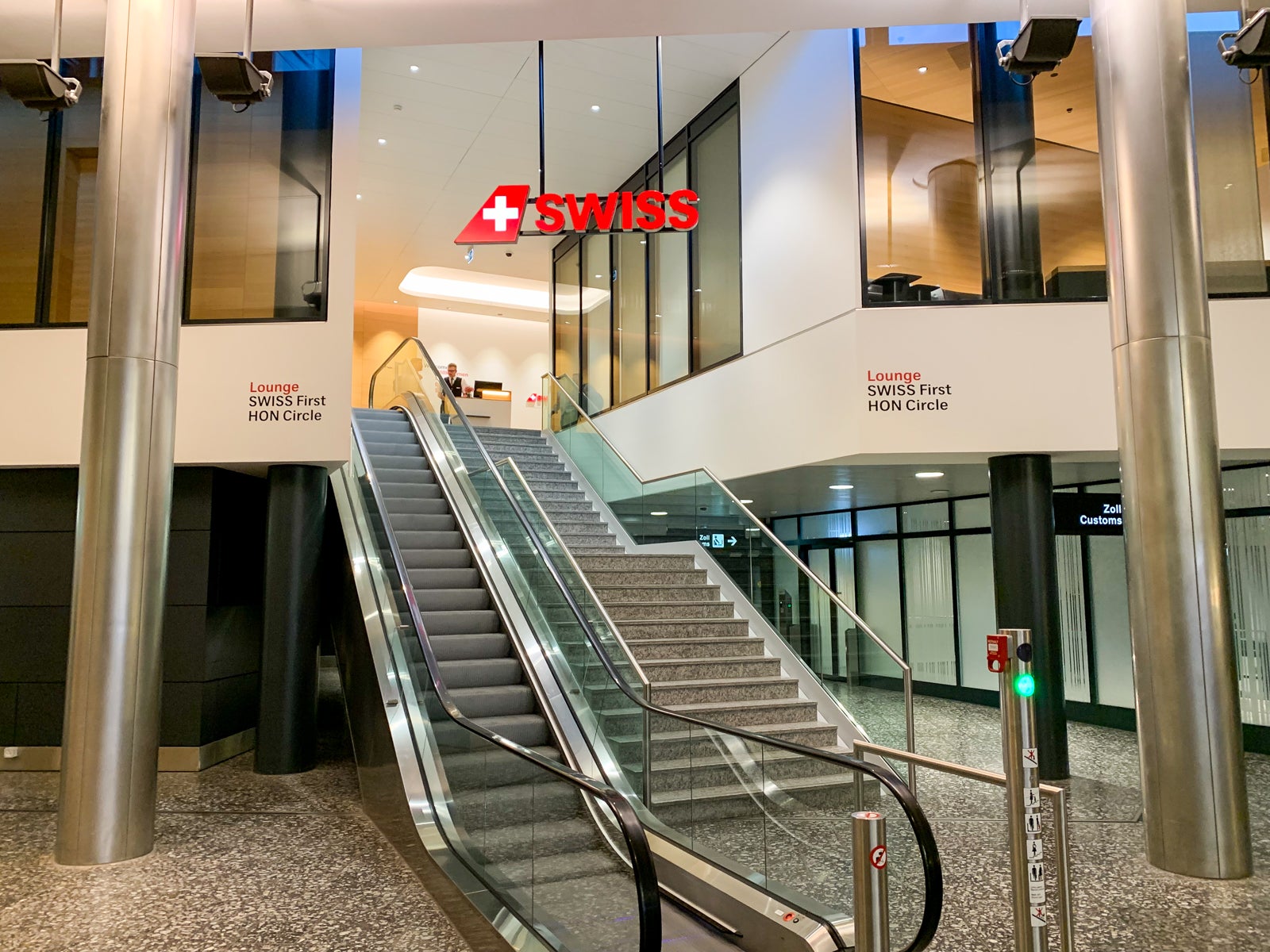
Swiss first-class lounge access
Swiss has two first-class lounges at Zurich: the perfectly acceptable Terminal A lounge for Schengen-zone departures and the much more luxurious Terminal E lounge for non-Schengen flights, including those to the U.S. When departing from Zurich, you need to pass through the Terminal A lounge to get to the Terminal E lounge.
Upon taking the escalator up to the Terminal A lounge entrance, I was greeted by name and swept through a private security area — just like at the Lufthansa First Class Terminal in Frankfurt — in under a minute.
Then, I was warmly welcomed at the customer service desk, where the agent explained the lounge's amenities, directed me to the Wi-Fi passcode machine and booked a private van transfer to the Terminal E lounge, which usually runs every 10 minutes, though I had a 15-minute wait. I was asked to be at the waiting area a couple of minutes before departure; a lounge attendant didn't come and get me when it was time.
Then, I was handed off to a brusque agent at the document check desk opposite the welcome desk to stamp my boarding pass for transfer out of the Schengen zone.
During my 15 minutes in the Terminal A facility, I wandered around the small, quiet lounge, which seemed custom-built for transiting business travelers. Staff told me that passengers usually don't spend much time here, with only eight dining tables for two people each.
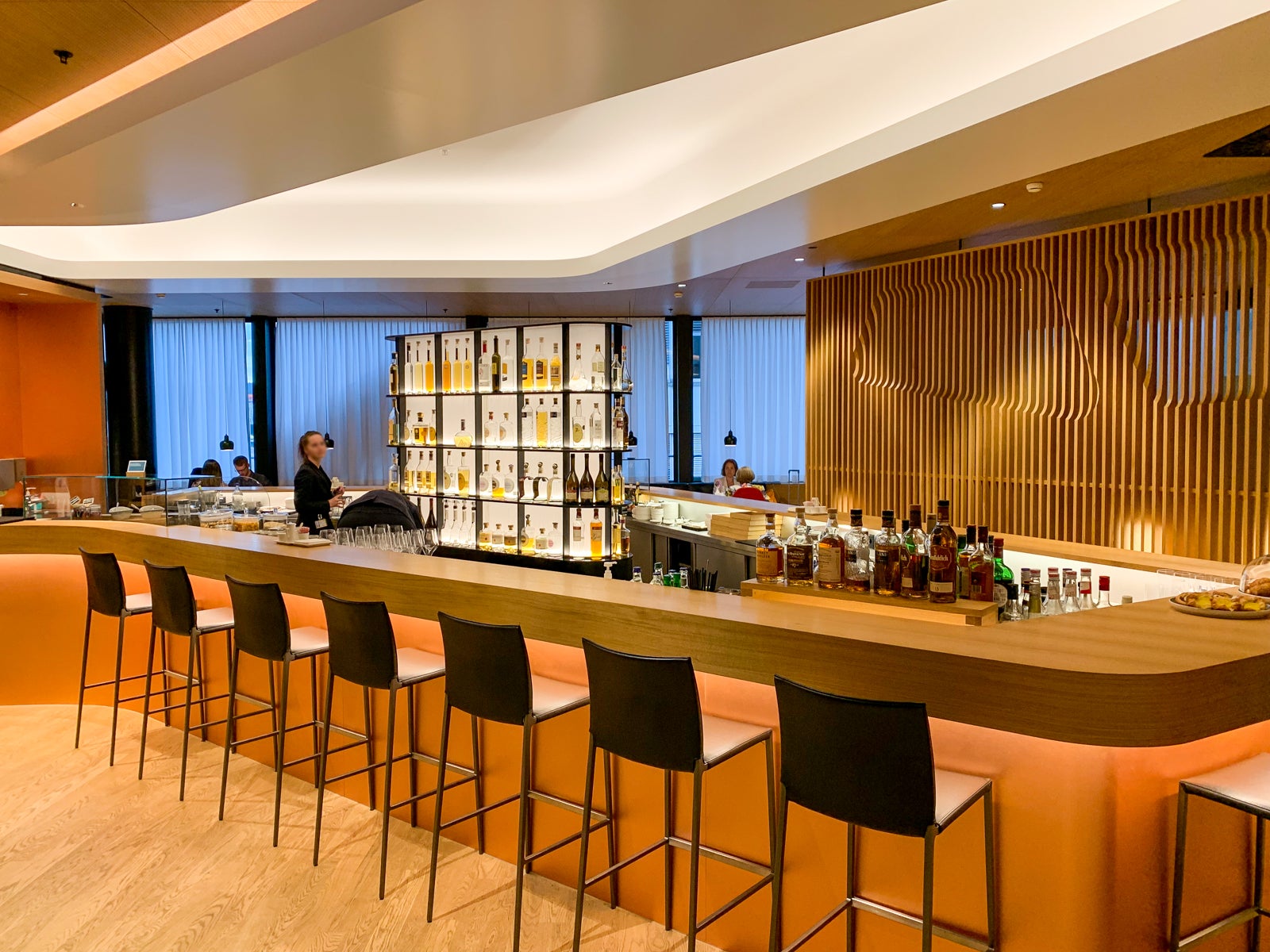
Three minutes before my van departure time, I followed the limousine service signs to the end of a hallway, where I was escorted with one other passenger downstairs to a private passport control kiosk (which took all of 15 seconds for each passenger) and into a Mercedes passenger van. In a nice touch, the van's seats were the same style as — but much narrower than — the seats on board Swiss' aircraft.
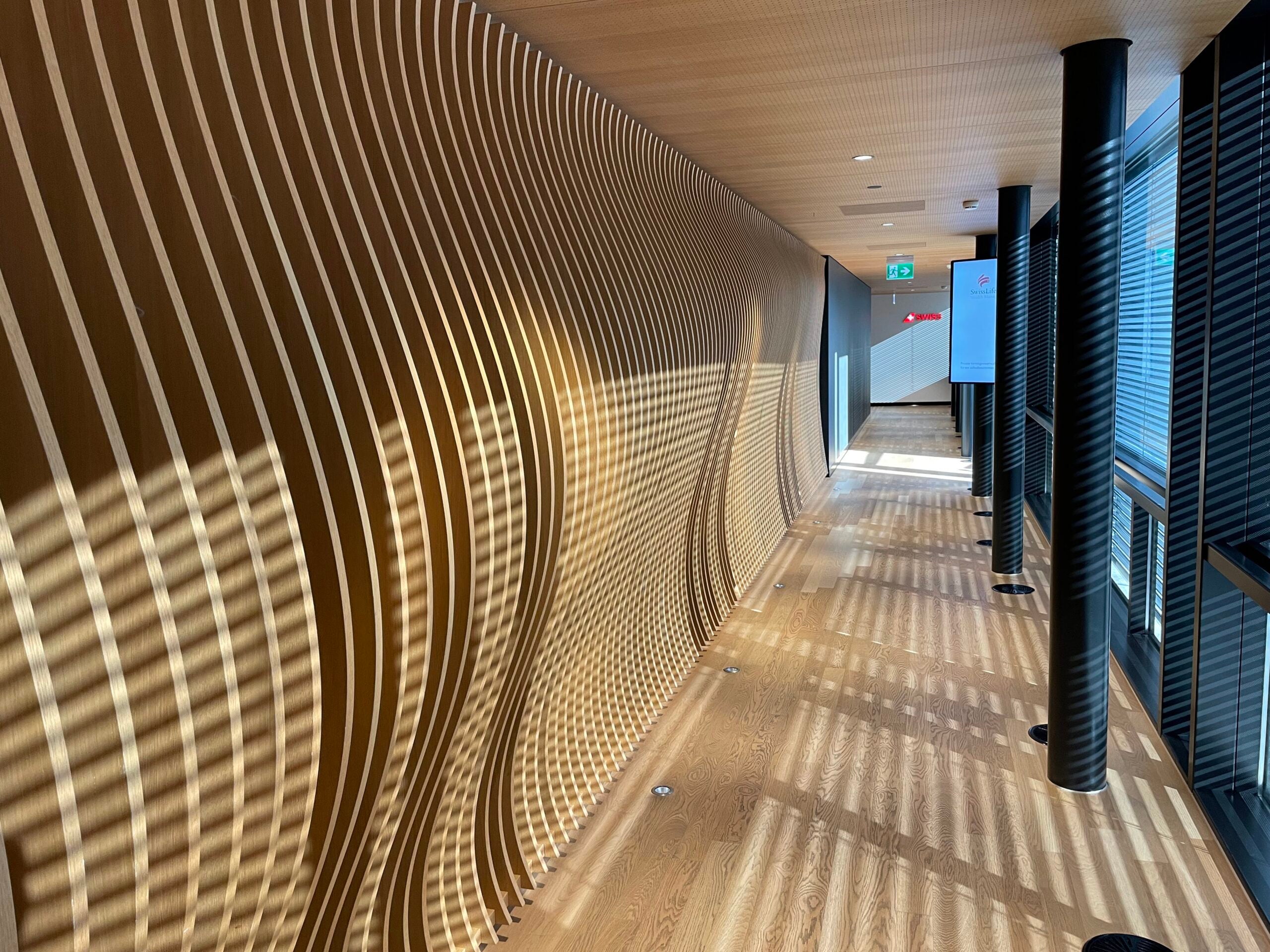
After a seven-minute drive across the tarmac, we hopped out of the van, into an elevator and were again warmly welcomed by two very professional staff members at the Terminal E lounge entrance.
The highlights of this 2,460-square-foot space were the Champagne bar, its simple but stylish furniture, an a la carte dining section, an open-air terrace for beautiful views of the tarmac and two dayrooms with plush bedding and ensuite showers that you can book at reception. Unfortunately, both dayrooms were occupied during my visit, though my colleague, Zach Griff, was able to snap some shots on a past visit for reference. There are also showers available outside of the dayrooms.
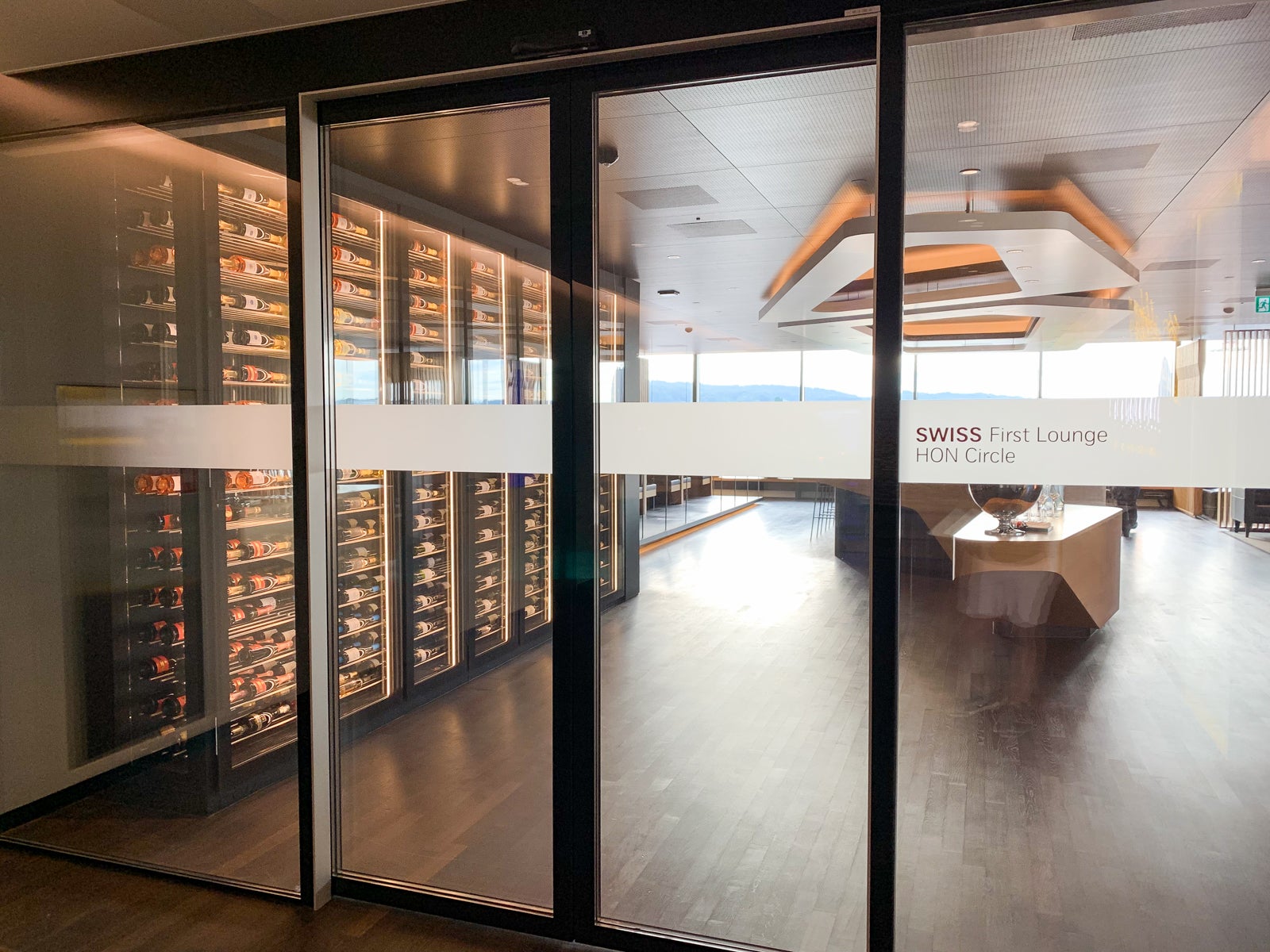
If you have the time, order the five-course "Taste of Switzerland" menu, which changes seasonally. During my autumn visit, there were fried scallops, a potato-pear soup, venison with plum gravy, pumpkin pie with rosehip ice cream and elderberry sorbet on the menu.
If you are short on time (as I was), you can pick from a variety of a la carte options. For breakfast or brunch, available items include a full English breakfast, eggs Benedict and made-to-order omelets. For lunch and dinner, options range from a Caesar salad and beef tartar to Zurich-style sliced veal and Swiss cheese fondue.
While the Champagne bar sounds fancy, most of the Lombard and Bauget-Jouette products can be purchased for $50 to $60 per bottle, so they're not necessarily that fancy.
If you have the time and interest, ask the reception staff to escort you to the 28/10 Whisky Club in the adjacent Senator Lounge, offering complimentary tastings of over 200 varieties of whisky.
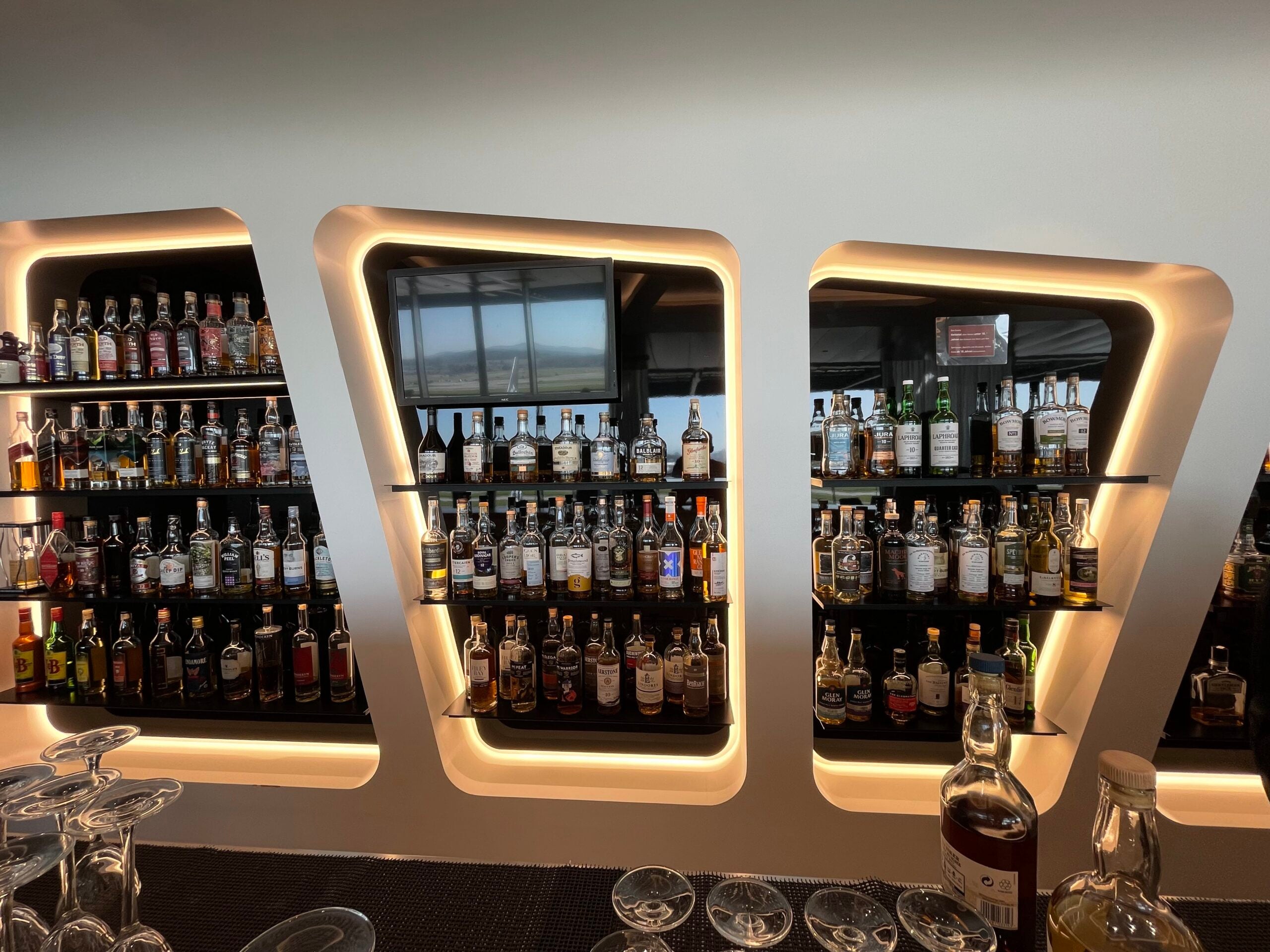
Arriving in Zurich
If traveling to Zurich in Swiss first class, you'll be greeted upon arrival and driven to a private passport control area. If connecting to another flight, you'll be escorted to the relevant lounge (A for Schengen departures; E for non-Schengen).
If Zurich is your final destination, you'll pass through customs and can access an arrivals lounge with a buffet and showers. It's open from 6 a.m. to 1 p.m.
Departing from other airports
If departing from Geneva, you'll access a compact 650-square-foot first-class lounge with a buffet and no showers.
When departing from most Star Alliance hubs in the U.S., such as Chicago, Los Angeles, Newark, San Francisco and Washington, Swiss first-class passengers have access to United's Polaris lounges .
In Boston and New York, Swiss first-class passengers have access to a special area within the Lufthansa lounge ; in Miami, they can access the Turkish Airlines lounge .
First-class passengers must make their own way to the boarding gate (no chauffeur or escort service is available here).
First-class passengers (along with HON Circle elite status members) board as Group 1 after passengers needing special assistance. Boarding commenced five minutes late for my flight.
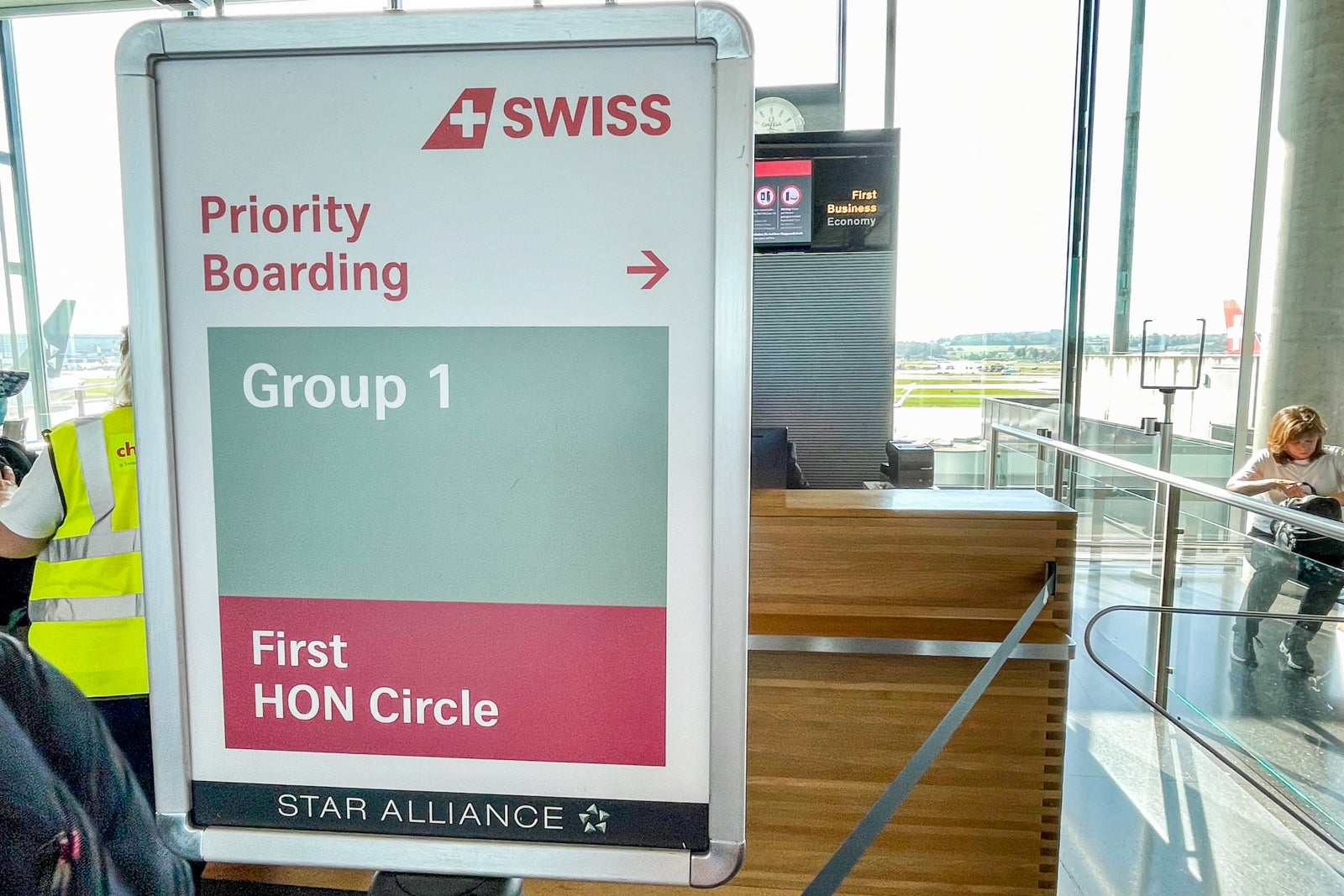
How comfortable was first class on Swiss?
Swiss first class has eight suites set up in a 1-2-1 configuration. Here are more details on the cabin and seats.
In my opinion, it's best to choose a seat in Row 2 to avoid noise from the galley in front, which is where the flight attendants work. Immediately behind first class is a two-row business-class section with the business-class galley and lavatories aft of that and the main business-class cabin behind, so you should have very little noise, light or movement between the first- and business-class cabins.
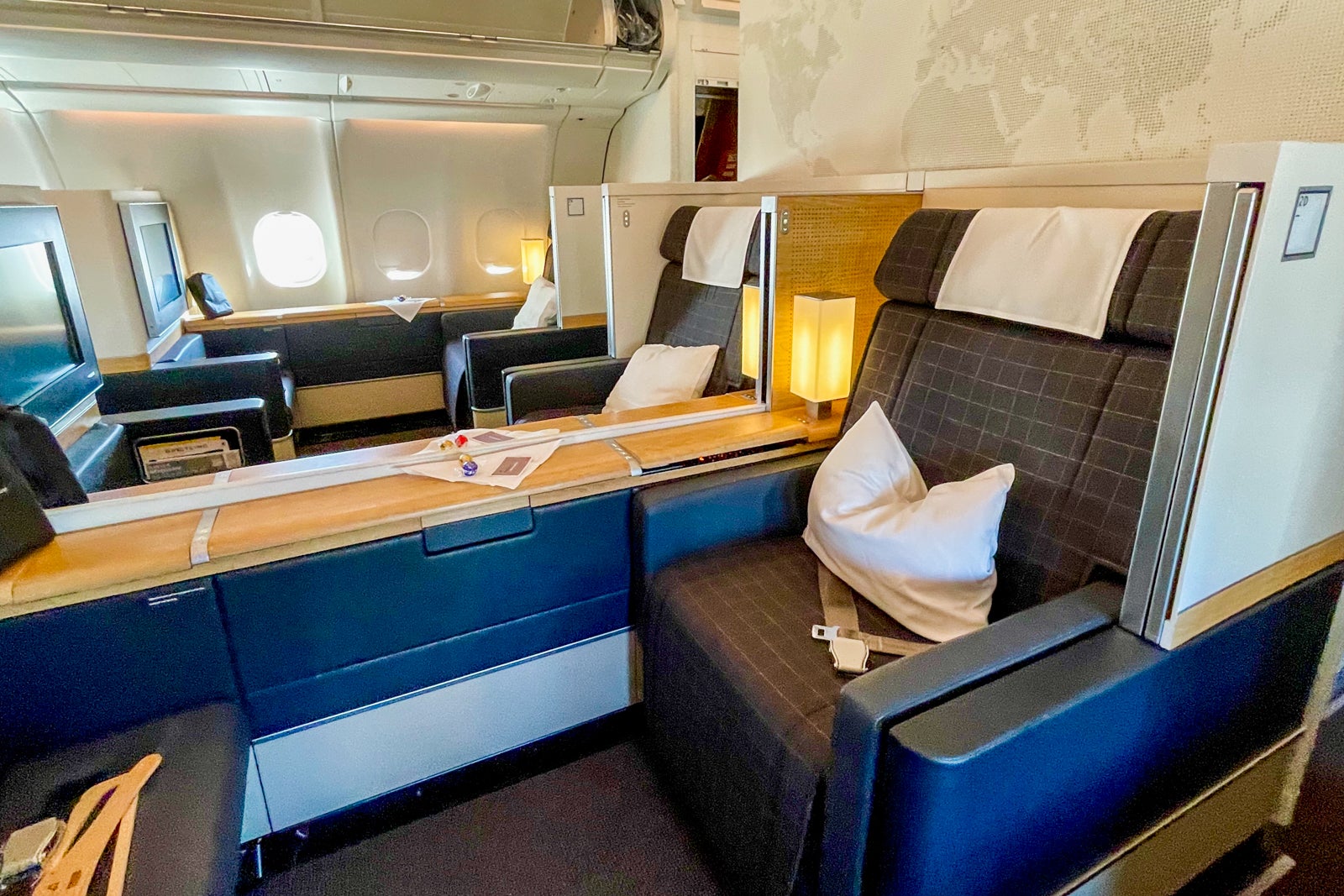
On my flight, six of the eight first-class seats were occupied, with all passengers having upgraded themselves. (I found this out by asking them — they were a chatty bunch!)
The 22-inch-wide seats are luxurious, minimalist and comfortable. They have built-in massage functions and memory foam cushions, enhancing the overall sense of elegance and sophistication thanks to the square-patterned upholstery and sleek wood finishes.
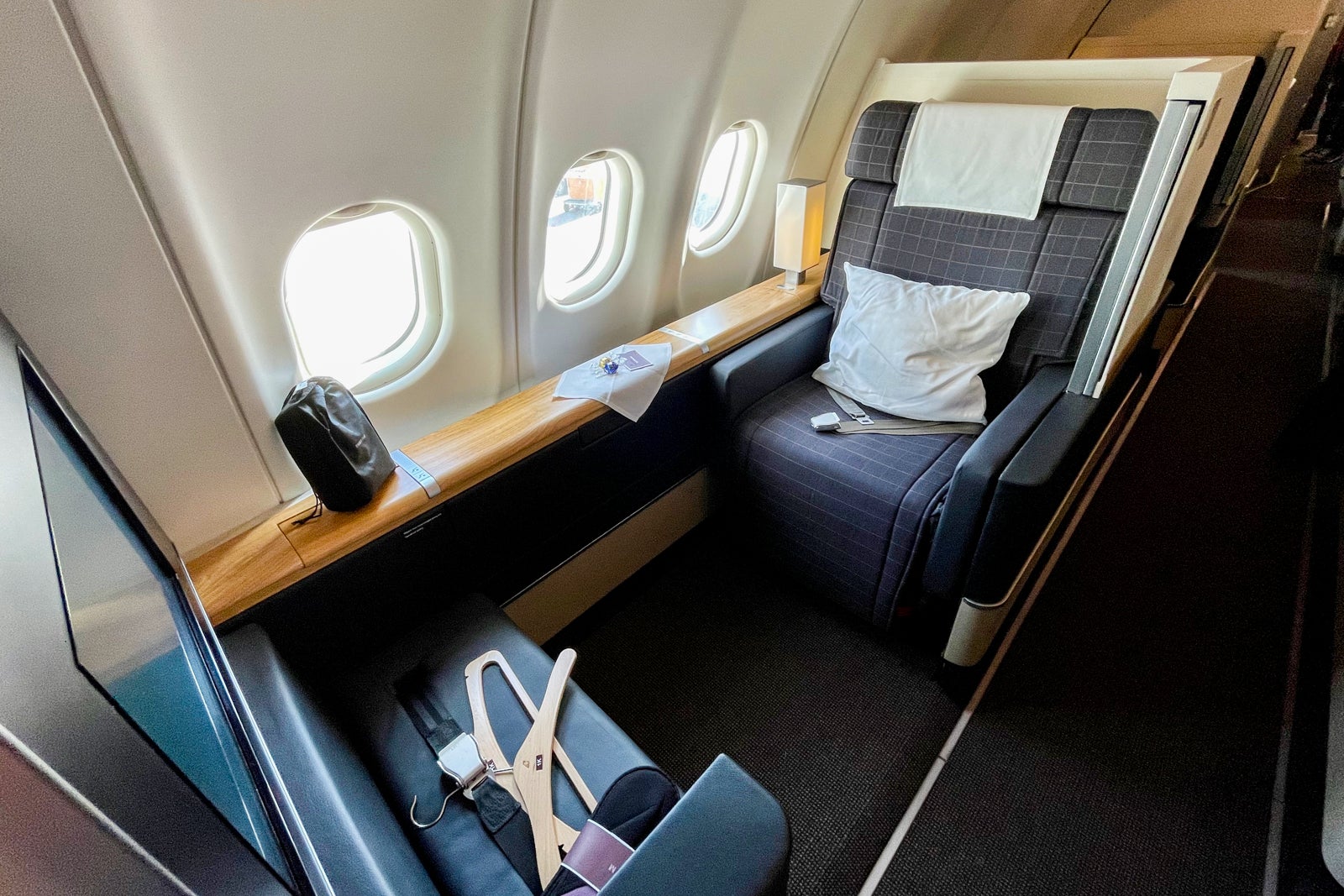
There are far more contemporary first-class seats out there, but their sleek design and spaciousness are the main draws.
As for variations between the three aircraft types, the 777 and the A340 are superior to the A330 in three ways — but the A330 wins in one (small) area.
Firstly and most importantly, the 777 and the A340 have sliding screens that almost close completely, giving you a sense of privacy as you can see from my colleague, Zach Griff's, photos of his 777 experience.
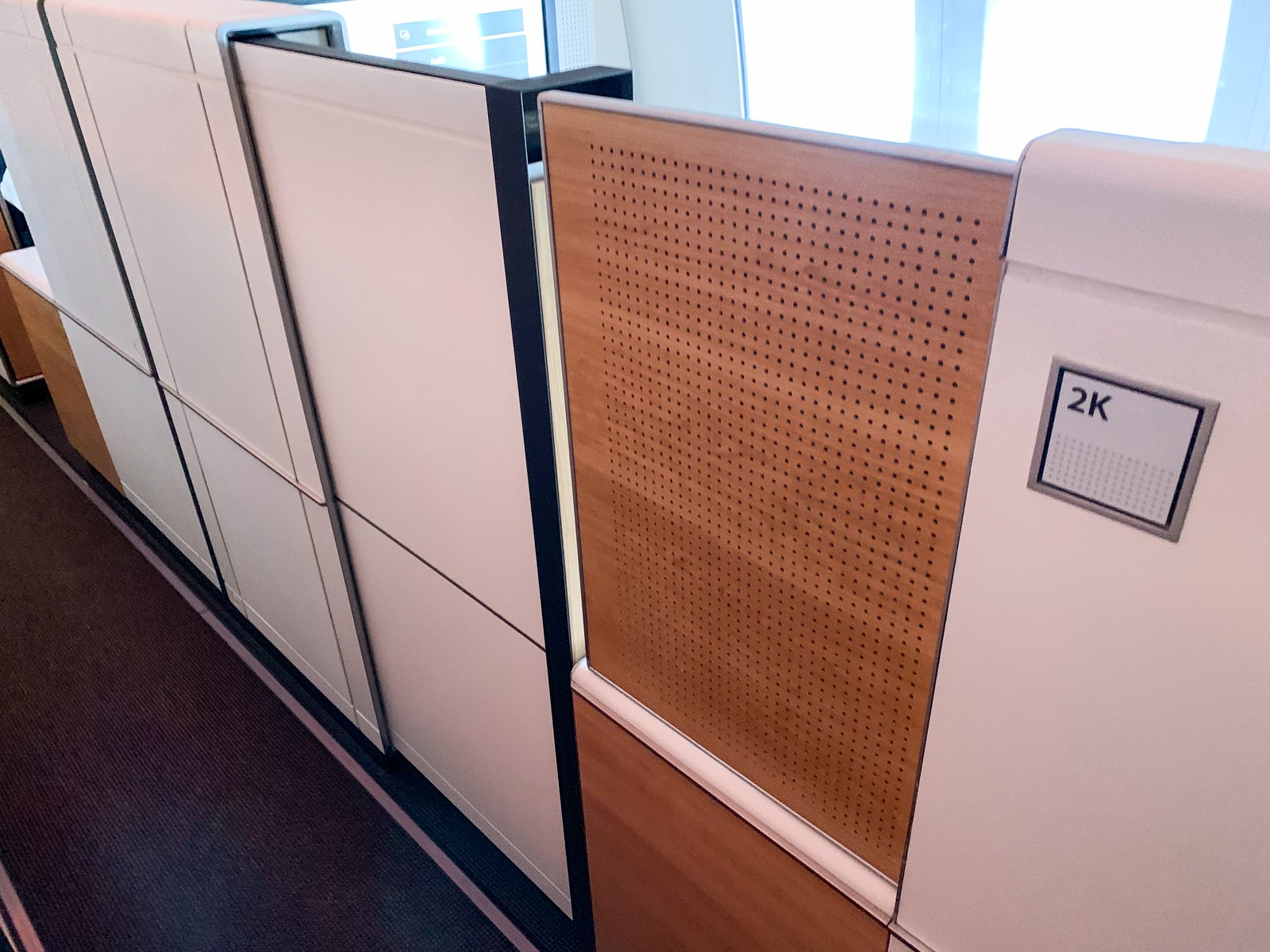
On the A330, you'll get a sliding privacy partition that extends about a third of the way across the suite's opening but must be in its retracted position during taxi, takeoff and landing.
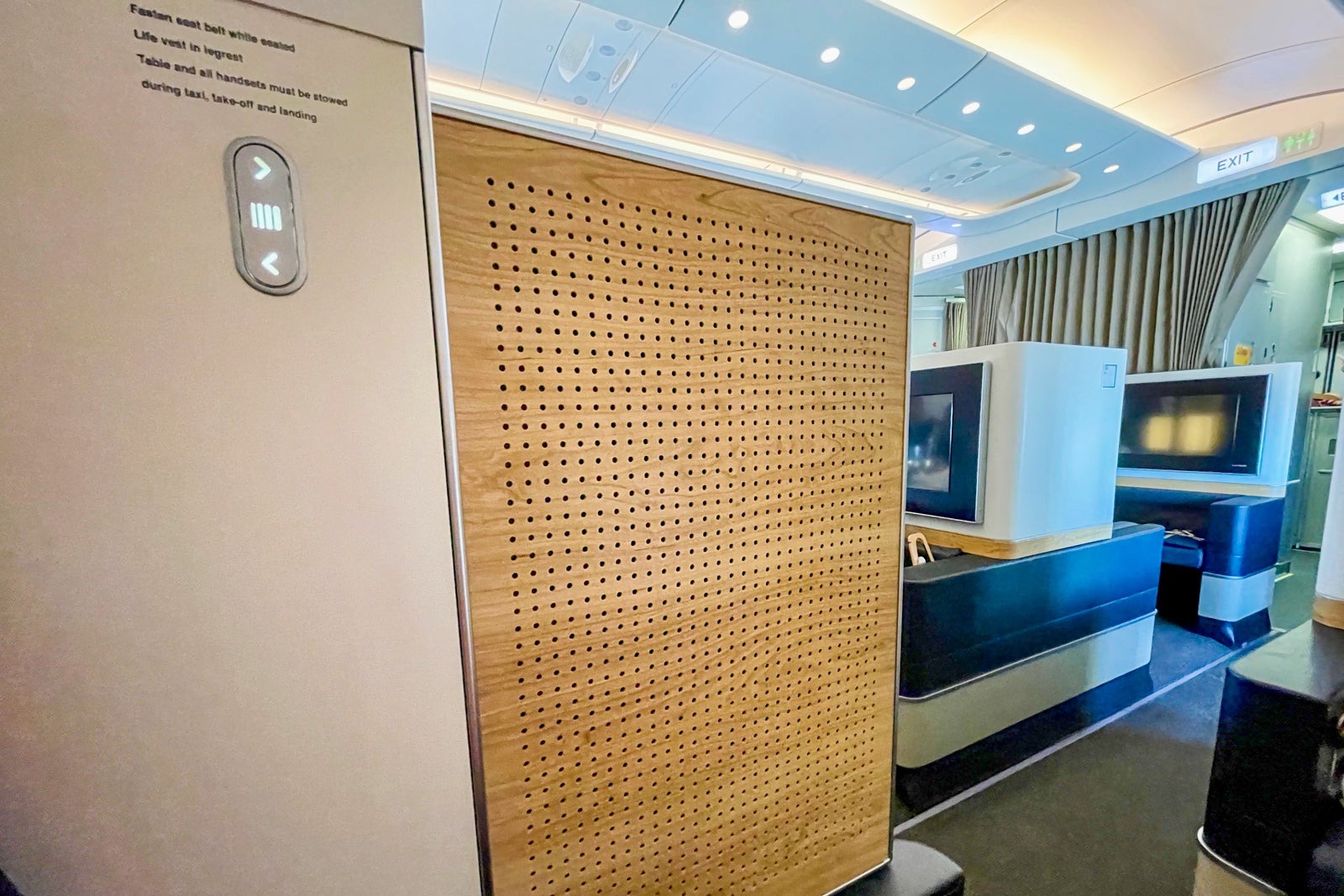
Secondly, the 777 and the A340 have a private wardrobe embedded in the seat's wall, whereas anything to hang on a coathanger on the A330 must be stowed away in the galley by the crew.
Thirdly, there are three windows to each first-class window seat on all three aircraft types. On the 777 and the A340, blackout shades and accordion shades are electronically controlled, as Zach's 777 shots show.
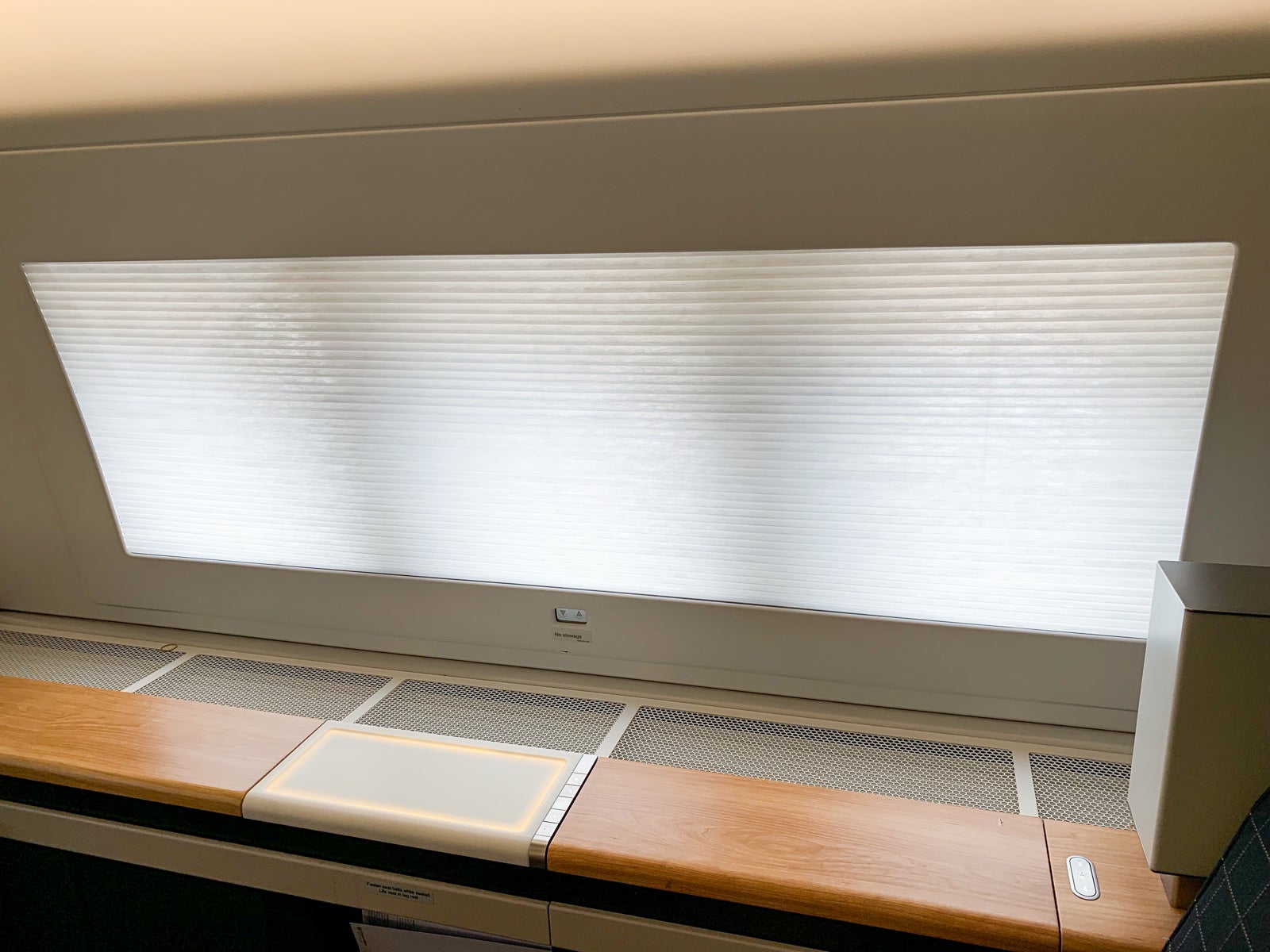
By contrast, the A330 has regular manually operated window shades. The only area where the A330 wins is having individual air nozzles, which the 777 and the A340 do not, so you can control your zone's temperature more easily.
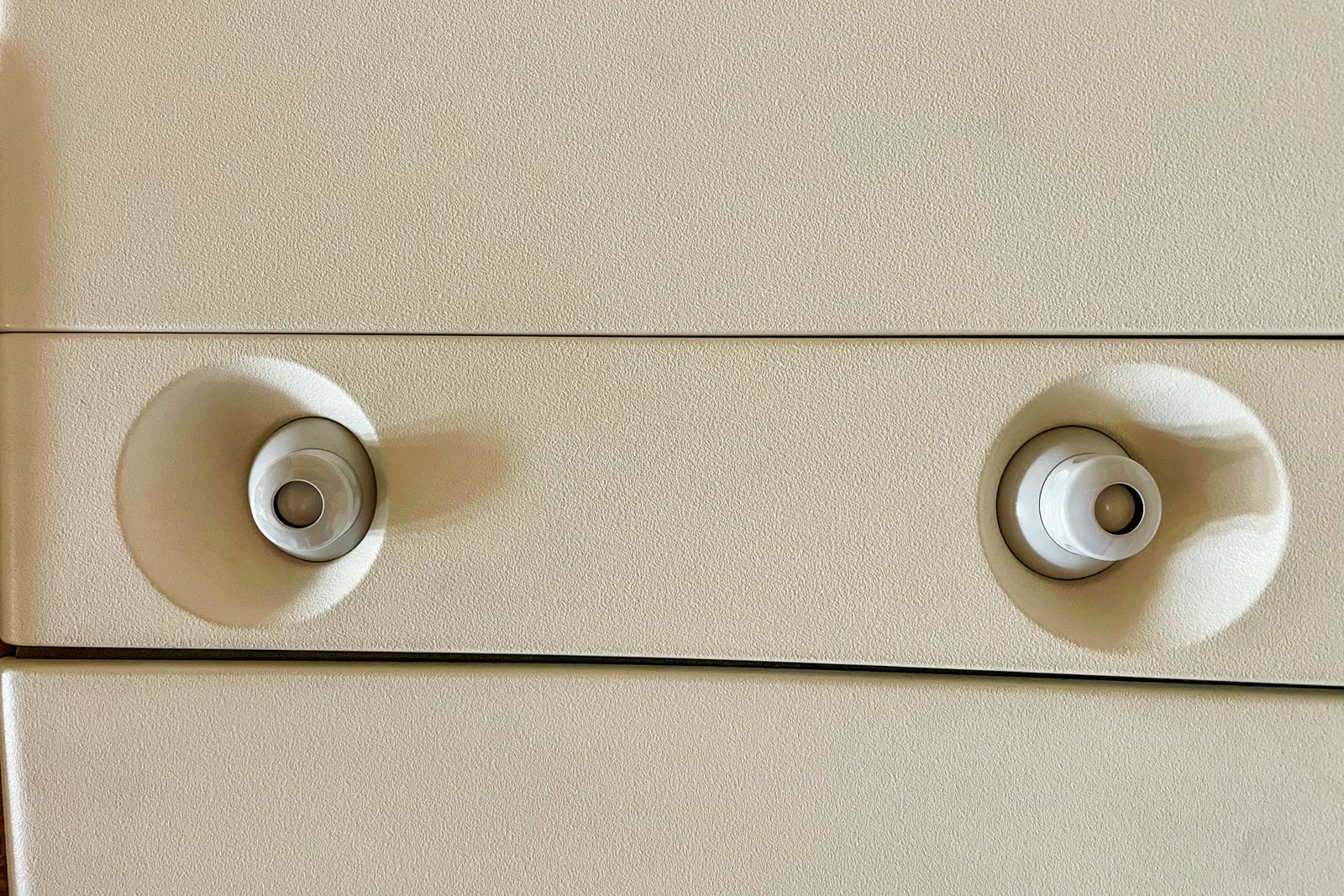
A rectangular, dimmable accent lamp adds to the elegant feeling of the seat but is inopportunely placed, as it gets in the way if you want to lean your arm on the side table.
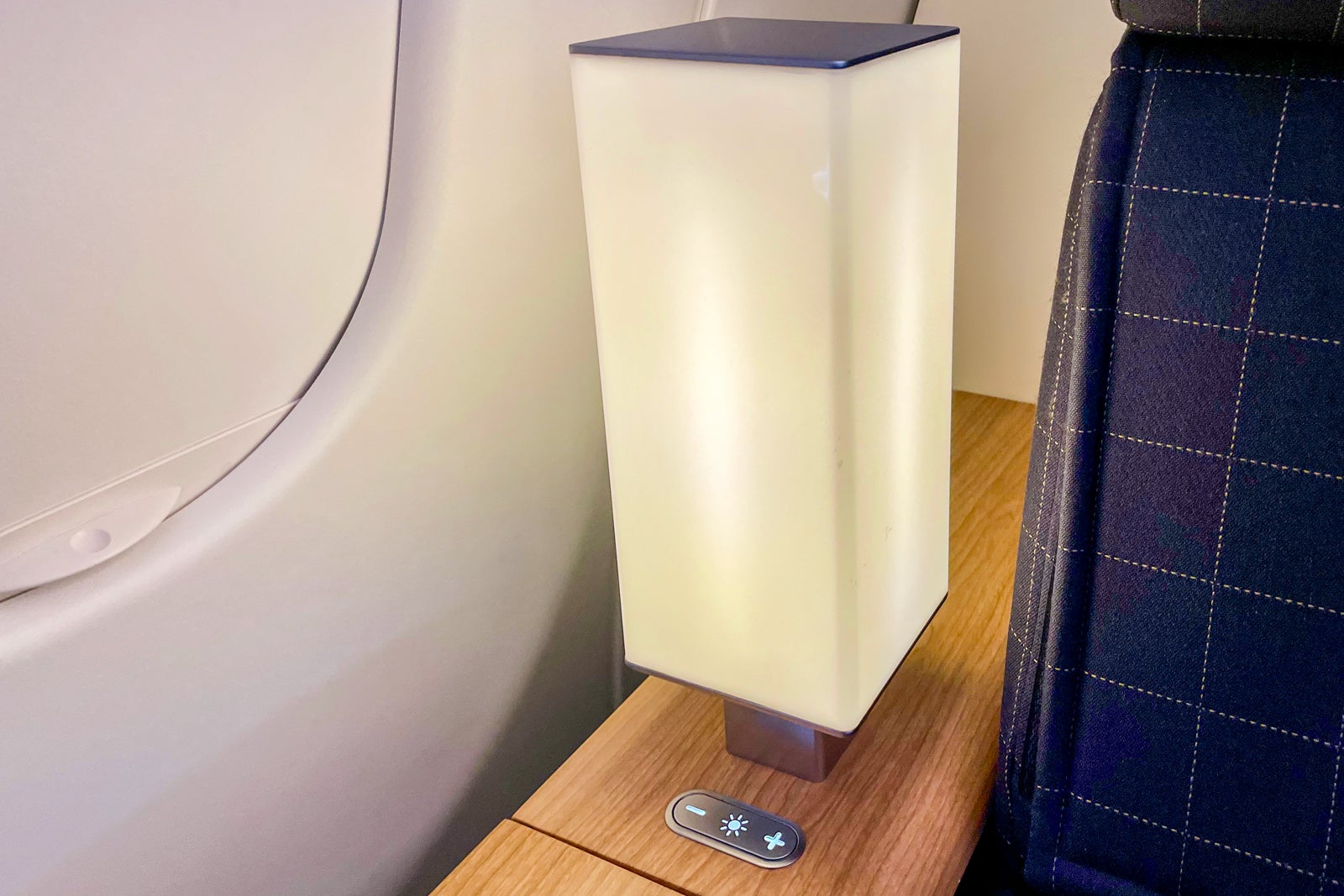
A huge 25-by-24-inch dining table pops out from the side of the suite and is one of the largest tables I've dined at while in the air. The seat's ottoman has a seat belt so you can even dine with a companion.
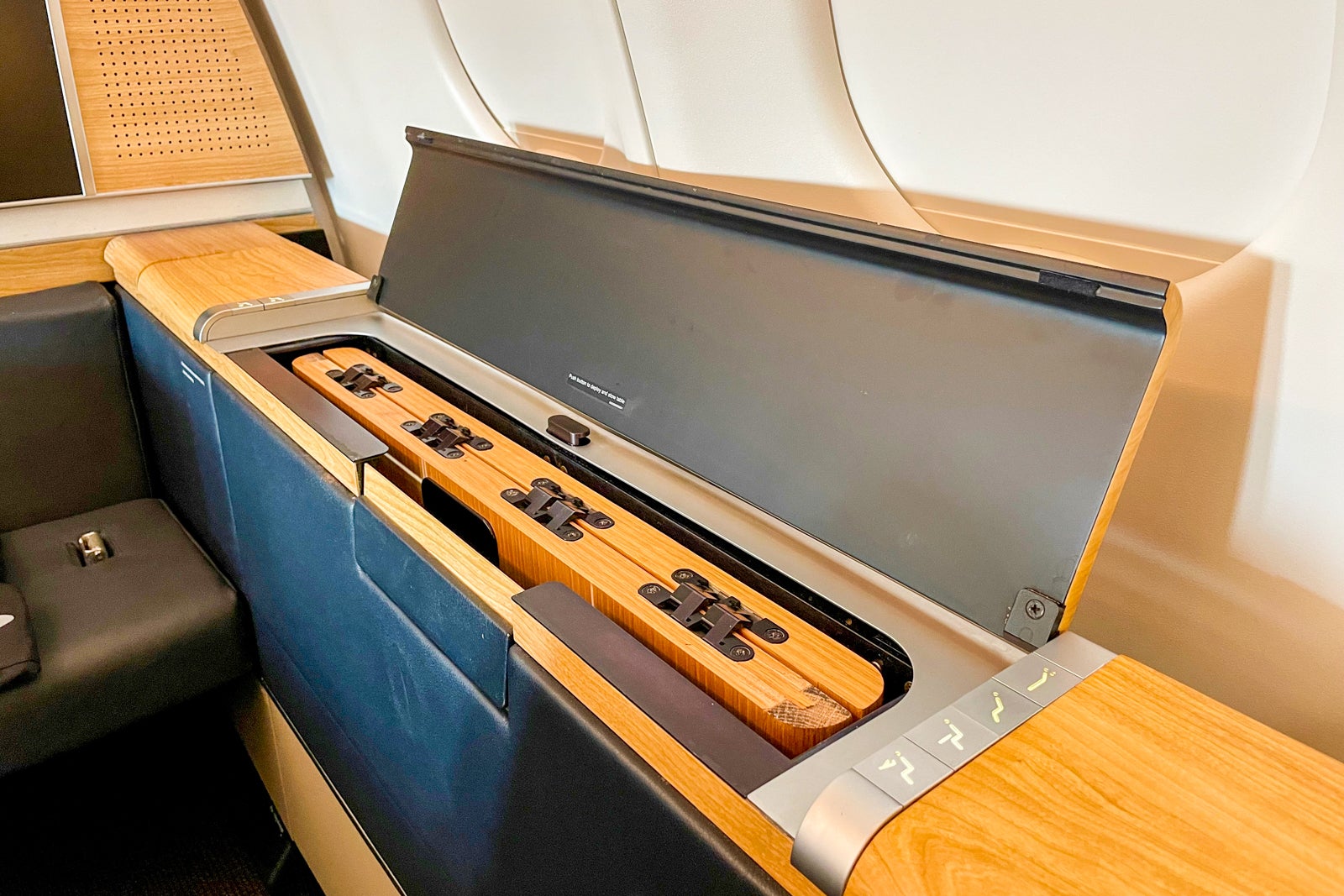
After finishing my main meal, the crew offered a turndown service while I changed into my pajamas. I returned to a very cozy setup, with two large, soft pillows; a mattress pad; and a thick duvet for the 80-inch-long bed. However, even with the individual air nozzles blasting air on my seat, the duvet was too thick for me to sleep restfully, so I stayed mostly uncovered.
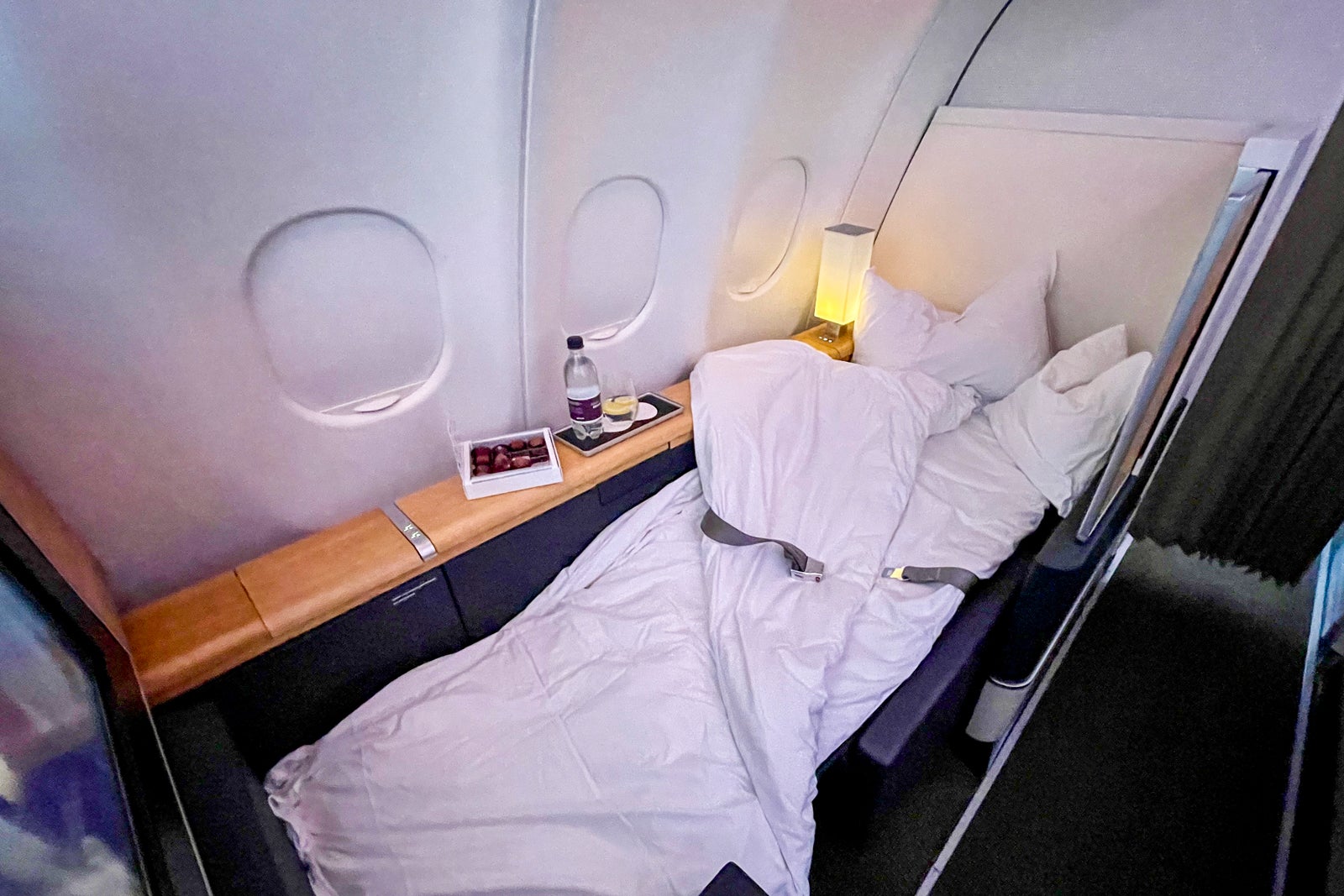
Amenities in Swiss first class
One of the other areas that Swiss' 777s and A340s beat out the A330 is that their first-class entertainment screens, which are fixed into place on the preceding seatback or bulkhead, are 32 inches, while those on the A330 are just 23 inches diagonally. Even if it were a touchscreen, the suite is too large for you to be able to reach it.
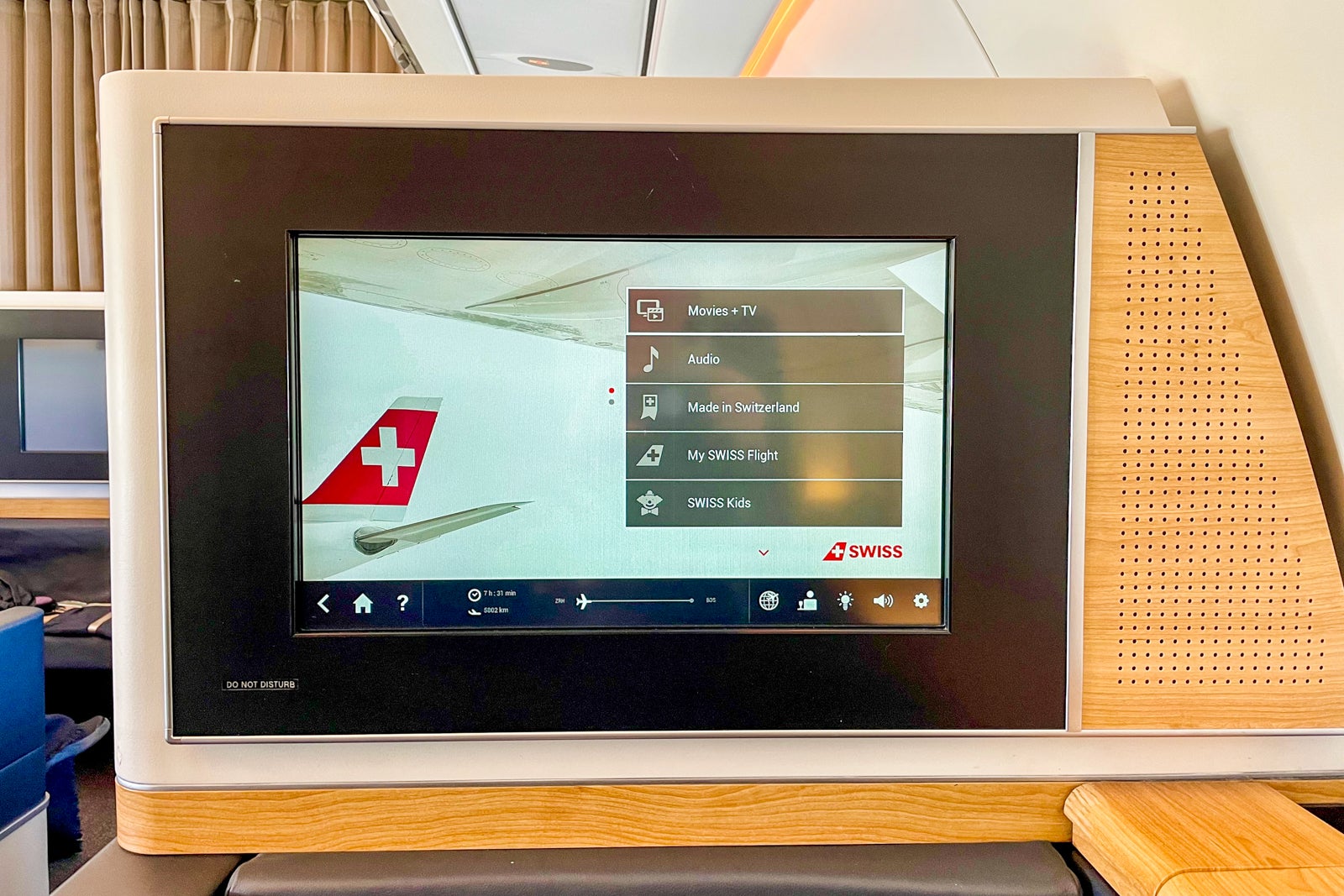
While you can choose from over 200 movies and 250 TV shows , I found the entertainment selection lacking. The new release movies were three to 12 months old, and there were only seven TV series each in the comedy and drama genres, all of which were relatively unknown.
The noise-canceling headphones looked basic but were quite effective and comfortable.
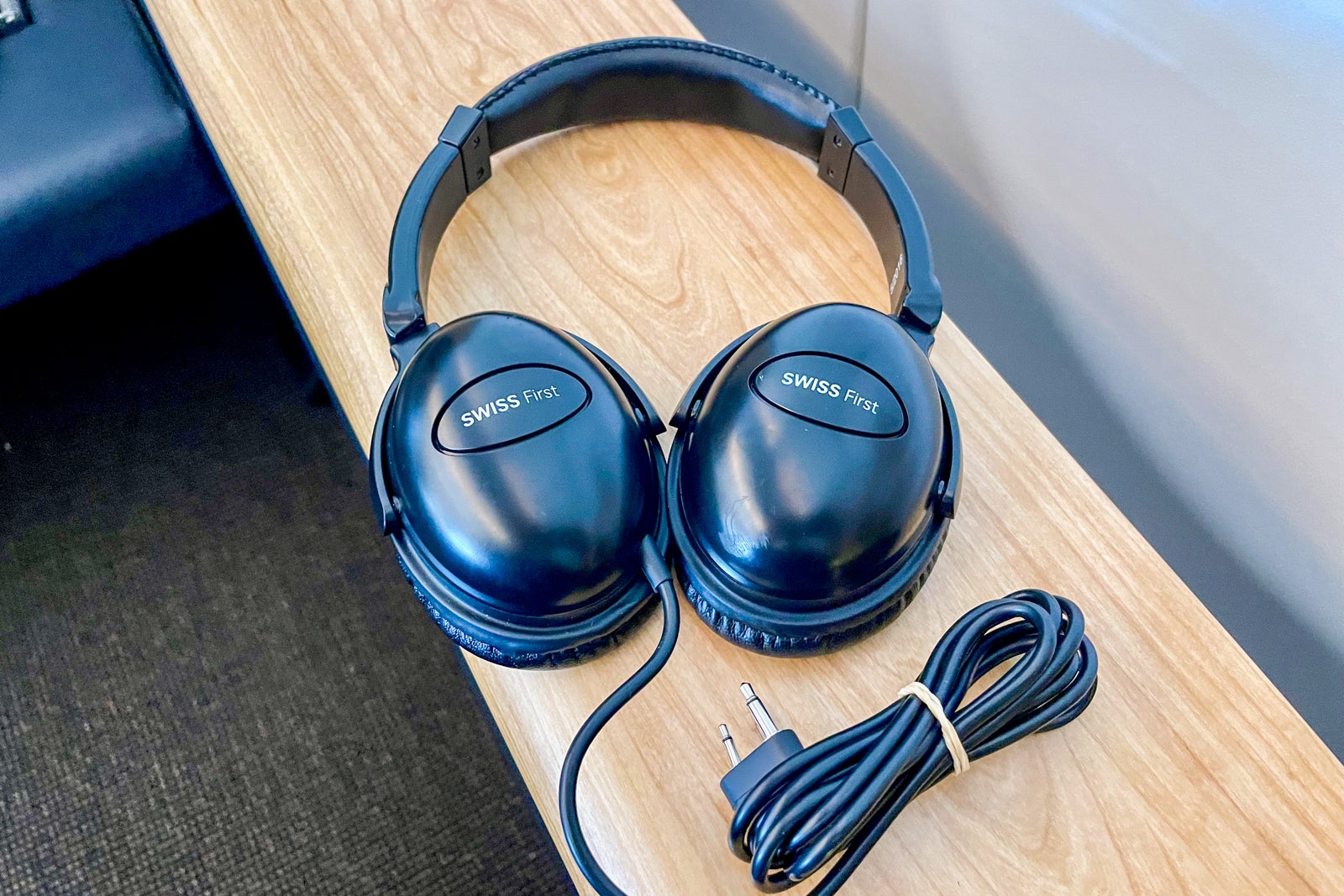
When flying first class, I would expect to find a premium remote control with a touchscreen; in this case, it was the same as you might find in economy, with a few simple buttons. It was located in a small side compartment next to the easy-to-use seat controls, an AC power outlet and a USB-A charging port.
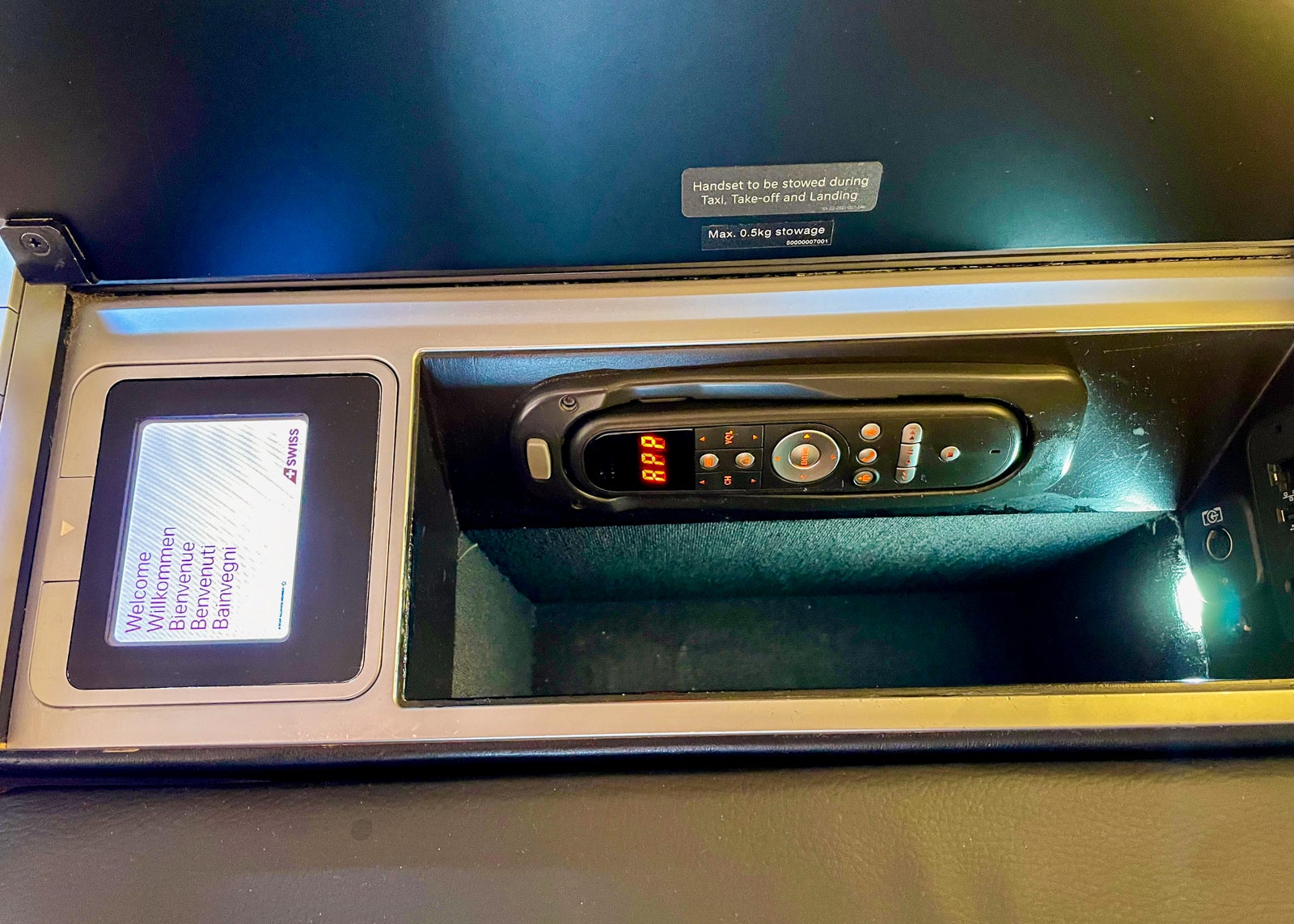
I loved the Zimmerli of Switzerland-branded pajamas featuring a classic design and a red accent button that the cabin crew handed out shortly after boarding. I've worn these several times since returning home. They came with a pair of slippers to use as well.
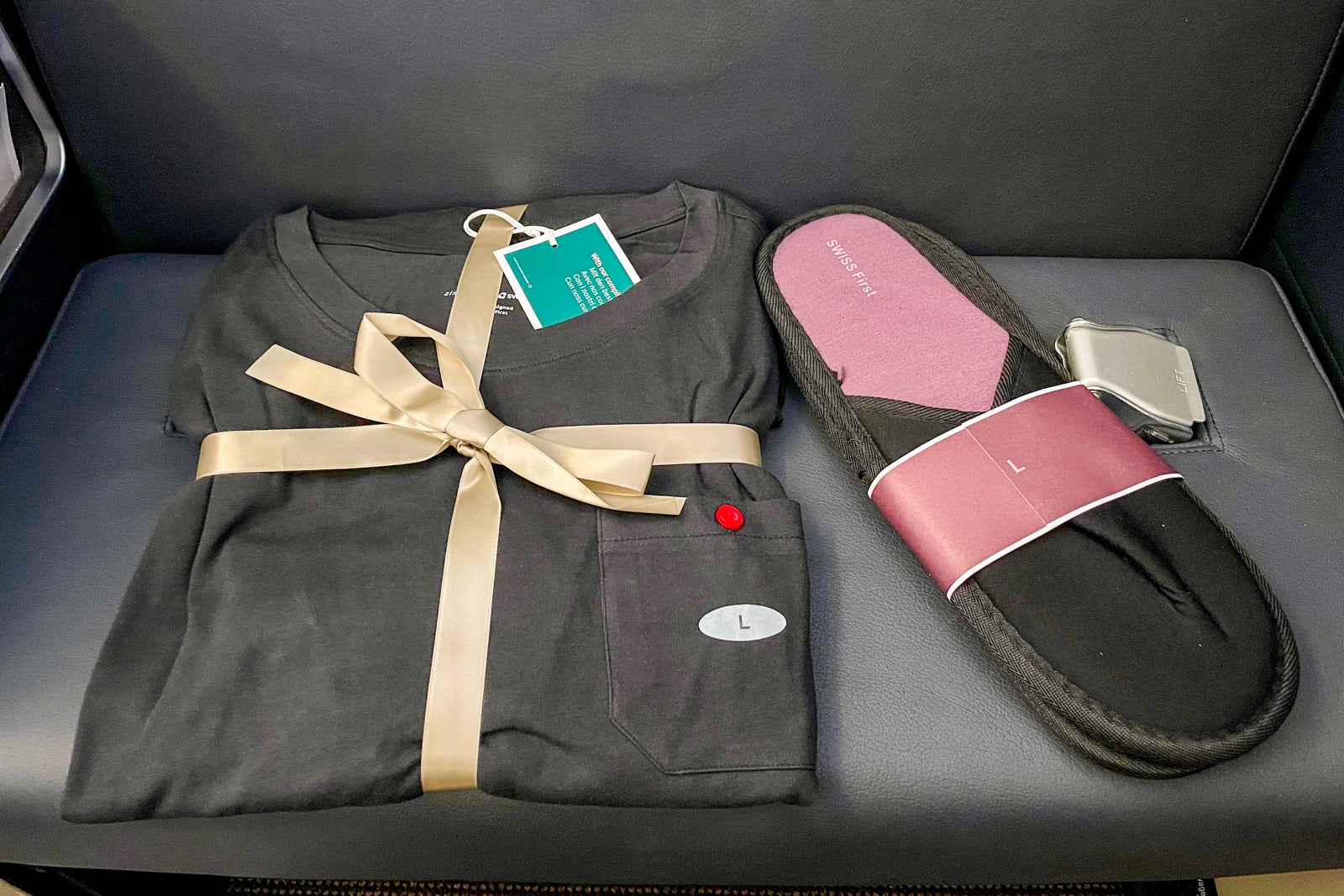
The amenity kit by luxury fashion brand Bally is decked out with Soeder cosmetics, toothpaste and a toothbrush, socks, earplugs and tissues. I appreciated the Swiss touch with the inclusion of Ricola throat-relief drops.
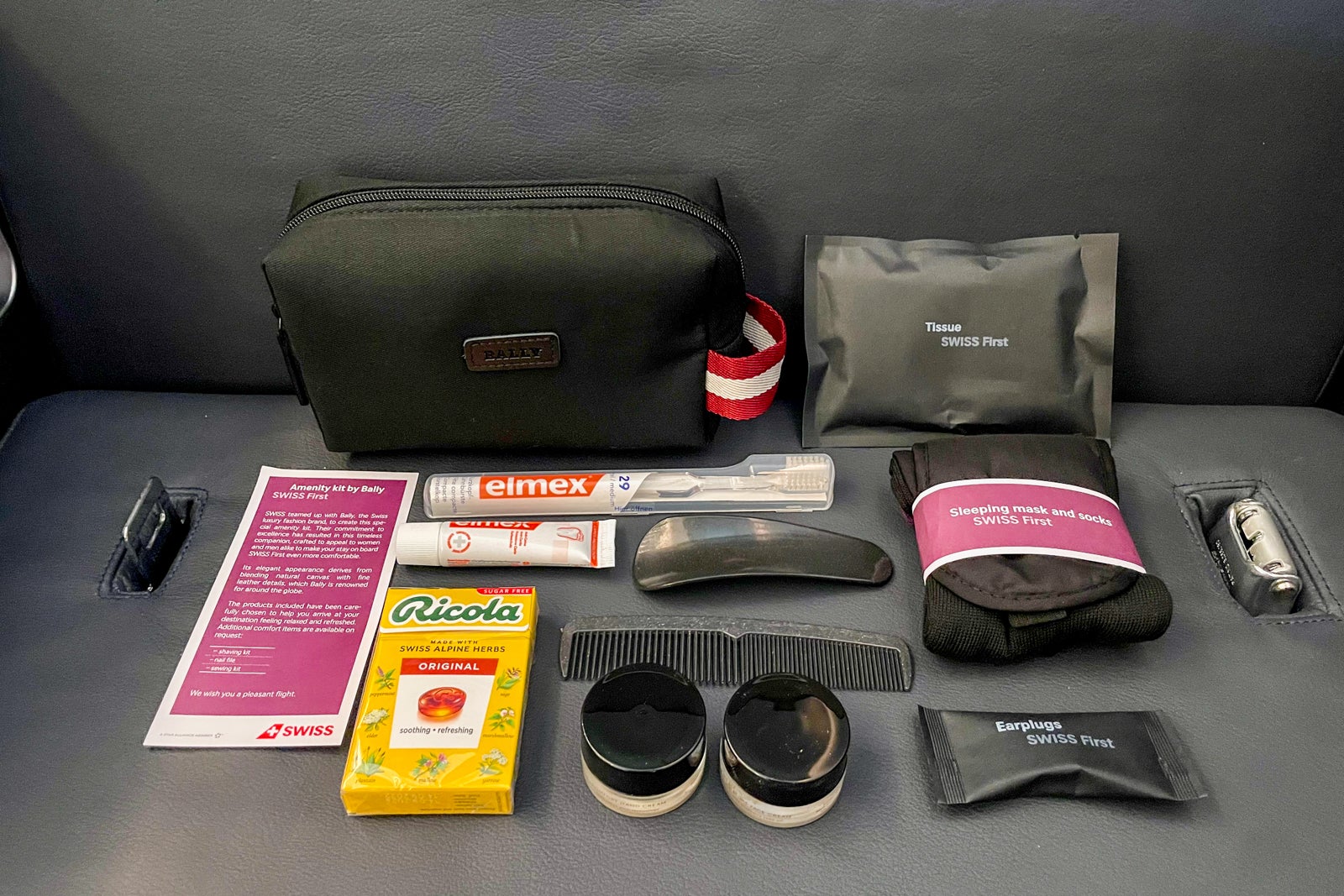
The A330 has only one small bathroom, the same size you'd find in economy, located at the very front of the cabin. This differs from Swiss' Boeing 777s, which have two bathrooms, one being larger than the other.
Despite the lack of restroom options, I did like that there were reusable towels instead of paper ones. You'll also find Soeder hand cream, soap and facial spray inside the space.
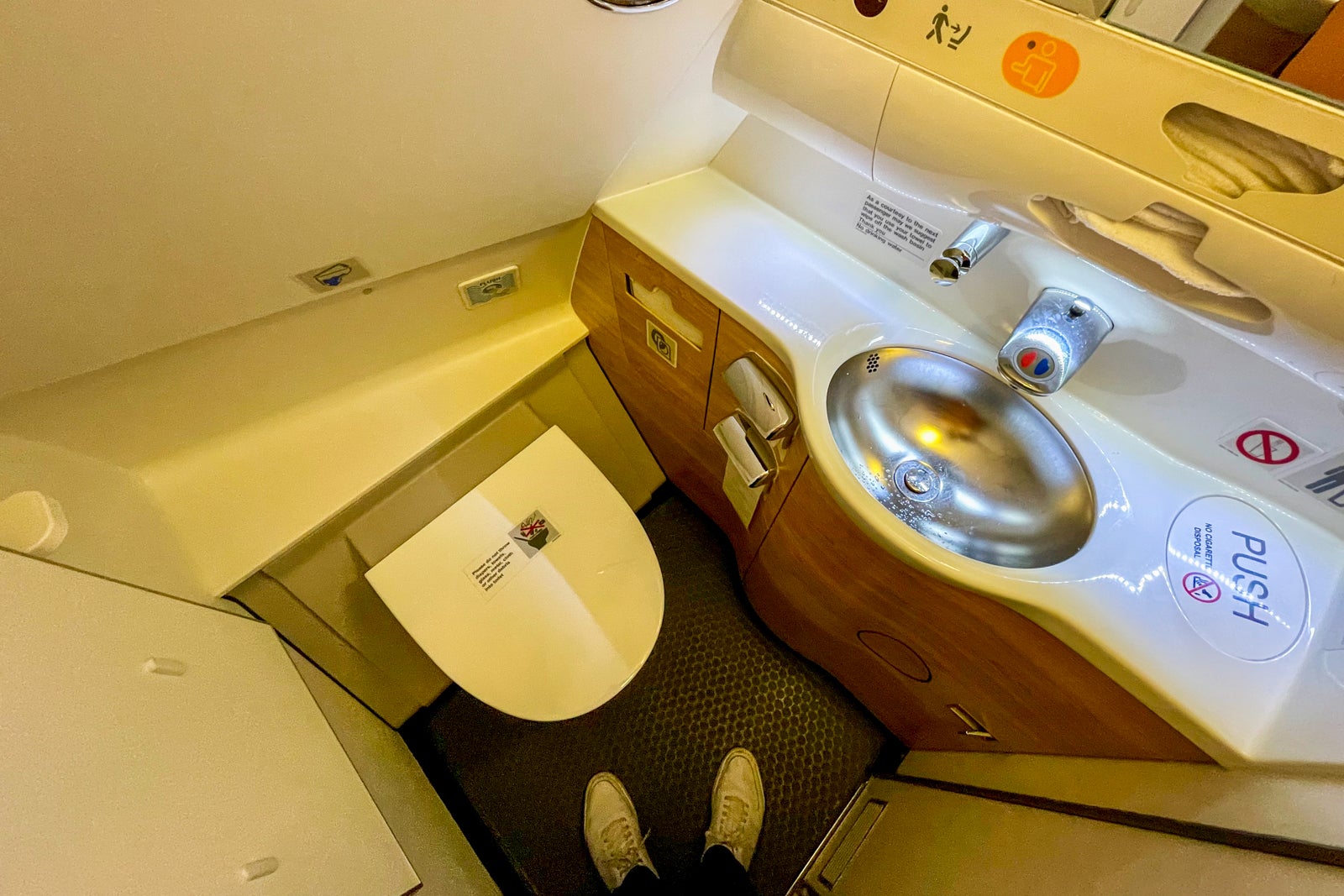
First-class passengers get unlimited complimentary Wi-Fi as well. I clocked 10 Mbps download and 3 Mbps upload speeds. If you want to switch between devices, you must register an account.
How was the food in Swiss first class?
Upon boarding, I was served a glass of crisp Laurent-Perrier Grand Siecle Champagne, two Lindt chocolates and a small bowl of warmed cashew nuts with basil — what a great welcome.
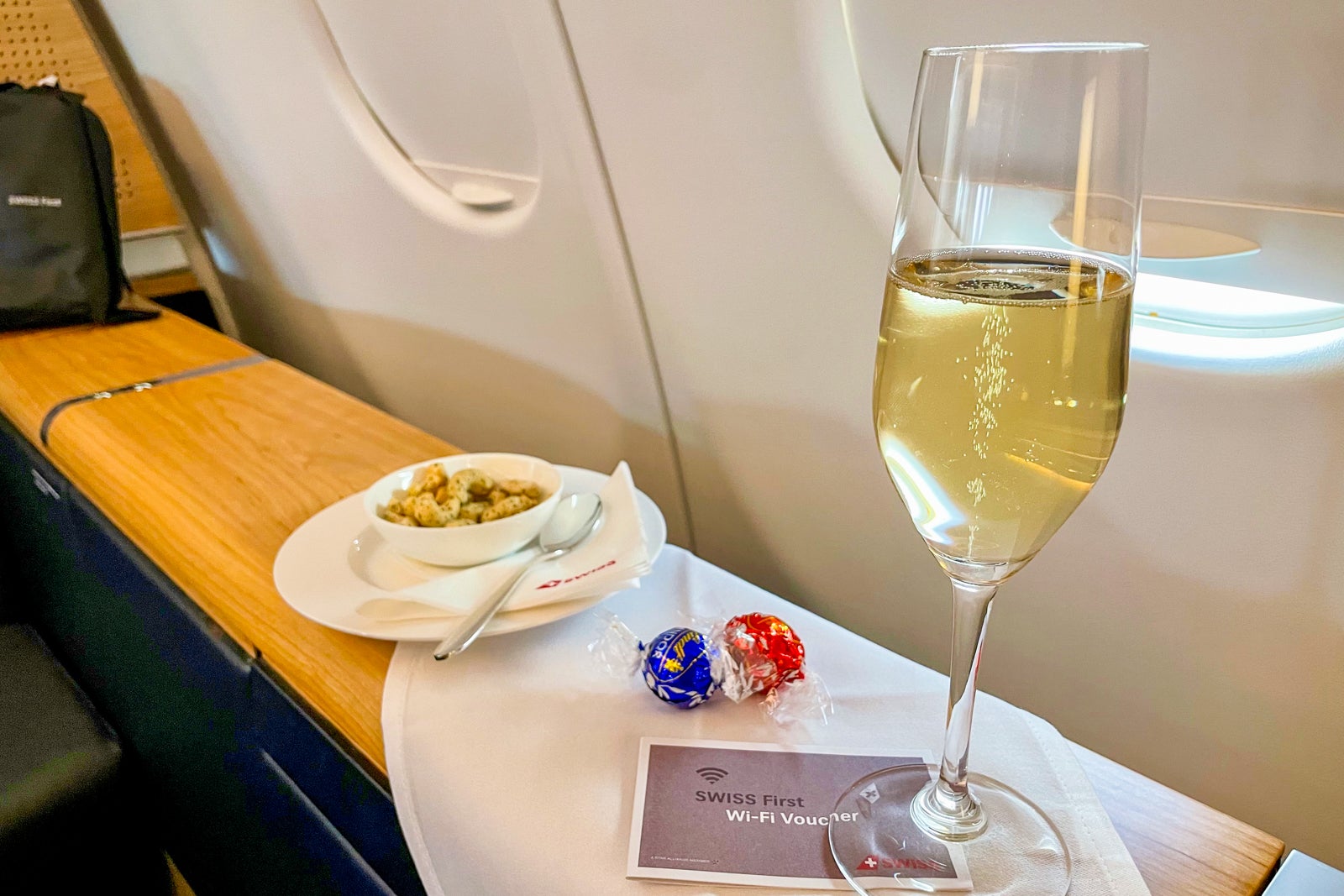
I was then presented with what I assumed were the full food and beverage menus, but I found out later on that there was a separate prelanding meal menu that would be distributed later in the flight. It's a minor quibble, but I would have appreciated having all my options at the start to better select my meals.
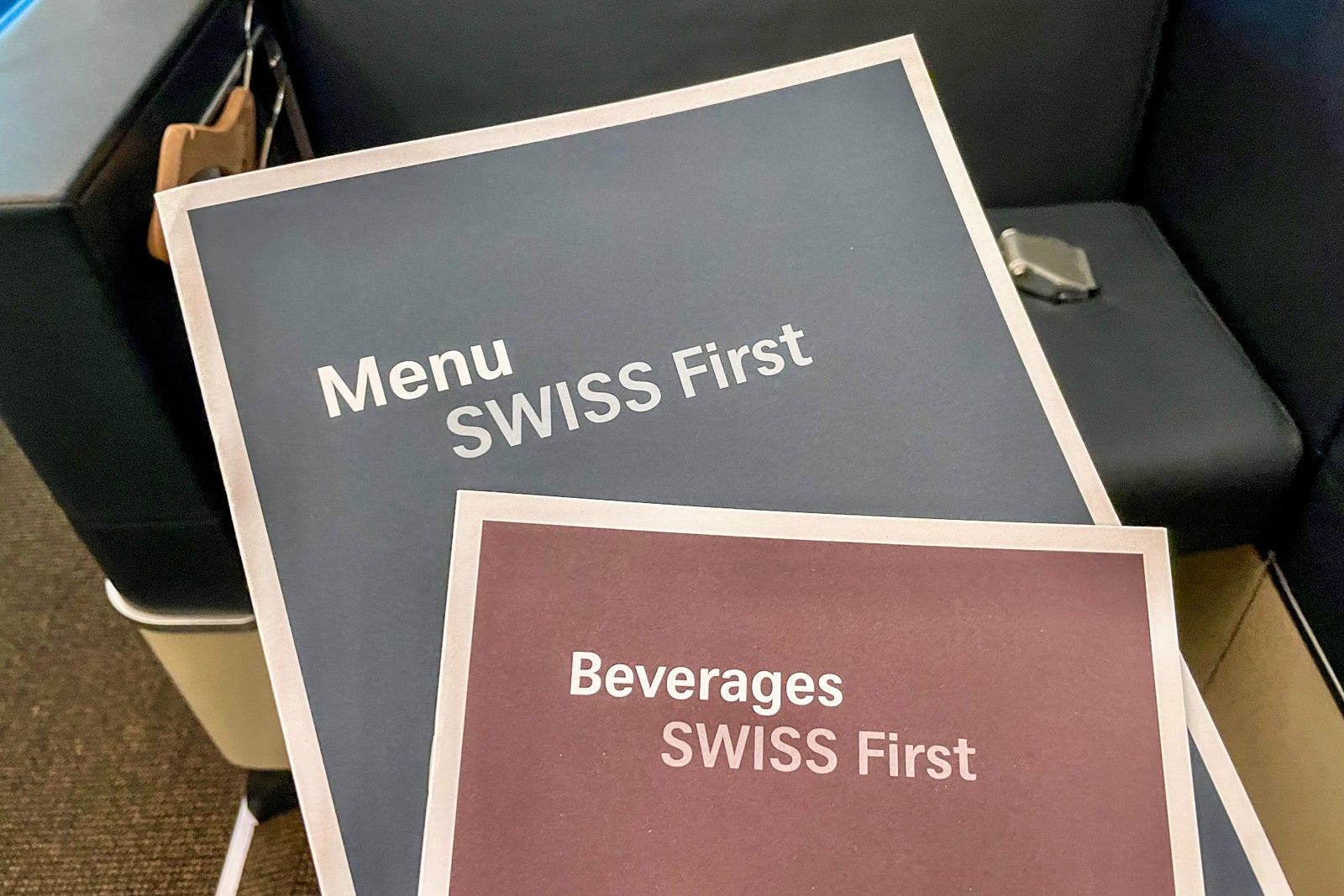
If flying Swiss first class, you can preorder your meals online up to 24 hours before departure . In my case, I was unable to do so because I was offered and accepted the upgrade to first class after check-in opened at the 24-hour mark.
On long-haul flights departing Zurich, you can choose the five-course, rotating "Taste of Switzerland" dining experience, which features regional and seasonal specialties accompanied by fine wines. You can also enjoy this menu in the Terminal E lounge before taking off.
Service in Swiss first class is dine-on-demand, and you can eat as much as you want whenever you want. On my flight, the appetizers were:
- Balik salmon fillet
- Trout tartare caviar
- Meat sampling platter
- Endive salad with preserved pear and roasted walnuts
- Lobster bisque with ricotta gnocchi
For the main, you could choose from:
- Veal fillet with truffle sauce
- Chicken breast with herb sauce
- Miso-marinated perch with port wine sauce
- Vegetable tikka masala
I chose four appetizers and a main, and service started quickly (just 10 minutes after takeoff). I felt like I was in a high-end dining establishment. The tableware and plating throughout the meal were set out perfectly, and I enjoyed the bread basket with warm white, multigrain and whole-wheat rolls accompanied by creamy butter.
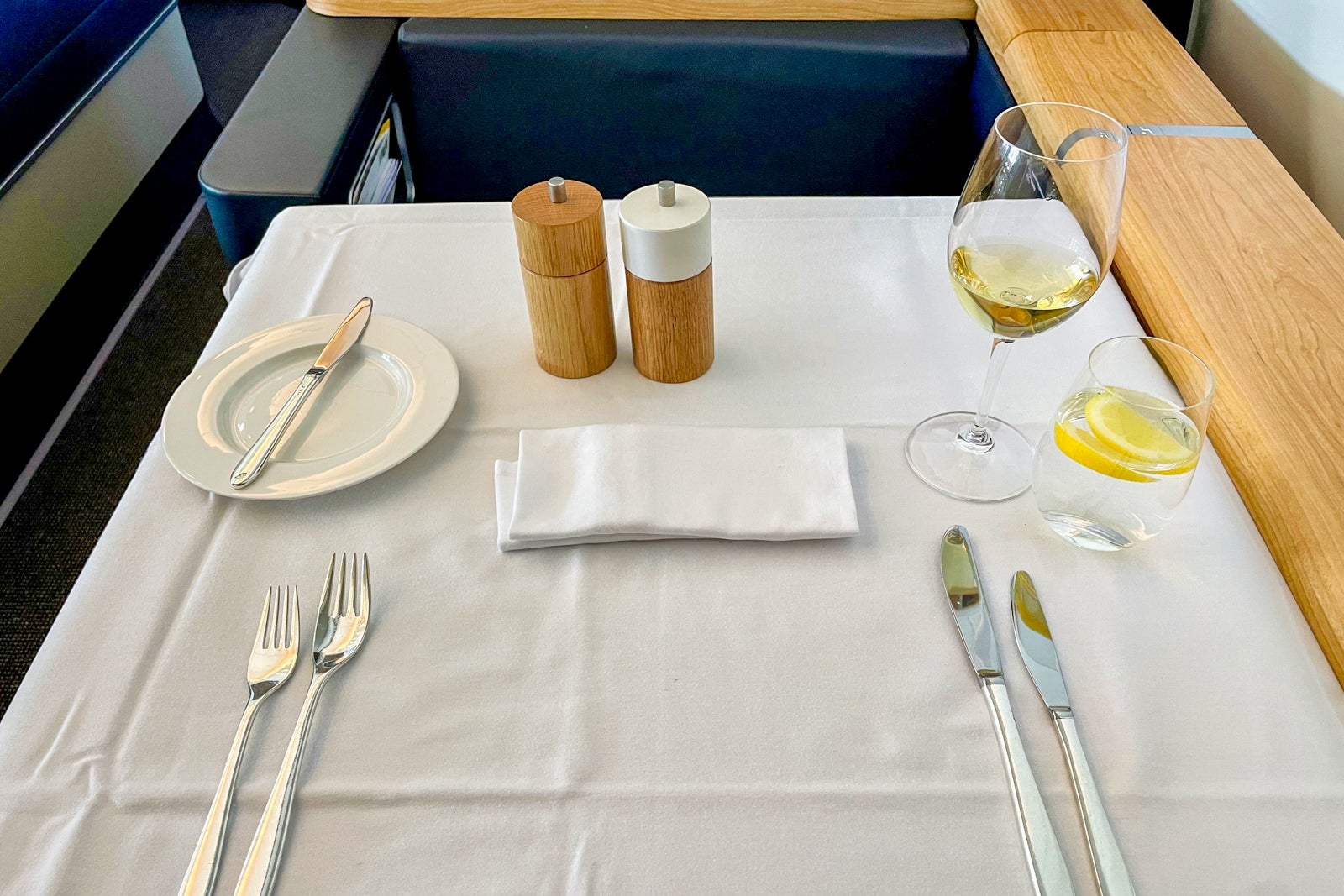
Next was a delectable amuse bouche of pumpkin cream soup with toasted bread, followed by the incredibly rich salmon sashimi with trout caviar, a light frisee salad with pears and the impeccably presented creamy lobster bisque, which the photo does not do justice.
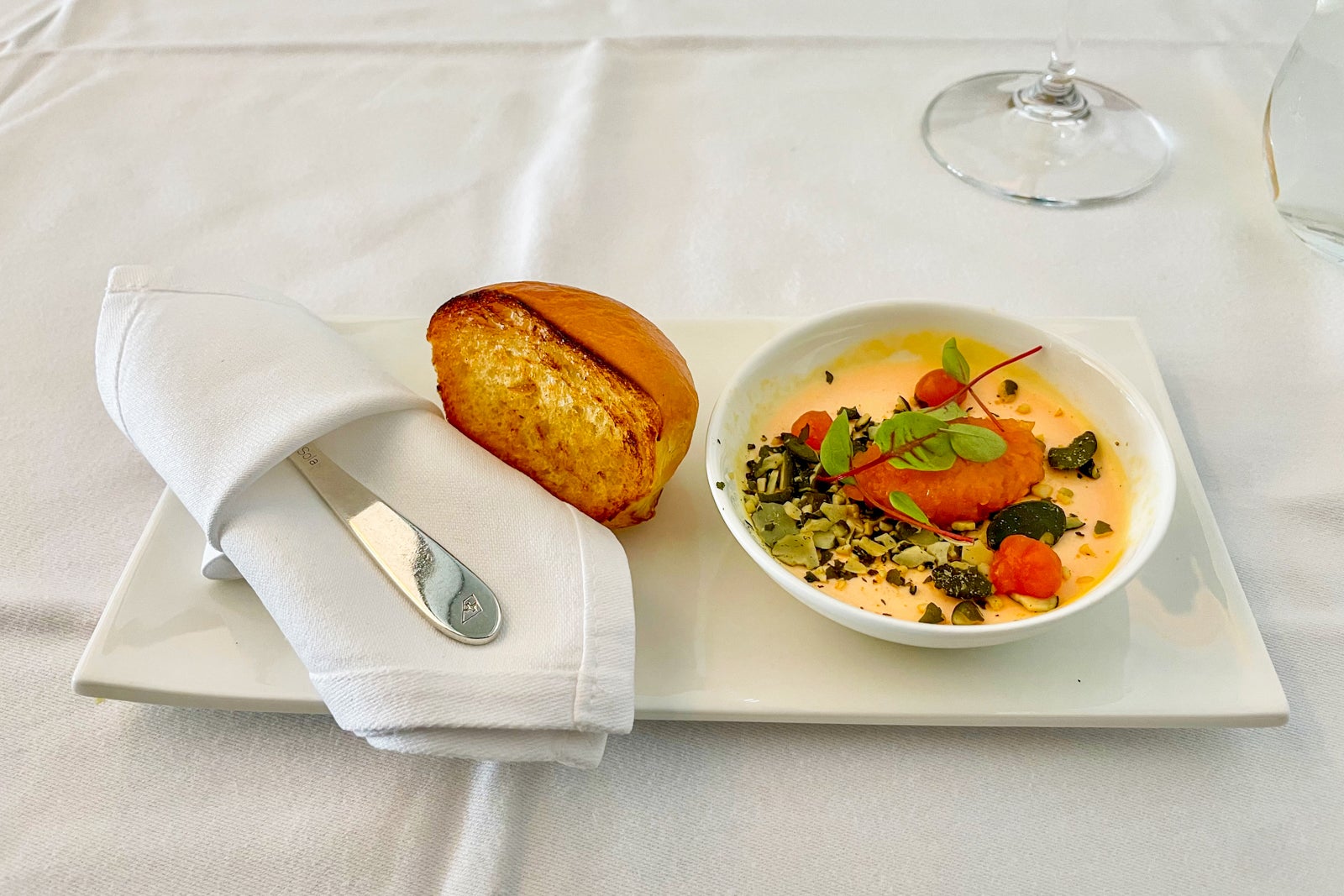
The only downside to my meal was the vegetarian tikka masala, which lacked protein and flavor.
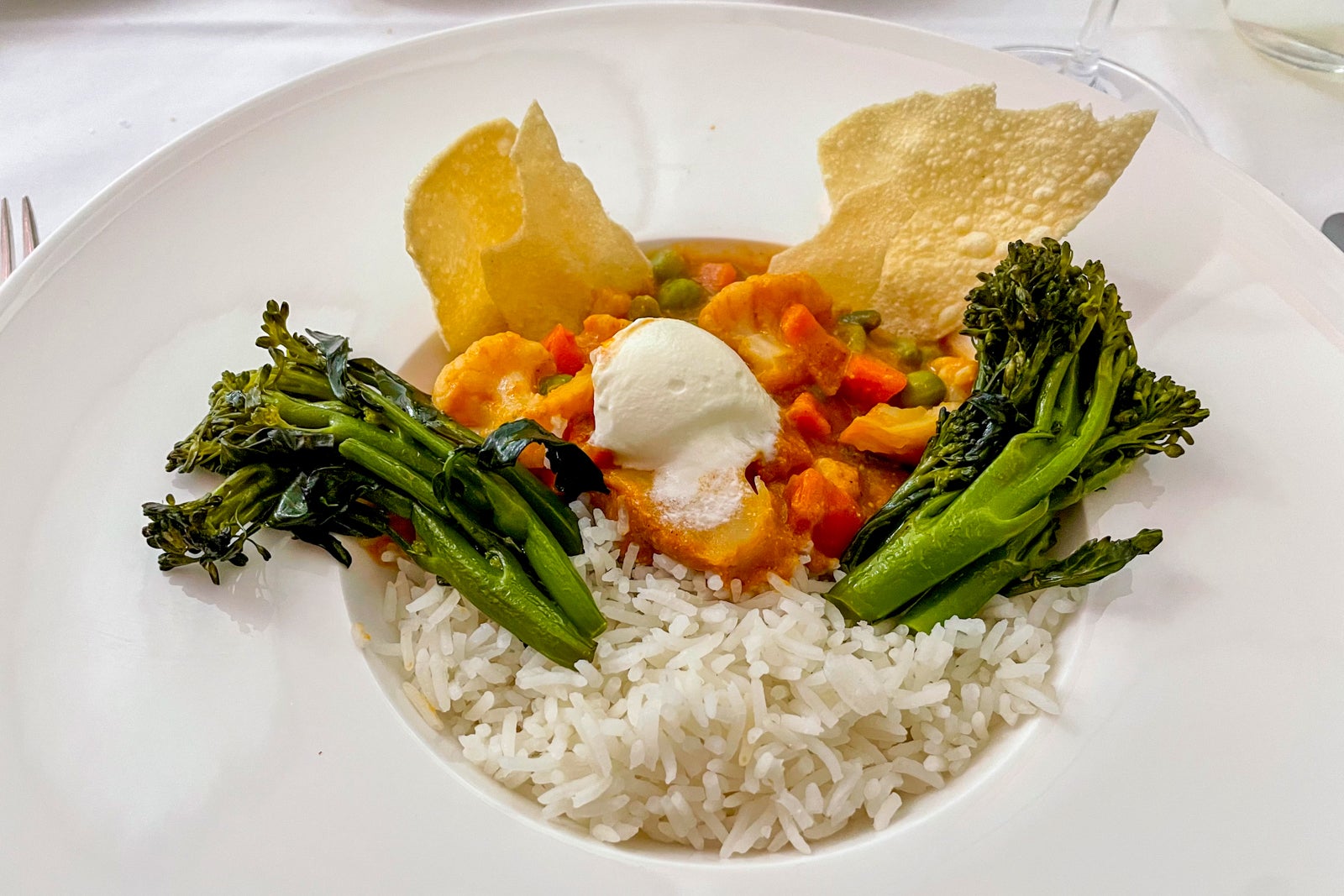
My main was followed by an artisanal Swiss cheese board and a delicious toasted hazelnut chocolate slice with Tahitian vanilla ice cream.
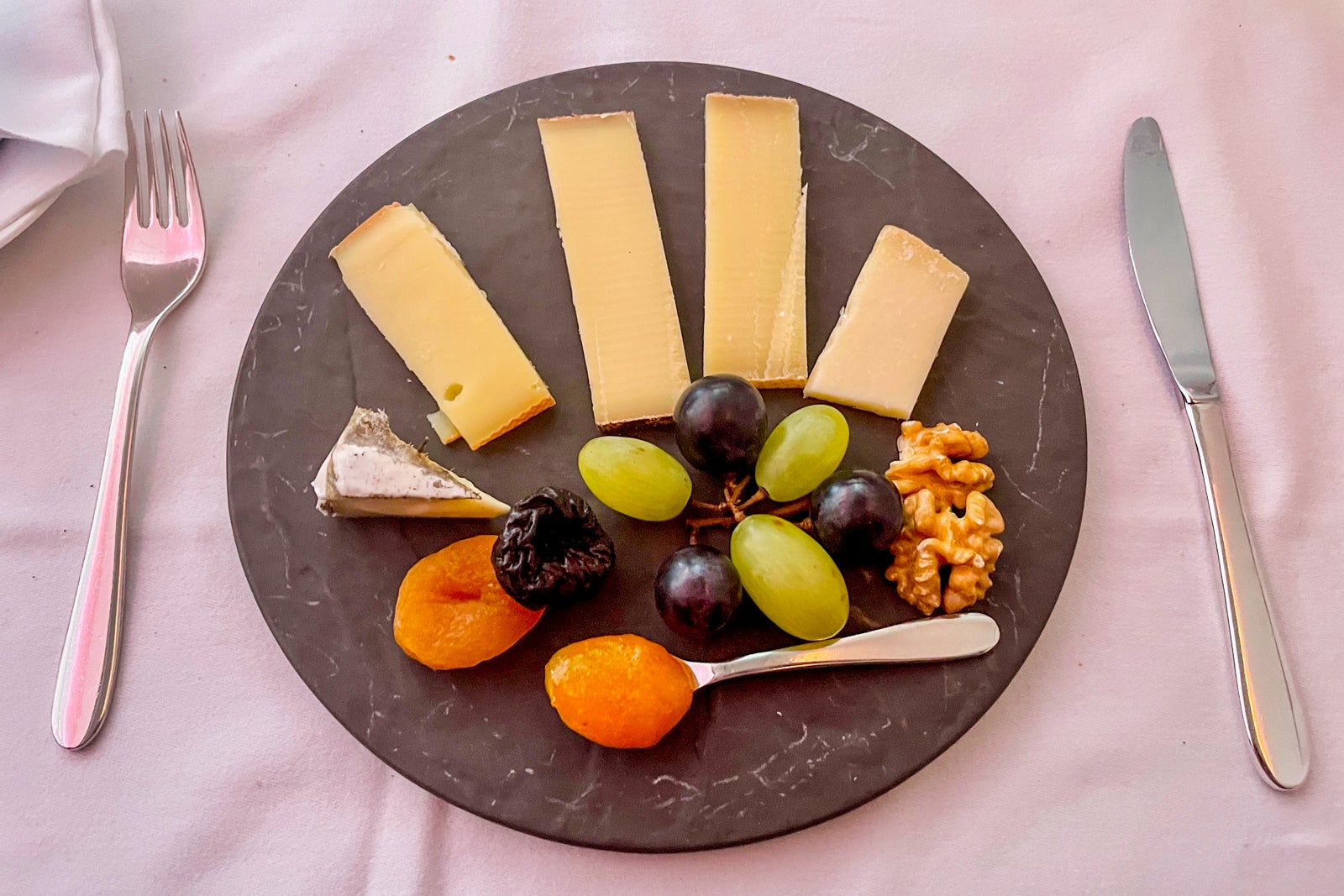
Finally, I made room to sample a couple of the offerings from the Swiss chocolate box that the crew left by my bedside.

I asked the crew to pair wines with my dishes, starting with a juicy Chablais from Swiss winery Château Maison Blanche for my appetizers and finishing with a spicy gamaret red from Domaine les Hutins near Geneva to pair with the cheeses and dessert.
After a nap, I ordered some potato chips and Movenpick vanilla ice cream from the midflight snack menu — nothing of note, but a little treat.
Then, a lighter meal was served 90 minutes before touchdown. I chose a delicious leek-and-cheese quiche with a green side salad and a berry pastry with fruit accompaniment.
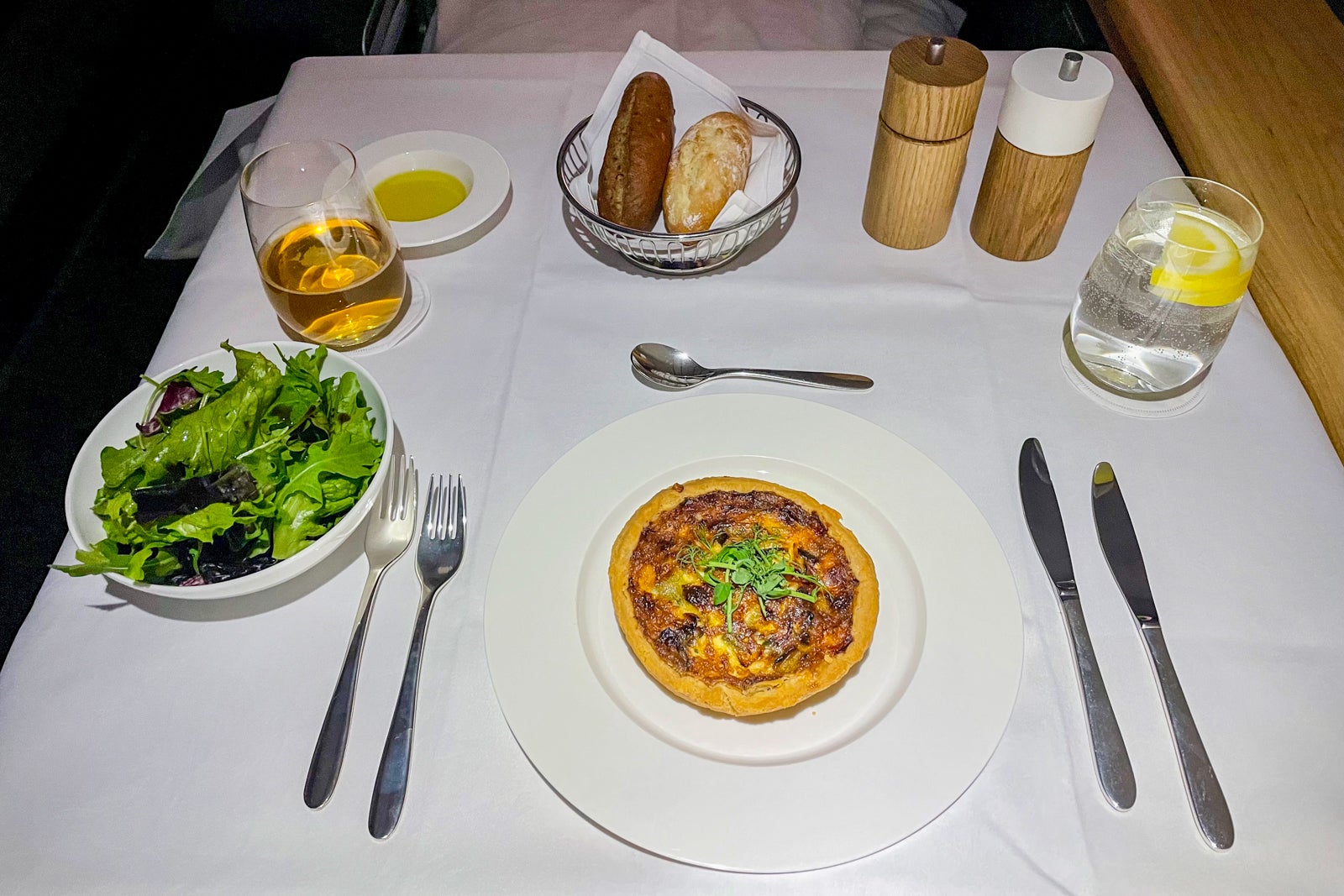
Overall, I absolutely stuffed myself with food in the lounge and with two meals on board. However, I was impressed by everything (except the tikka masala), and my only regret is not having more than eight hours to continue to enjoy the offerings.
How was the service in Swiss first class?
From check-in to deplaning, I found almost every Swiss employee who helped me to be warm and professional. I appreciated the cabin crew proactively offering to pair wines, bringing me chocolates, making my bed and asking whether I wanted to be woken up for my prearrival meal. They also responded quickly to the few times I pressed the attendant button for an extra water bottle or a snack.
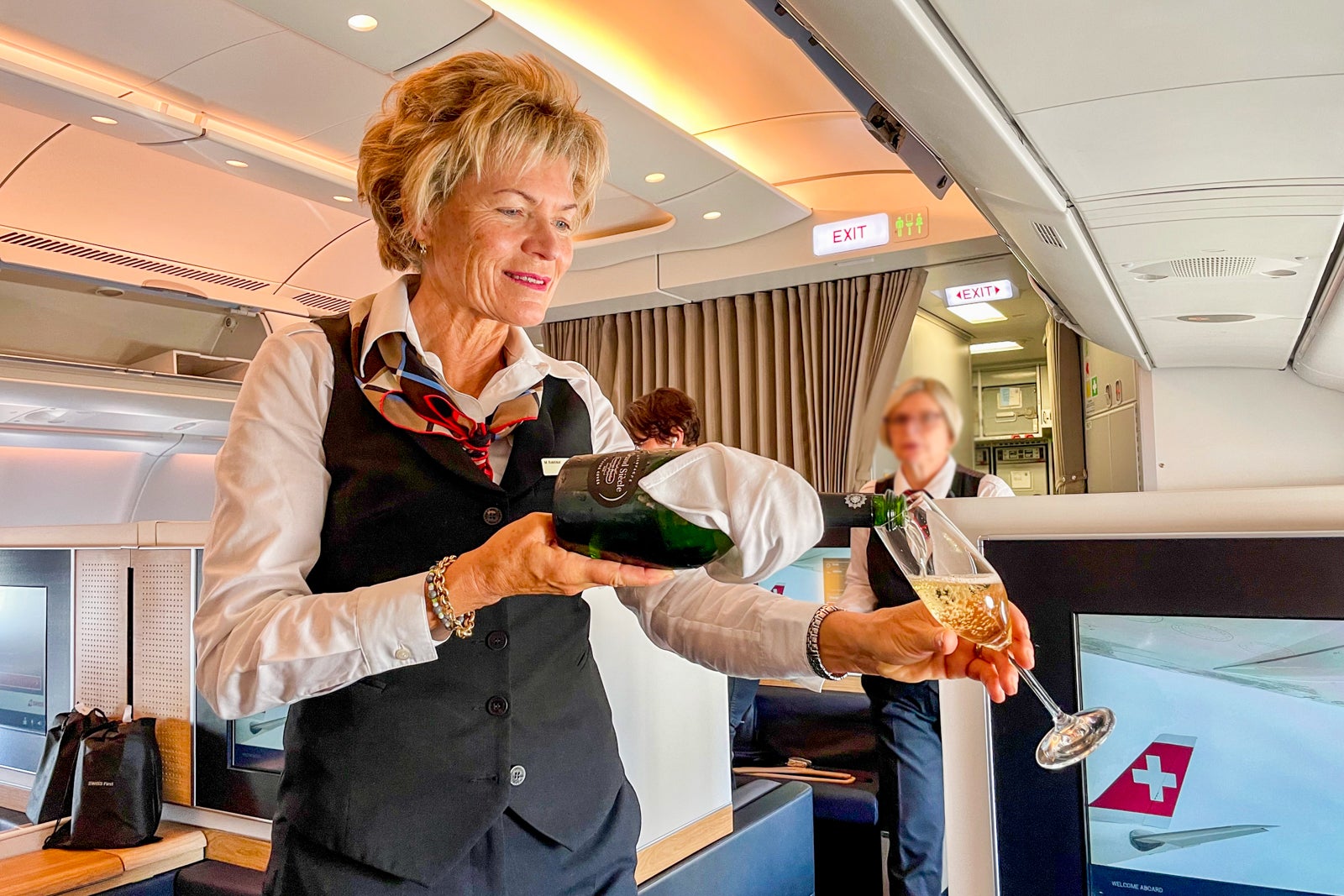
The only service downside I'd note was that the pilot did not come through to greet each first-class passenger, as other reports say can occur on Swiss flights. But since we were delayed departing Zurich, perhaps that was the reason that did not happen on this flight.
The purser rushed through the cabin 15 minutes before landing to thank each passenger for flying with them. It felt impersonal for a crew member with whom I'd had no interaction during the flight to ask me how the flight was. It would have been more intimate for either the purser to have greeted passengers upon boarding or after takeoff or for one of the crew members working the first-class cabin to deliver a farewell message.
Was upgrading to Swiss first class worth it?
This is the million-dollar — or, more accurately, the $1,000 to $2,000 — question. My answer is: It depends on your financial capacity, how much you value a premium flying experience and what flight you are on.
If flying Swiss first class is on your bucket list — as it was on mine — and you're offered an upgrade, I'd recommend taking it. This is a highly aspirational product available to very few frequent flyers and is a significant upgrade over the airline's business-class seats and amenities. In short, it's a once-in-a-lifetime opportunity.
Upgrading makes sense particularly when departing or connecting through Zurich, as you'll enjoy the over-the-top ground experience with a private transfer across the tarmac, a stunning open-air terrace and doting customer service. Even though I arrived at the airport three hours before departure, I wish I'd had even more time in the Terminal E lounge to enjoy a drink on the terrace and shower before boarding.
However, I would be less enthusiastic about paying for an upgrade on overnight flights departing the U.S. to Switzerland. In business class, you might already be able to access a United Polaris lounge (depending on your departure airport) and have a lie-flat seat to snooze for a good chunk of the flight, just as you would in first class. But if the price is closer to $1,000 — or if you're willing to splurge closer to $2,000 — then what you'll get is a more spacious seat, plusher bedding and someone to greet you upon arrival in Zurich, which might be handy during transfers.
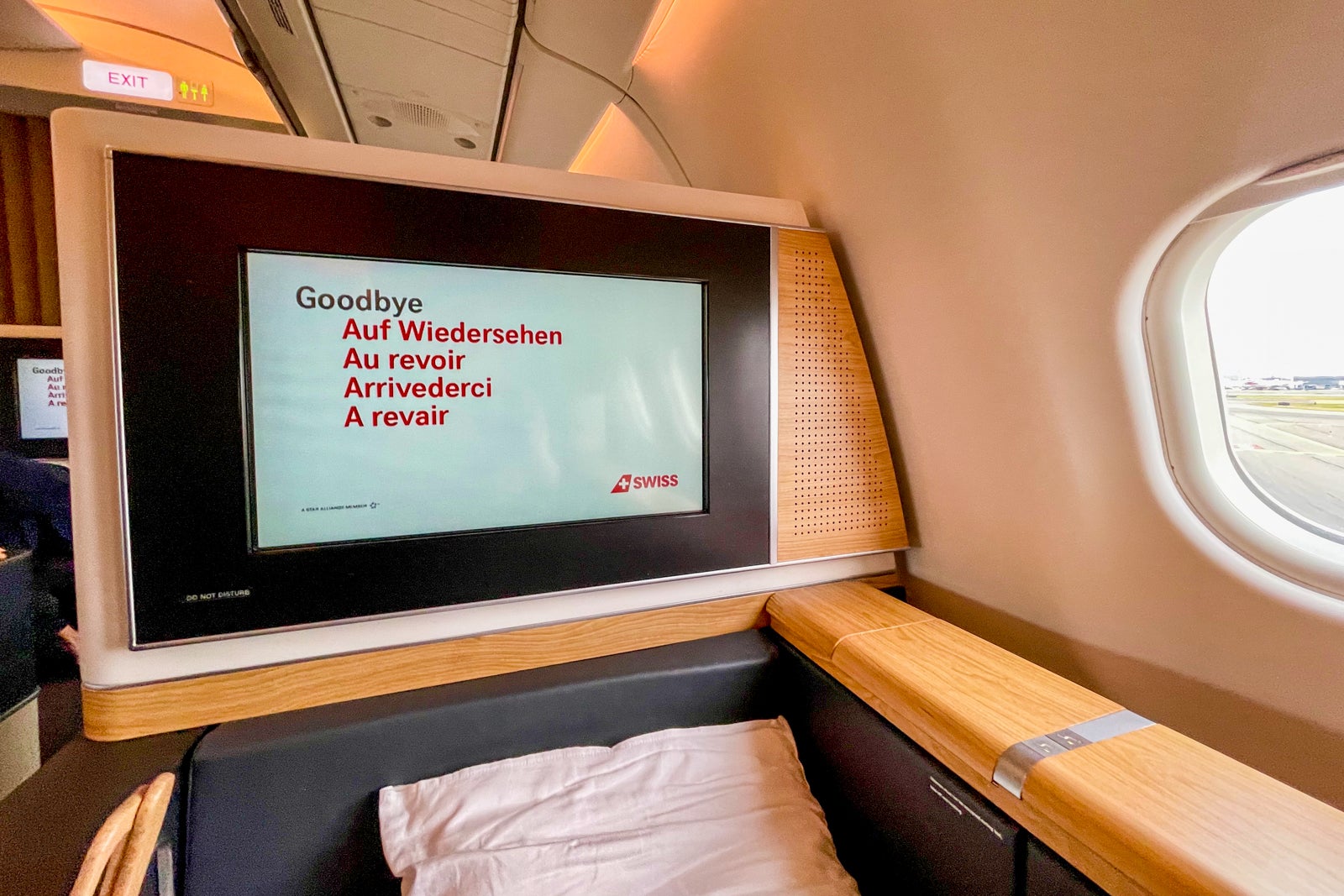
All in all, I'm thrilled I got to access an experience I don't have the cash to pay full fare for. As we descended into Boston, my only thought was that the flight wasn't nearly long enough to thoroughly enjoy everything it had to offer. Here's hoping that the next time I'm flying Swiss business class, I get offered an upgrade; if it's closer to $1,000 rather than the almost $2,000 I paid, that would definitely sway me toward saying yes to treating myself to this experience once again.
- Go to navigation
- Go to main content
- Go to search
- Go to footer
Main content
SWISS First
As a First Class passenger, you will enjoy the highest possible level of comfort. Take off relaxed, travel in comfort and land feeling refreshed. And only when you feel completely satisfied will we have done our job.
Your SWISS First experience
Enjoy a refined ambiance, personalized service, and first-class products on board. Our first-class compartments can be customized according to your wishes and offer you the largest possible freedom.
Travel in comfort
Eight First Class armchairs are available on long-haul flights. The armchairs turn into generous flat beds in moments. Enjoy your private sphere and the individual service.
First-class dining
You decide when we may serve you your gourmet menu. On long-haul flights from Zurich, you will enjoy the SWISS Taste of Switzerland: culinary highlights accompanied by fine wines.
Best entertainment
Let us entertain you on board with the latest films, games and a selection of excellent magazines. Including the SWISS Universe magazine, just for passengers in Business and First Class.
Wait in comfort
Your SWISS First Service benefits begin even before you take off. There is a separate check-in desk at the terminal just for you, so your trip gets off to a pleasant start without long waiting periods.
Priority Check-in and Boarding
Spend the time before your departure in the exclusive SWISS and Star Alliance lounges. In Zurich, we offer you an exquisite menu as well as private day rooms and meeting rooms.
Plenty of baggage
As a First Class passenger, you can take plenty of hand baggage (2 x 8 kg) and checked baggage (3 x 32 kg) with you on your travels. And once you are at your destination you will soon be ready to leave, as your baggage has priority and is processed quickly.
Everything for your well-being
Various extras such as products by the Swiss luxury brand Soeder, a cover and pillow, and pyjamas by Zimmerli of Switzerland will ensure your personal well-being.
Your amenity kit

The Zimmerli × SWISS amenity kit comes in four designs and colours - rotating throughout the year - which reflect craftsmanship, shaped by tradition and exclusivity. The diverse designs further turn the amenity kits into collectibles. They include a wide selection of products from high-end Swiss brands, such as Rohner or VIU.
Miles & More is the biggest frequent flyer programme in Europe. Earn miles on all your flights, and enjoy greater comforts and more advantages when you travel as a member.
Awarded First Class Service

SWISS has been awarded first place in the category "Europe's Leading Airline – First Class 2024" at the 2024 World Travel Awards. In SWISS First, guests enjoy the highest level of comfort from check-in to arrival. We are the only airline to offer First Class on all long-haul flights.

Pre-select your SWISS First meal now
Decide up to 24 hours before your trip what culinary delights we may serve you during the flight.

Saffron Weeks: a golden touch on board SWISS First
From 22 May to 4 June, we invite SWISS First guests on a culinary adventure with our second Connoisseur Weeks of the year – available on all long-haul flights departing from Zurich and Geneva.
Make yourself comfortable
We treat you to the highest comfort in the nine SWISS lounges at Zurich Airport, whether before your departure, during a transfer or on arrival.
Welcome to Zurich
SWISS First guests landing in Zurich benefit from an exclusive service in Zurich. Be welcomed at the aircraft door and let the SWISS First shuttle take you to the security and passport control with access to the SWISS First Lounge A or further to the baggage claim area.

COMMENTS
The Swiss Travel Pass has been developed for guests from abroad. It is available to persons permanently resident outside Switzerland and the Principality of Liechtenstein. For online purchasing, purchase as a "guest". You do not need a login. To receive the Swiss Family Card directly, add the child as a passenger under 'Add passengers ...
So, this section is probably the most important to you when you have a Swiss Travel Pass. The main differences between first and second-class trains in Switzerland are: Space - seats are bigger, and more spaced out. Comfort - seats are generally more plush & comfortable. Working - there is more space to work on a table with power outlets ...
Likewise, if you need a pass for 23 days, you can buy a 15-day and an 8-day Swiss Travel Pass of CHF 459 and CHF 419 each. The cost per travel day is CHF 38.17. If you don't need to travel every single day, the 15-day Swiss Travel Pass Flex of CHF 479 allows you to travel for 15 days within one month.
2nd class seats are the standard way to travel in Switzerland. Swiss trains are comfortable and clean, so 2nd class is perfectly fine. 1st class is about 75% more expensive. For that, you get more spacious and more comfortable seats as well as larger windows. On average, there are fewer travelers in 1st class.
10/02/21 01:16 AM. 6884 posts. First class in Switzerland is indeed not about seat comfort and amenities, but only about crowding, which can be severe at peak times on main commuting and tourist routes. This being said, fares are already so high that it is very hard to justify splurging for 1st class for the full-country pass.
For foreign guests, the all-in-one ticket Swiss Travel Pass is the key to Switzerland's public transport network. Exploring Switzerland has never been easier! For foreign guests, the all-in-one ticket Swiss Travel Pass is the key to Switzerland's public transport network. ... 1st class: 3 days: CHF 244: CHF 389: 4 days: CHF 295: CHF 469: 6 ...
All Swiss Travel Passes. This single ticket enables visitors to explore Switzerland from end to end by train, bus and boat on 3, 4, 6, 8 or 15 consecutive days. With the Swiss Travel Pass Youth, young people up to their 25th birthday travelling through Switzerland benefit from a 30% discount off the regular Swiss Travel Pass ticket fare.
The Swiss Travel Pass entitles you to unlimited travel in Switzerland by train, bus or boat. The Swiss Travel Pass is available for 3, 4, 6, 8 or 15 consecutive days. Start date. Class. 2nd 1st. Validity. 3 Days 4 Days 6 Days 8 Days 15 Days.
Swiss Travel Pass: 3 Days: 1st Class - CHF 369 2nd Class - CHF 232: Buy Here: 4 Days: 1st Class - CHF 315 2nd Class - CHF 199: Buy Here: 6 Days: 1st Class - CHF 570 2nd Class - CHF 359: Buy Here: 8 Days: 1st Class - CHF 617 2nd Class - CHF 389: Buy Here: 15 Days: 1st Class - CHF 675 2nd Class - CHF 429:
Learn about train travel in Switzerland and whether you should buy the Swiss Travel Pass. ... Second Class: First Class: Three-day pass: CHF 232: CHF 369: Four-day pass: CHF 281: CHF 447: Eight-day pass: CHF 418: CHF 663: 15-day pass: CHF 513: CHF 810: Prices are shown in Swiss francs (CHF). Current conversion rate is CHF 1 is equal to $1.05.
A Swiss Travel Pass (continuous or flex) gives you unlimited free travel on all the train, bus & ferry routes shown as solid red, yellow or black lines on the map. Swiss Travel Passes give you a 50% discount (not free travel) on the routes shown as dotted red, yellow or black lines. One thing that confuses people: A solid line becomes a dashed ...
For 1st class Swiss travel pass holders/ half fare card holders, follow the below steps to make reservations for Gotthard Panorama Express: *For Swiss Travel Pass holders, please note that only 1st class pass holders can reserve Gotthard Panorama Express trains with additional seat reservation fees.
The value of a 1st class Swiss Travel Pass totally depends on your travel preferences and budget. Most Swiss trains on the Swiss Travel System network have 1st class carriages with have more spacious seating and comfier seats, and they're usually less busy than the 2nd class carriages, which means less noise. 1st class carriages usually have ...
Explore Switzerland with the Swiss Travel Pass, the most convenient and flexible way to travel by train, bus and boat. Book online and save with our affiliate discount.
Standard prices for a 2nd class adult Swiss Travel Pass Flex. Prices may slightly vary depending on where you buy. Scroll down for all purchase options. Discounts. Swiss Travel Pass Flex Youth: 30% off the pass price for youths/students up to and including 24.
Travel in peace in the 1st class quiet zone. In the quiet zone in 1st class, you can work and read in peace. Or simply sit back and enjoy the journey, as you relax and watch the countryside pass by the window. InterCity trains with quiet zones are marked with RZ in the online timetable and in the SBB Mobile app.
Easy answer. 2nd class is perfectly fine. Seconded, second class is perfectly adequate. Second class has 2+2 seating, first class has 2+1 and proportionally more legroom. That is the only difference. An 8-day Swiss Travel pass costs CHF 363 2nd class or CHF 581 1st class.
Swiss Travel Pass offers unlimited access on Swiss Travel System - train, bus, tram, & museums at discounted prices. Choose your Swiss Pass from 3,4,8,15 days. ... Type of First class. The First Class pass means a passenger can access the first-class sections of public transport like Train and Boat. In a train, the first-class seating is more ...
Normally, you expect to add 50% to 2nd class to get 1st or to deduct 33% from 1st class to get 2nd. In the case of Switzerland, if you start with 2nd-class rates, you add 58% to get 1st class on a Swiss Travel Pass or add 75% on a point-to-point ticket (e.g., Geneva-Zurich at either 89 or 156 chf).
Here you can enjoy the journey in greater comfort: more legroom, wider seats and power sockets at every seat. First class also offers quiet zones and business zones. So you can work undisturbed during your journey. Some of these advantages can also be enjoyed on boats. There, first class can usually be found on the upper deck. Links. 1st class
I redeemed 63,000 Avianca LifeMiles and paid $101 in taxes for a one-way business-class flight from Zurich to Boston in October 2023. When checking in online 24 hours before departure, I was offered an upgrade to first class for 1,680 Swiss francs (approximately $1,860), and I took it.
SWISS has been awarded first place in the category "Europe's Leading Airline - First Class 2024" at the 2024 World Travel Awards. In SWISS First, guests enjoy the highest level of comfort from check-in to arrival. We are the only airline to offer First Class on all long-haul flights. As a First Class passenger, you enjoy the best-possible ...
A last-minute first-class deal on Lufthansa, using frequent flier points, which he found during his trip. The layover in Frankfurt, featuring a chauffeur-driven ride from his plane to the airline ...